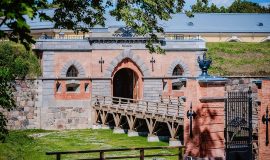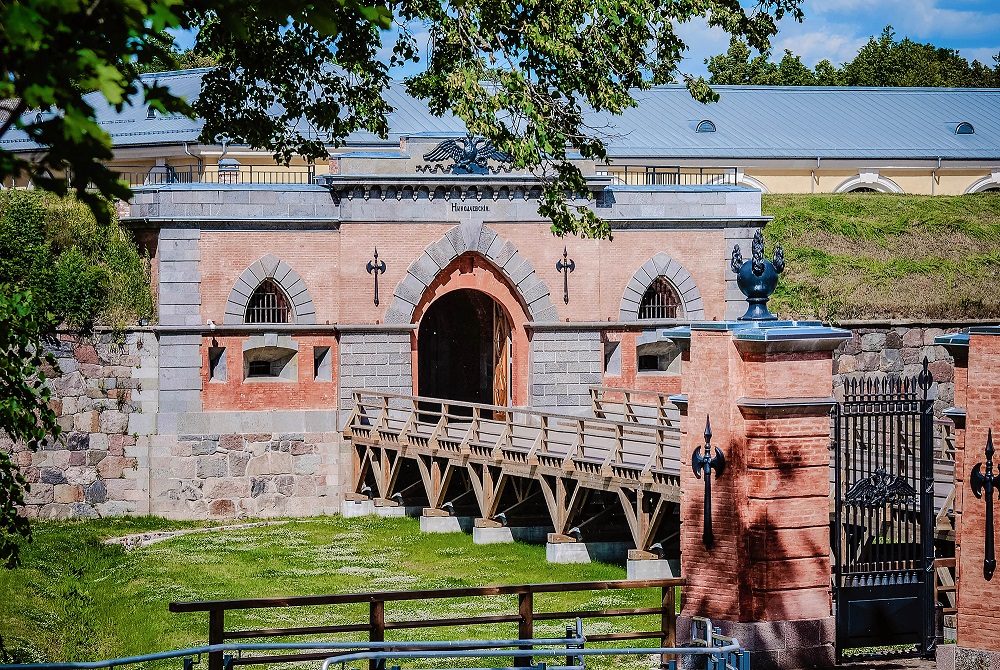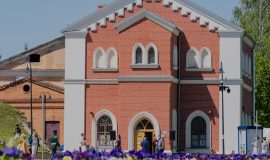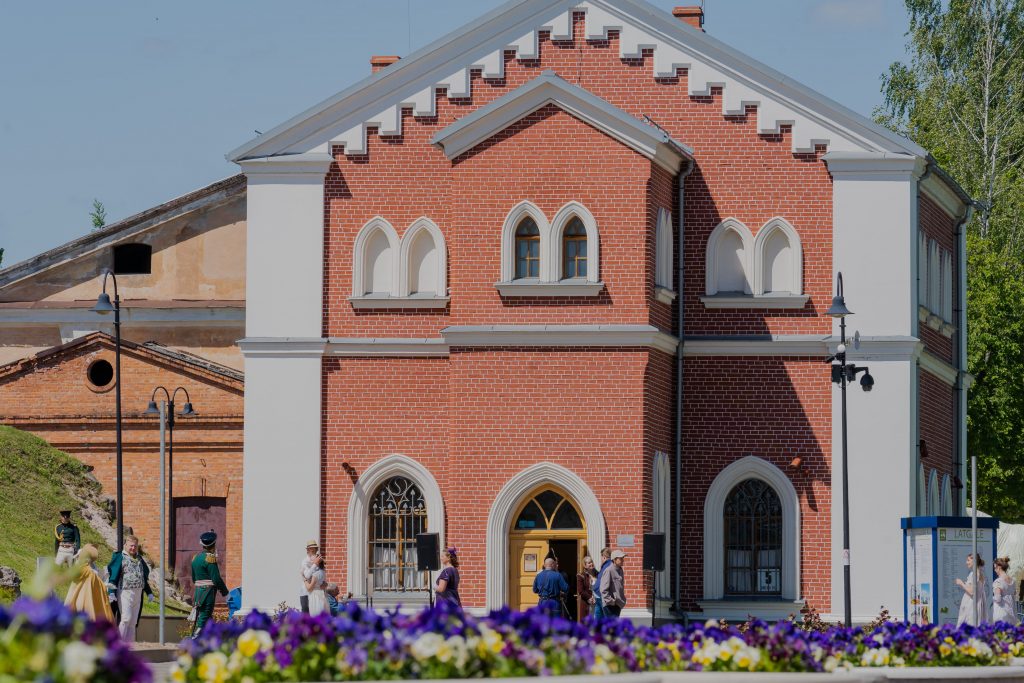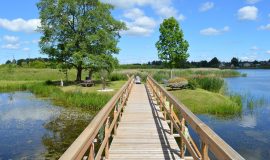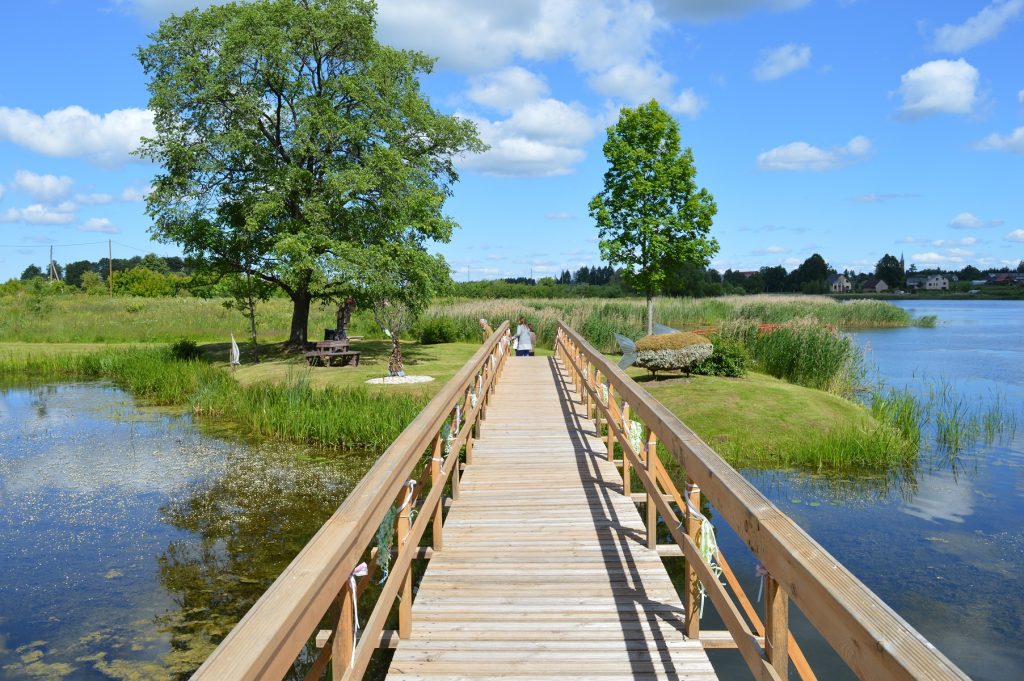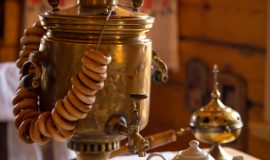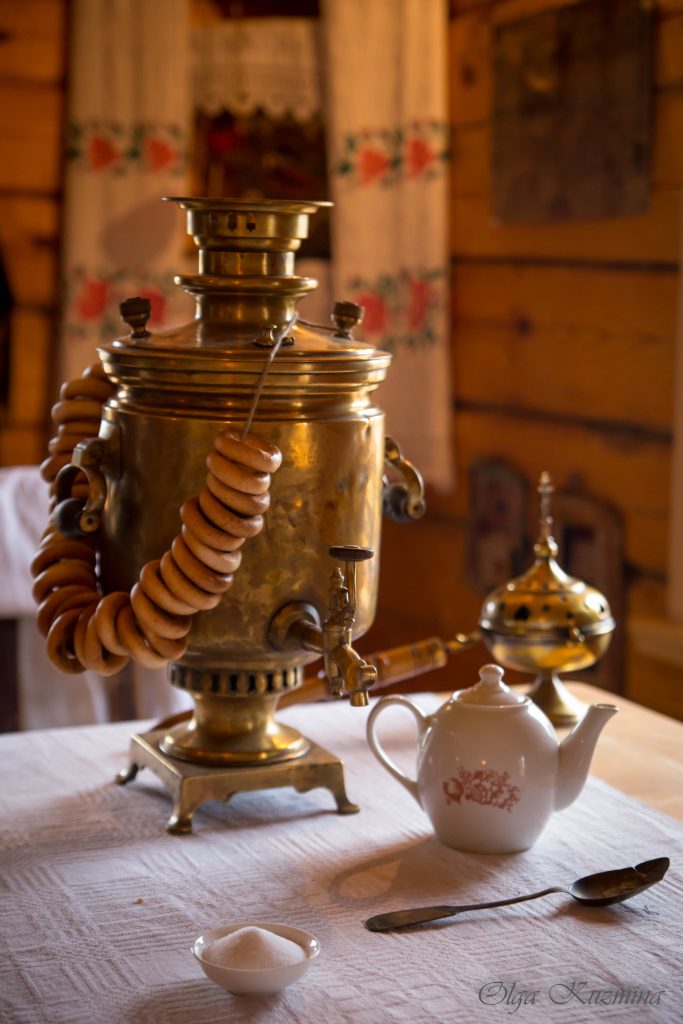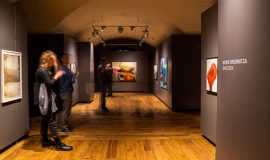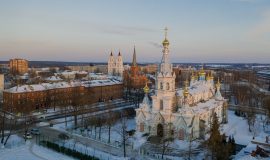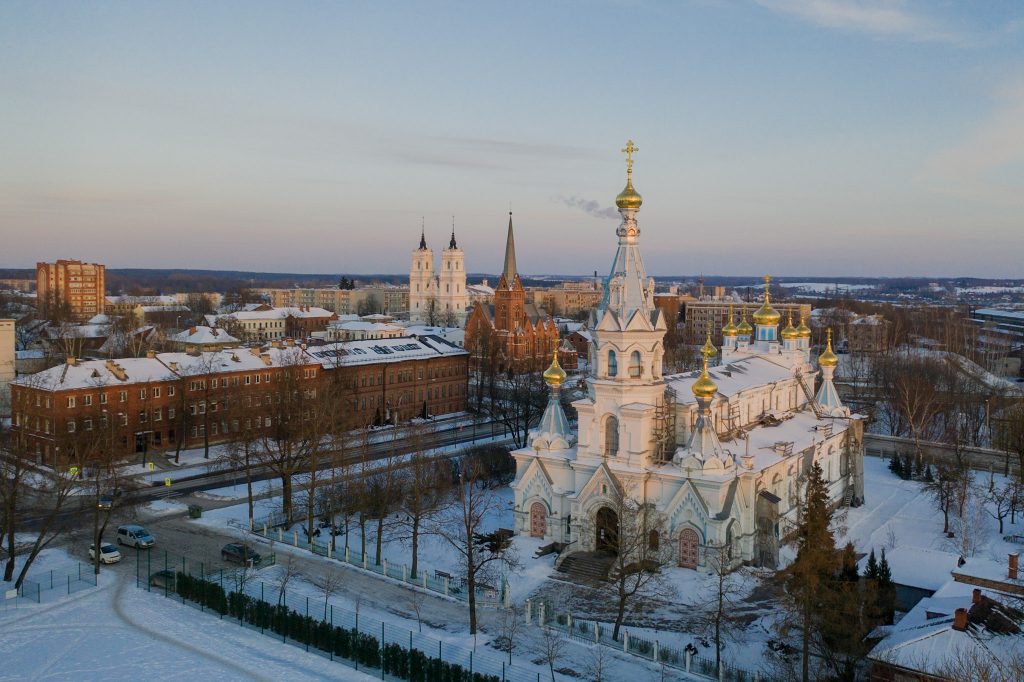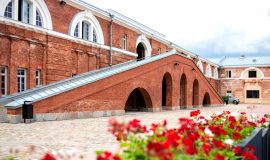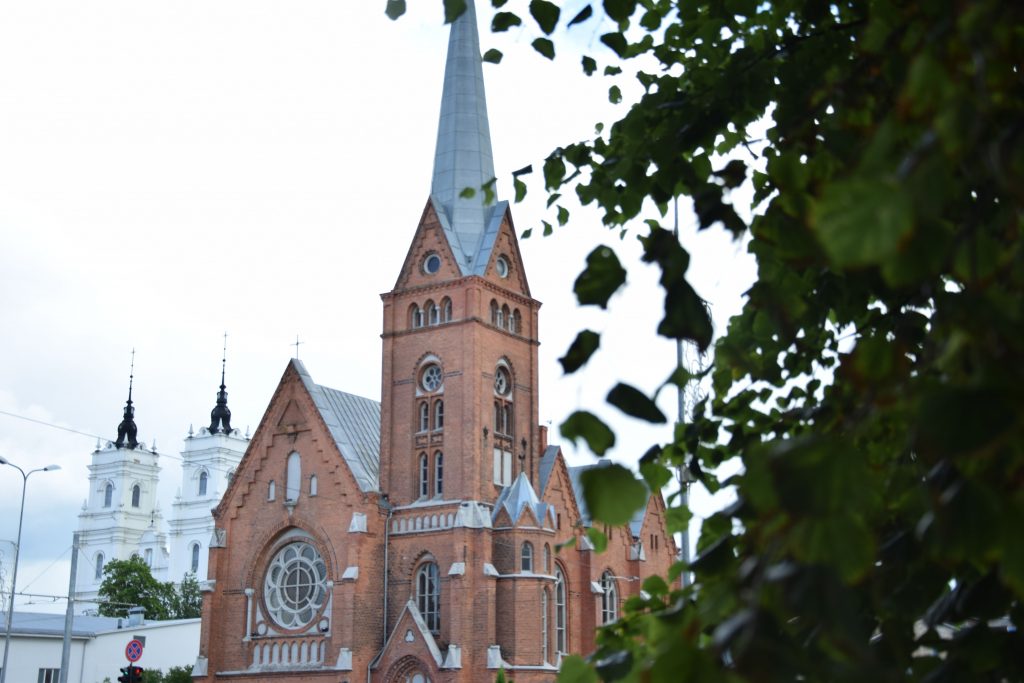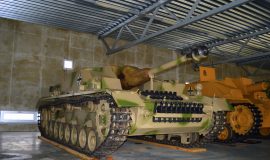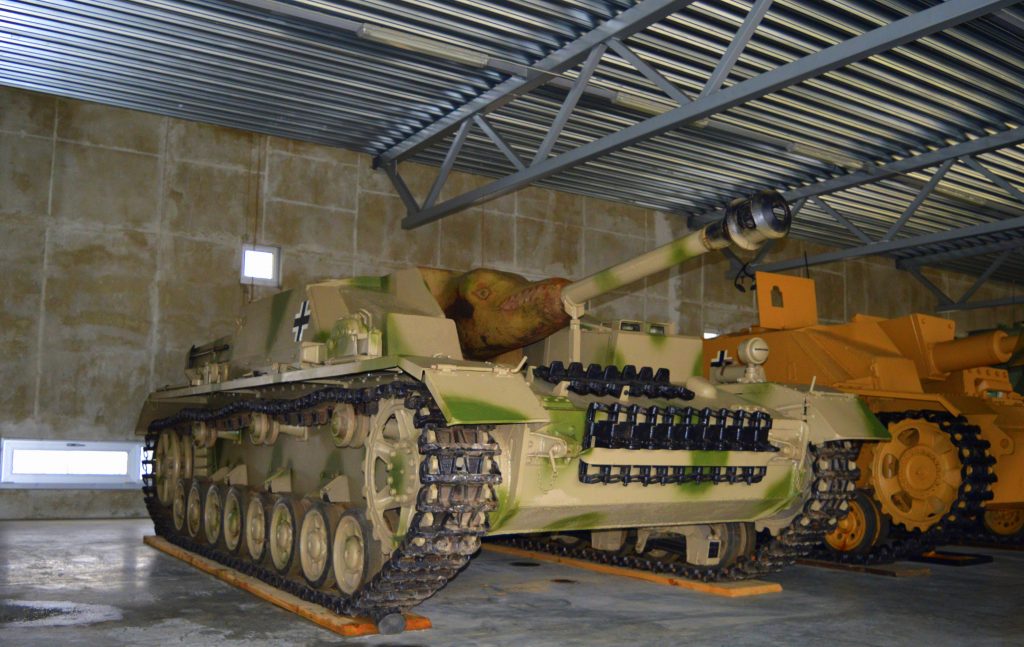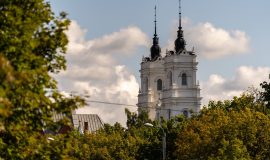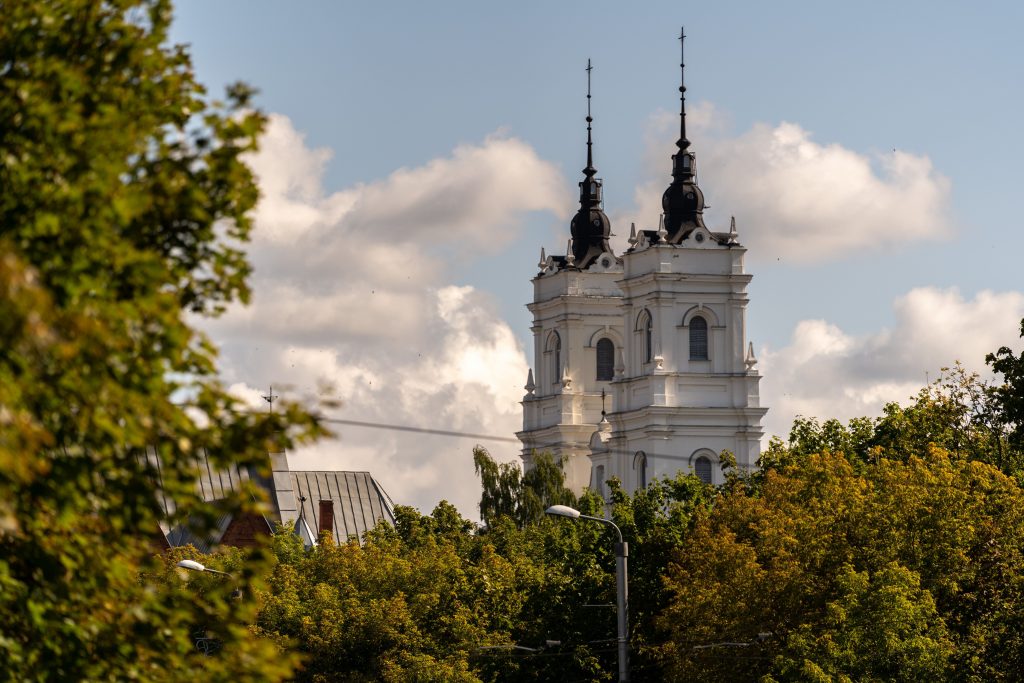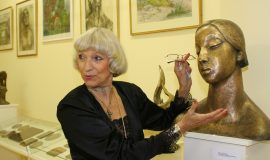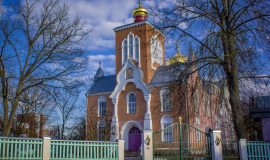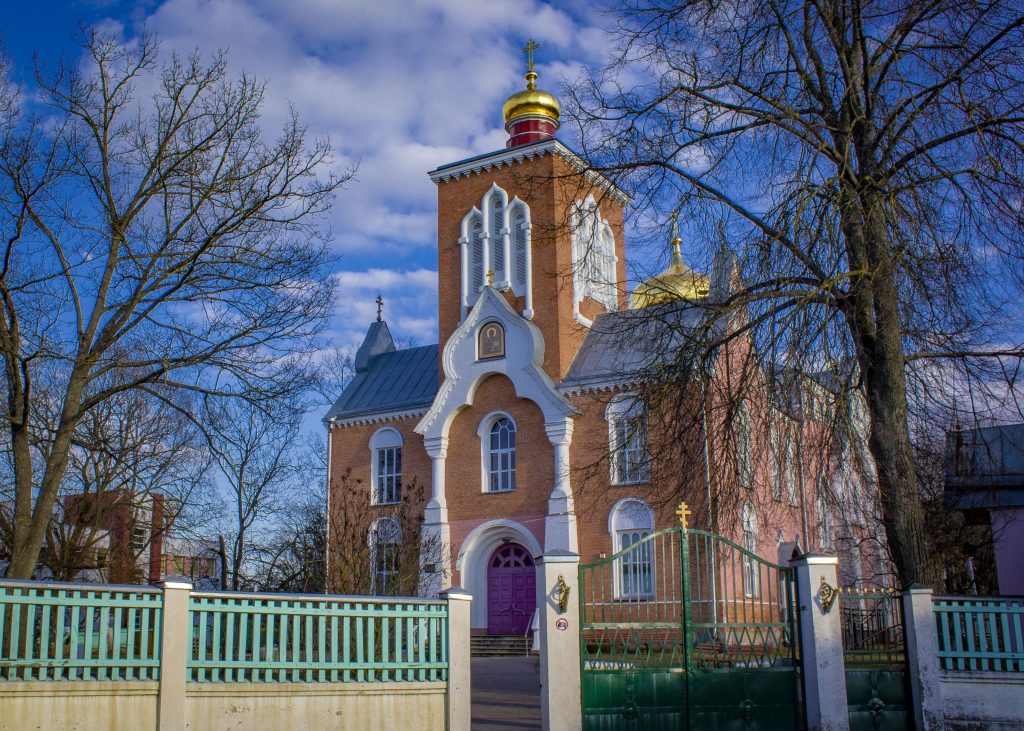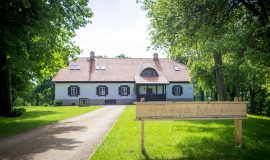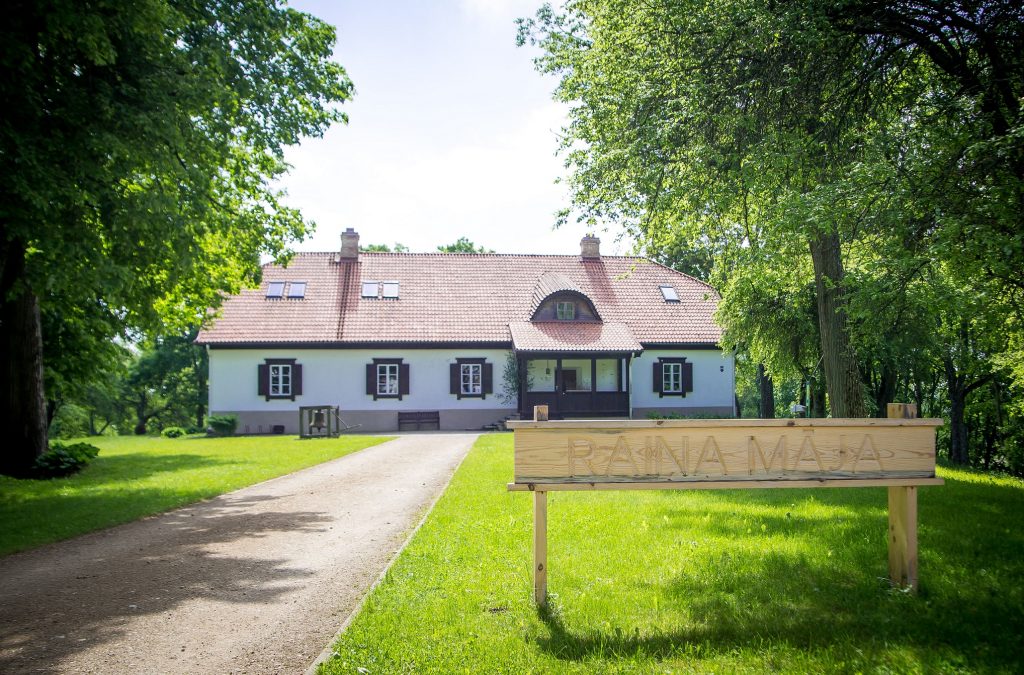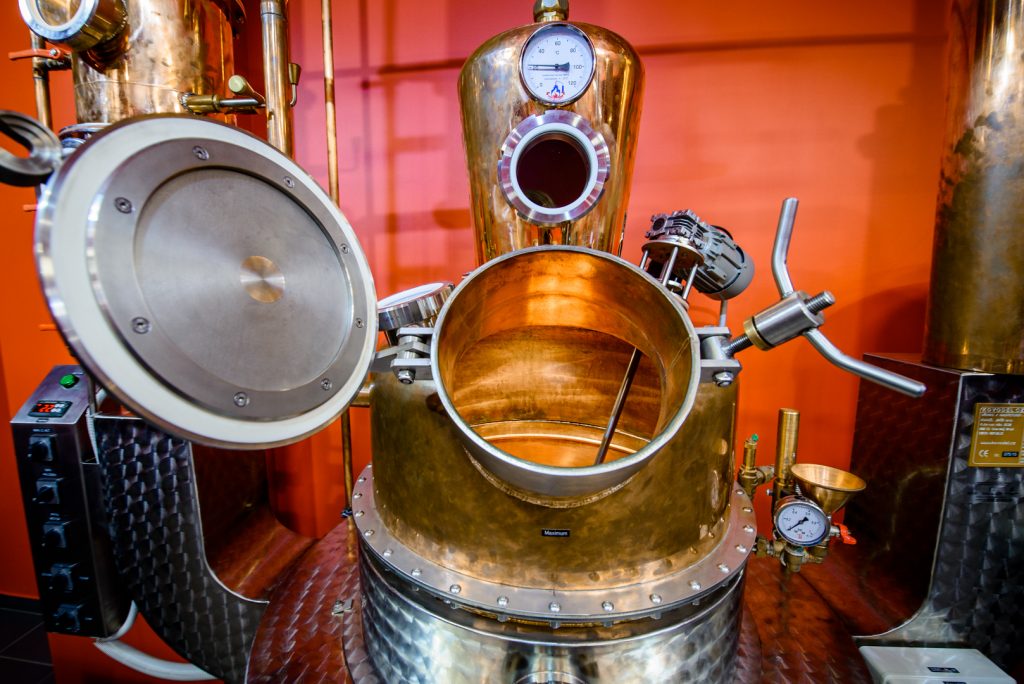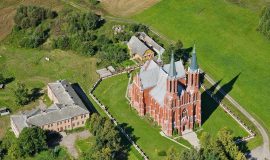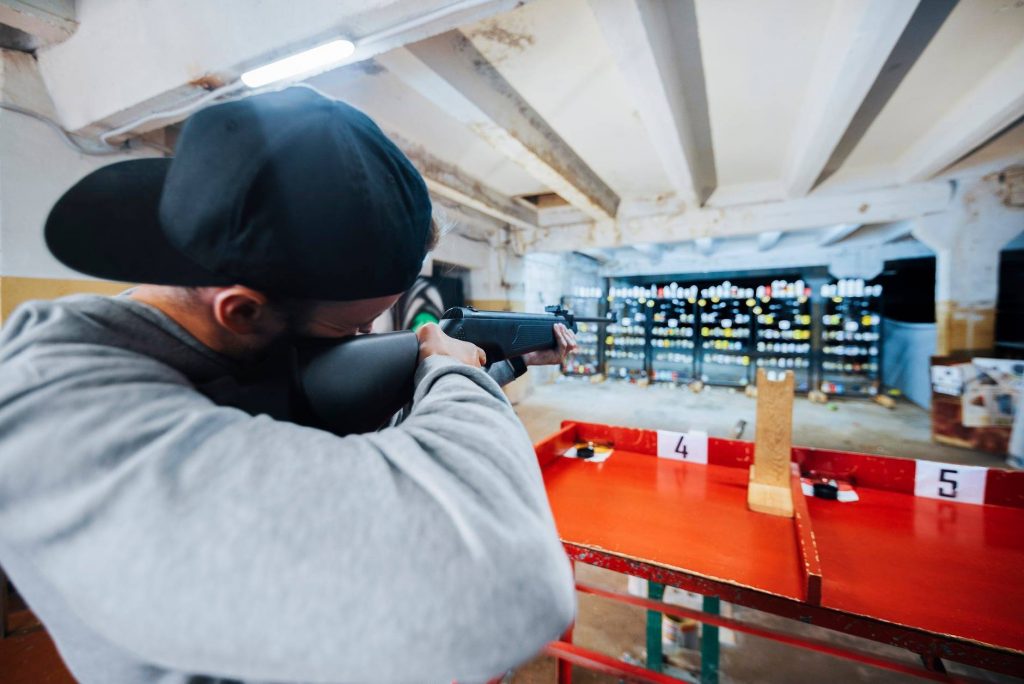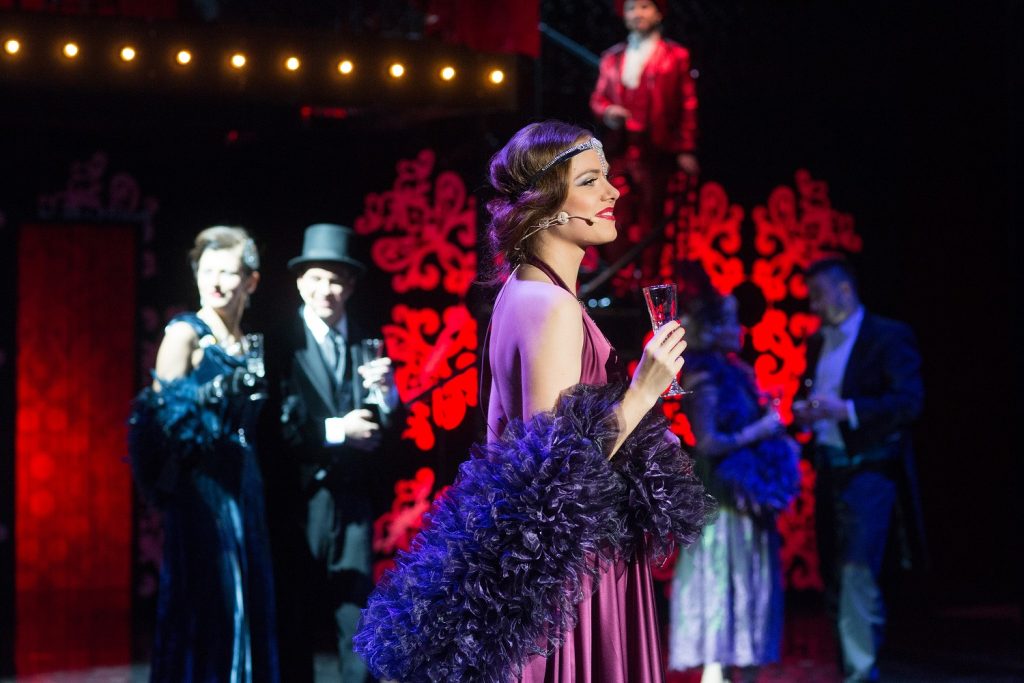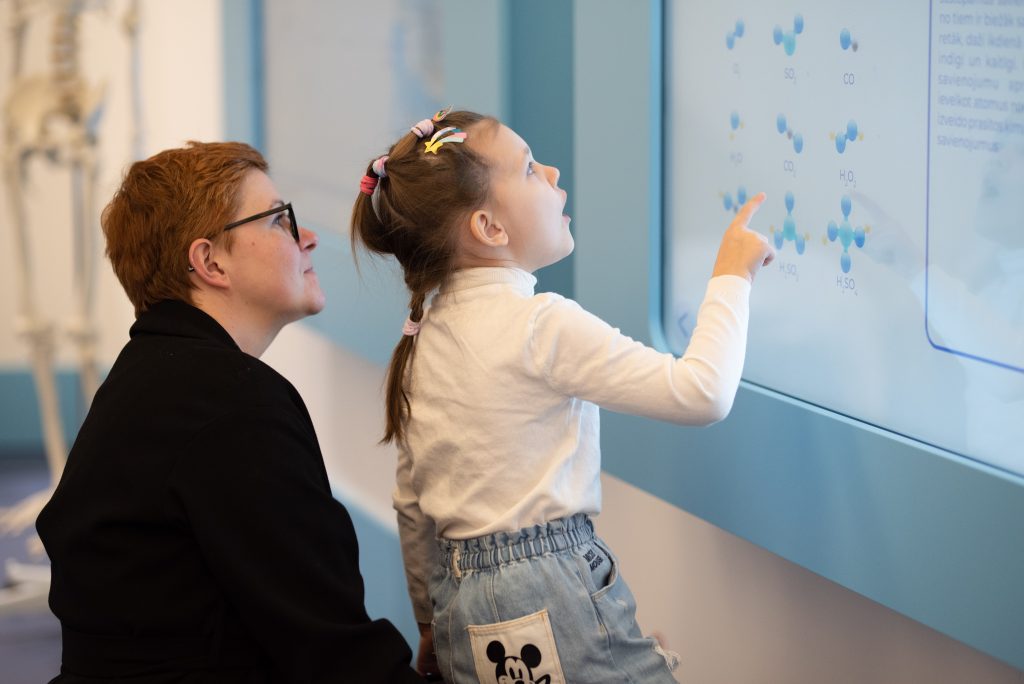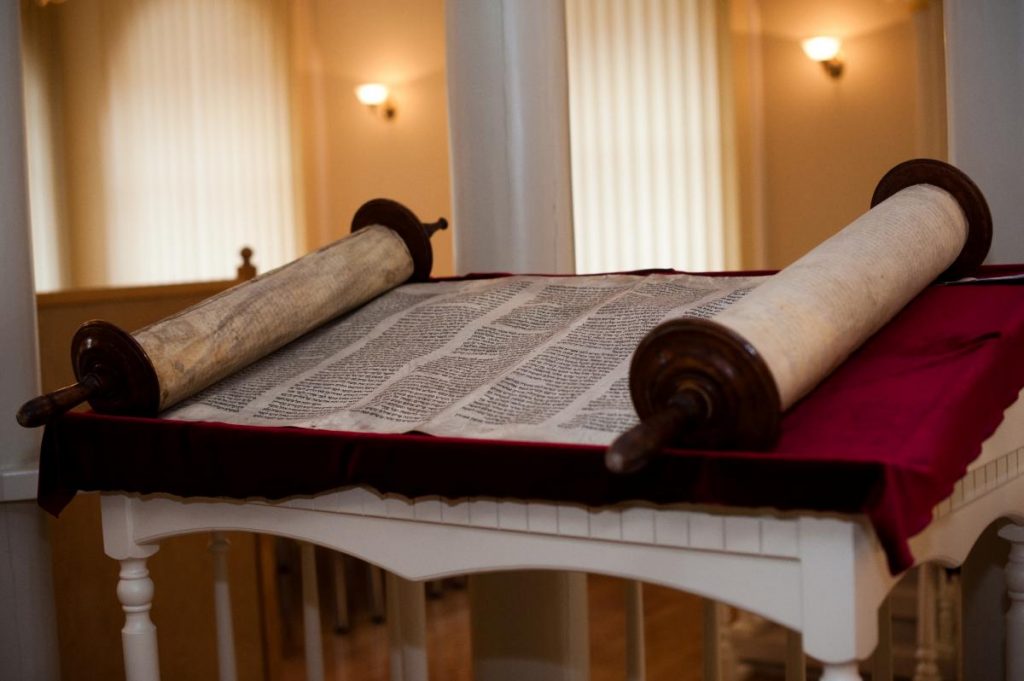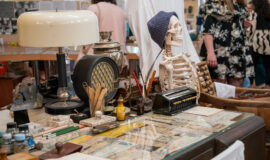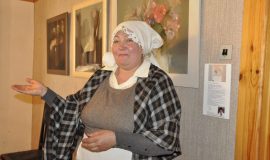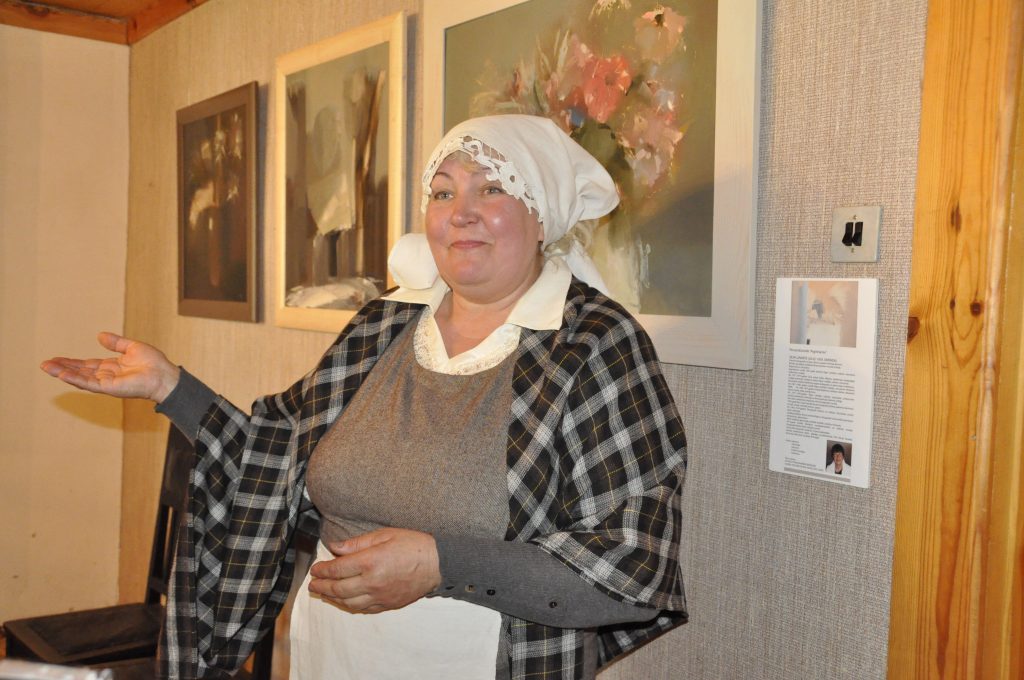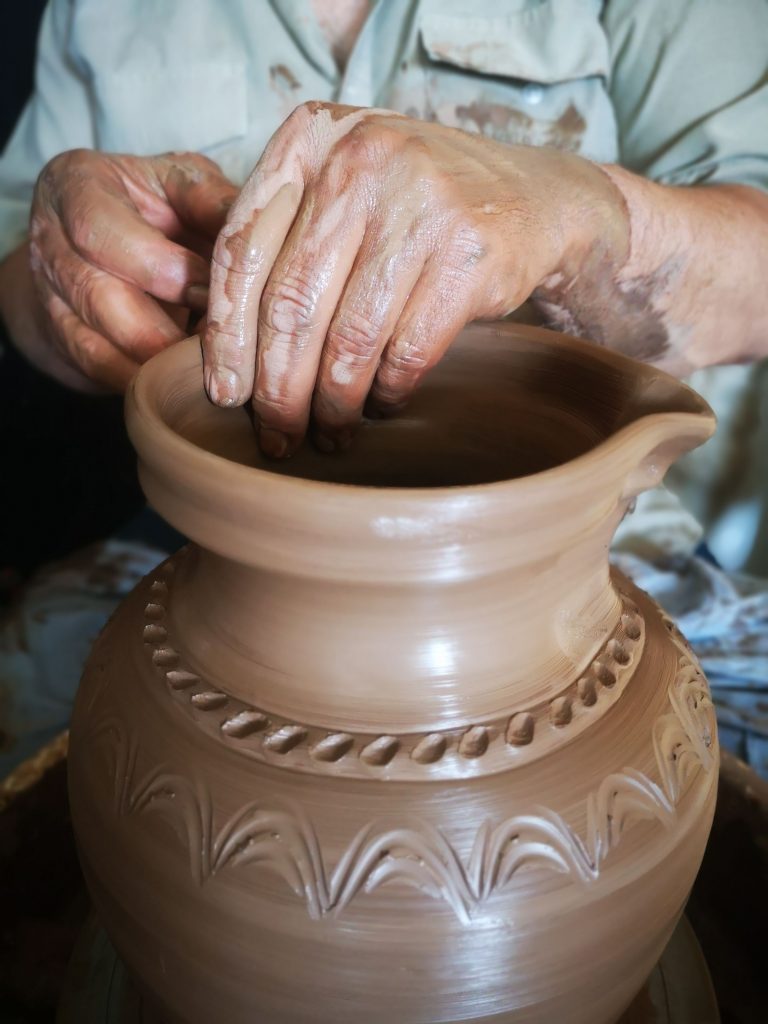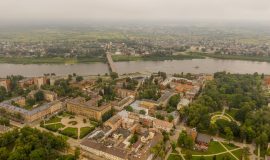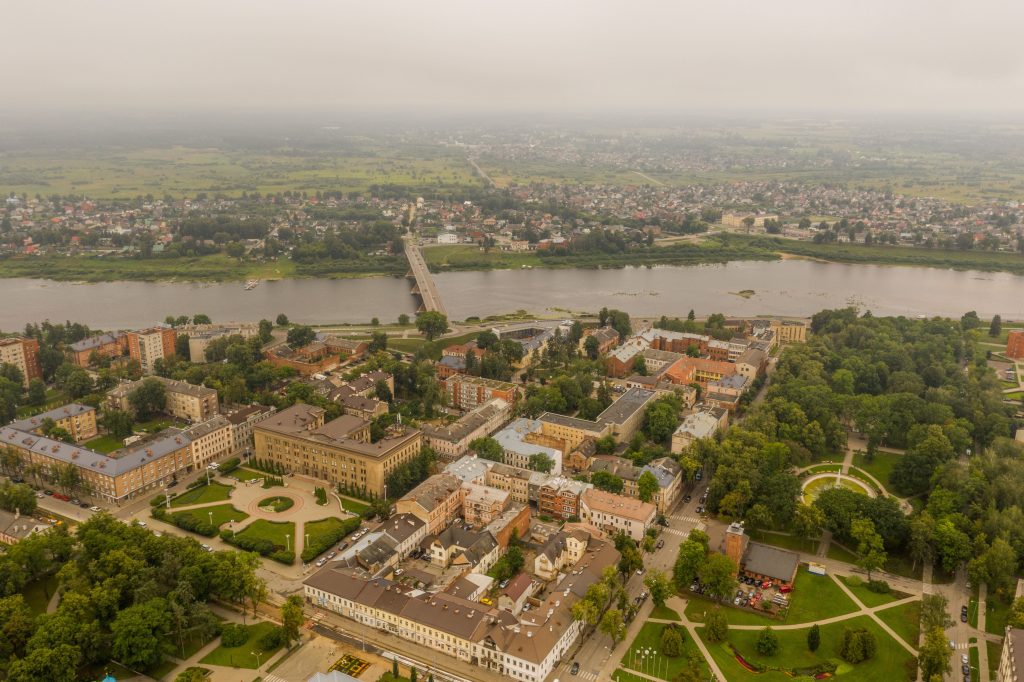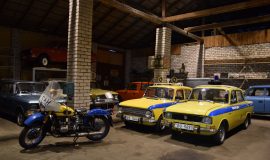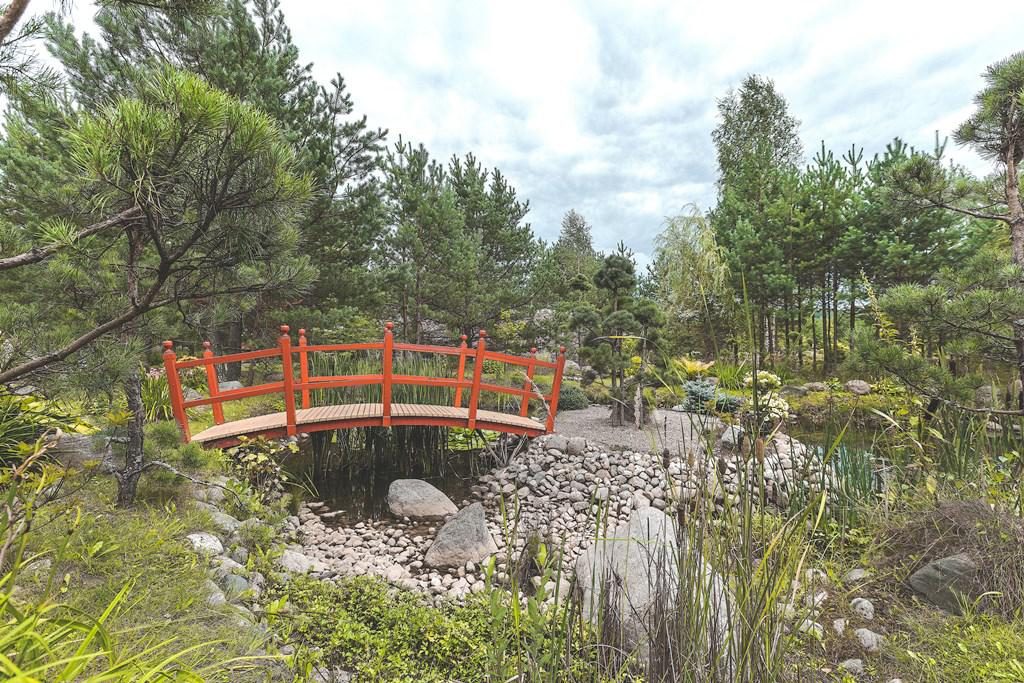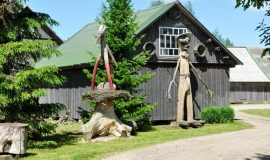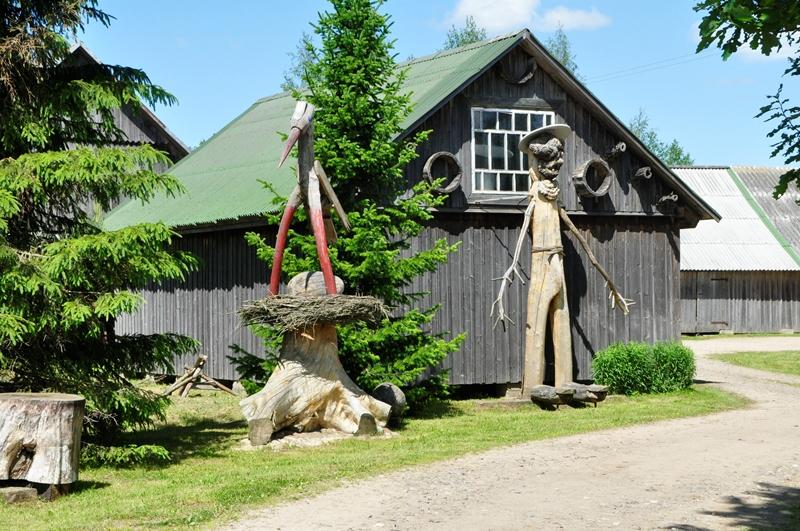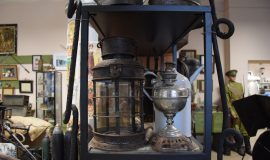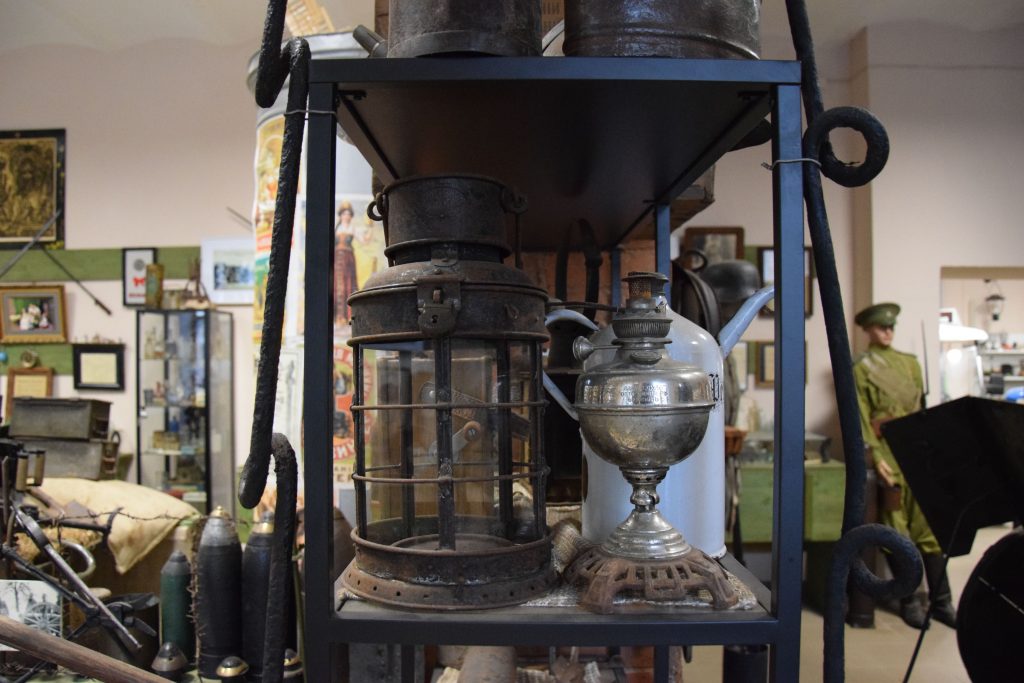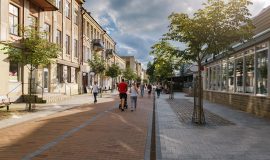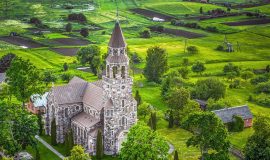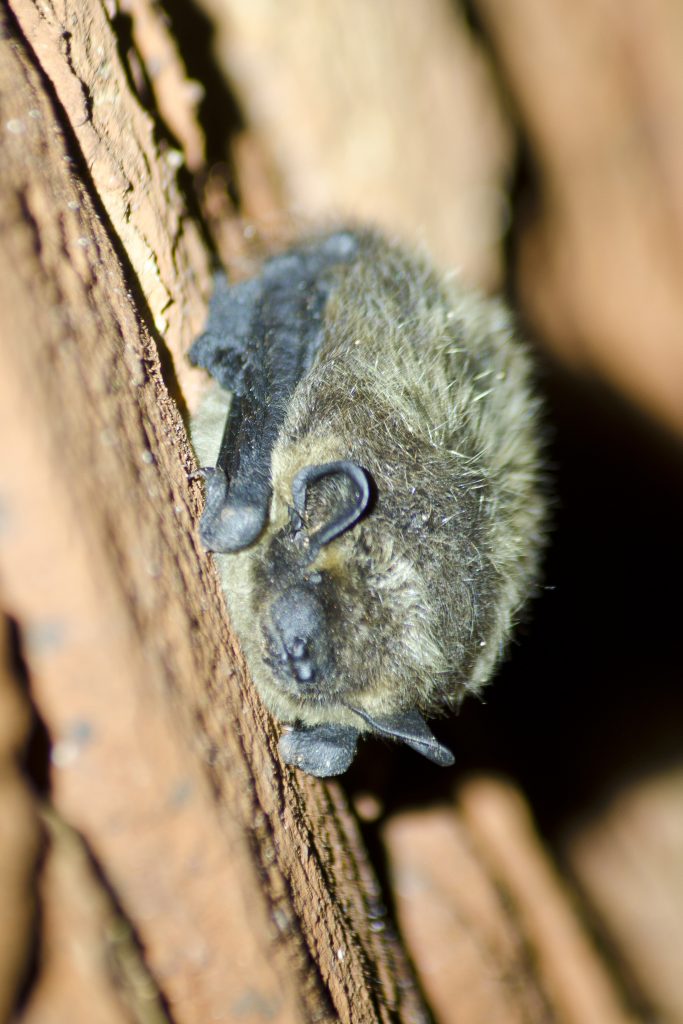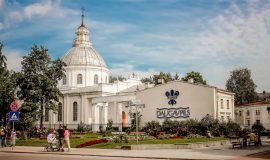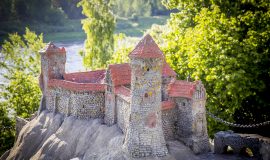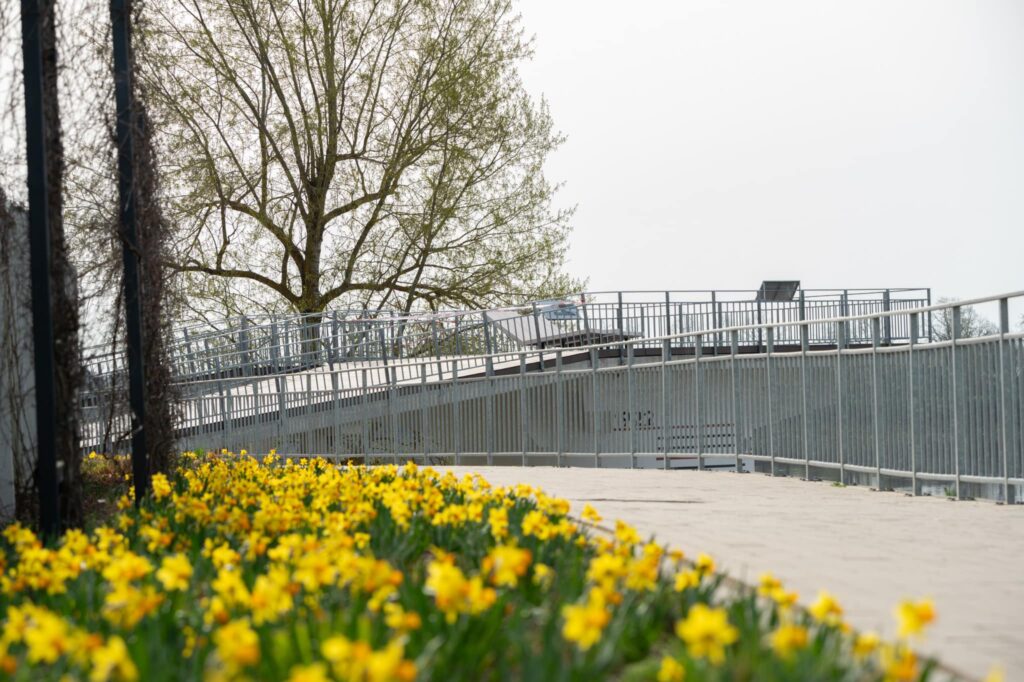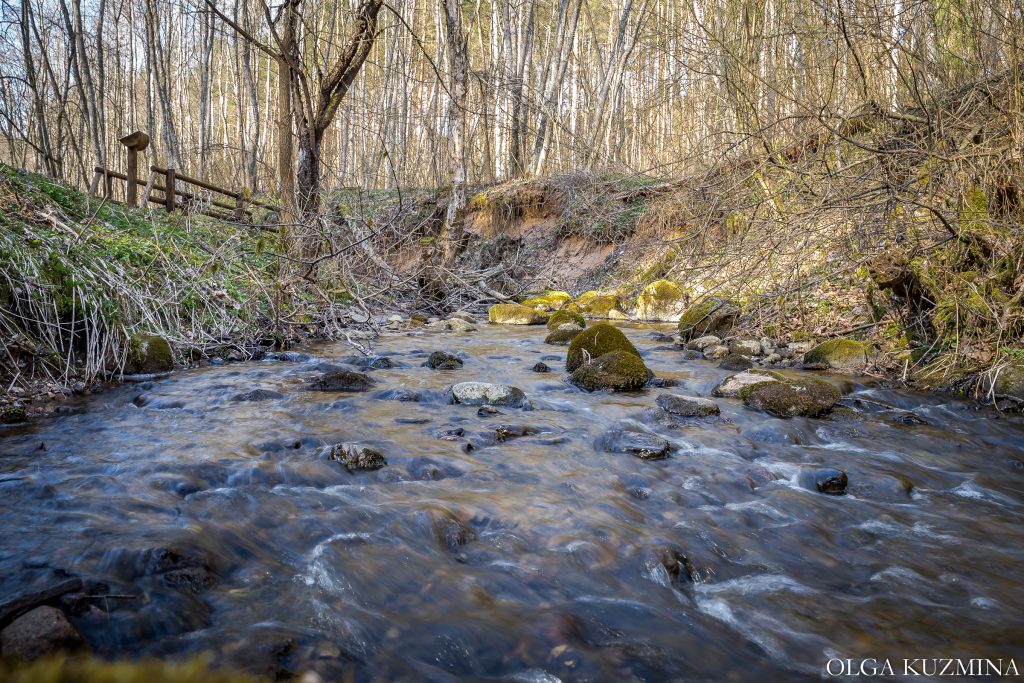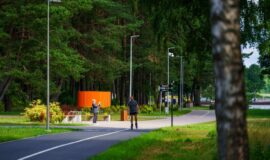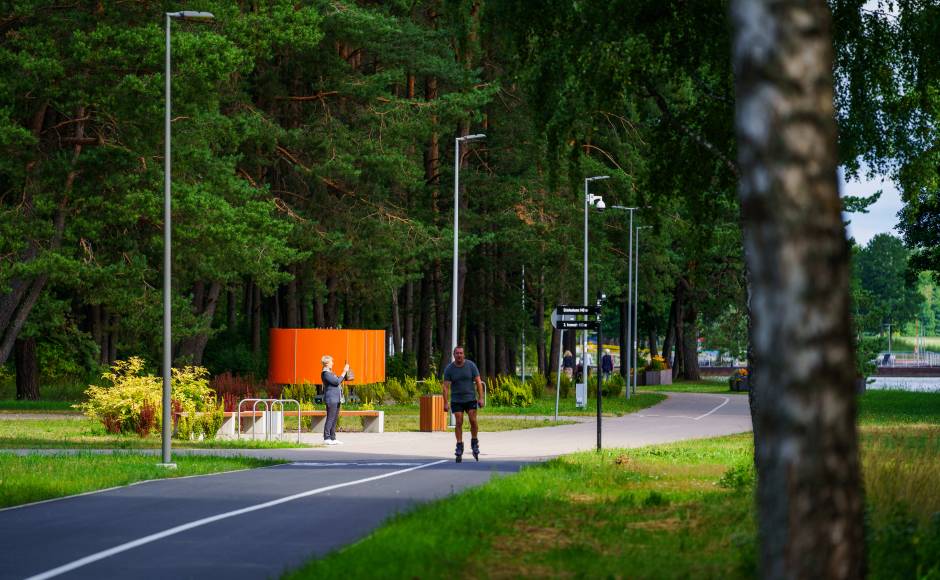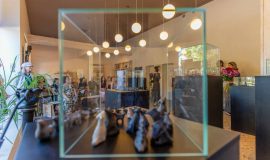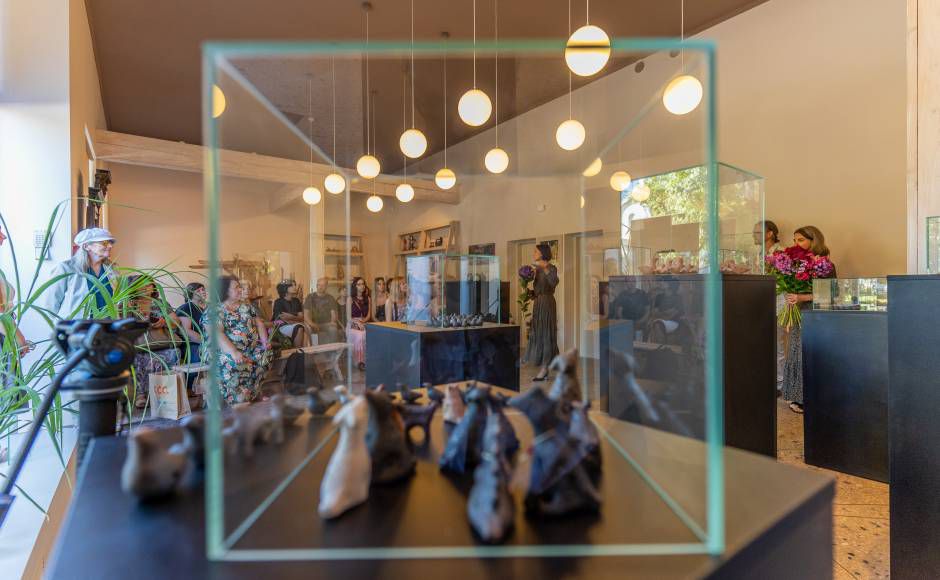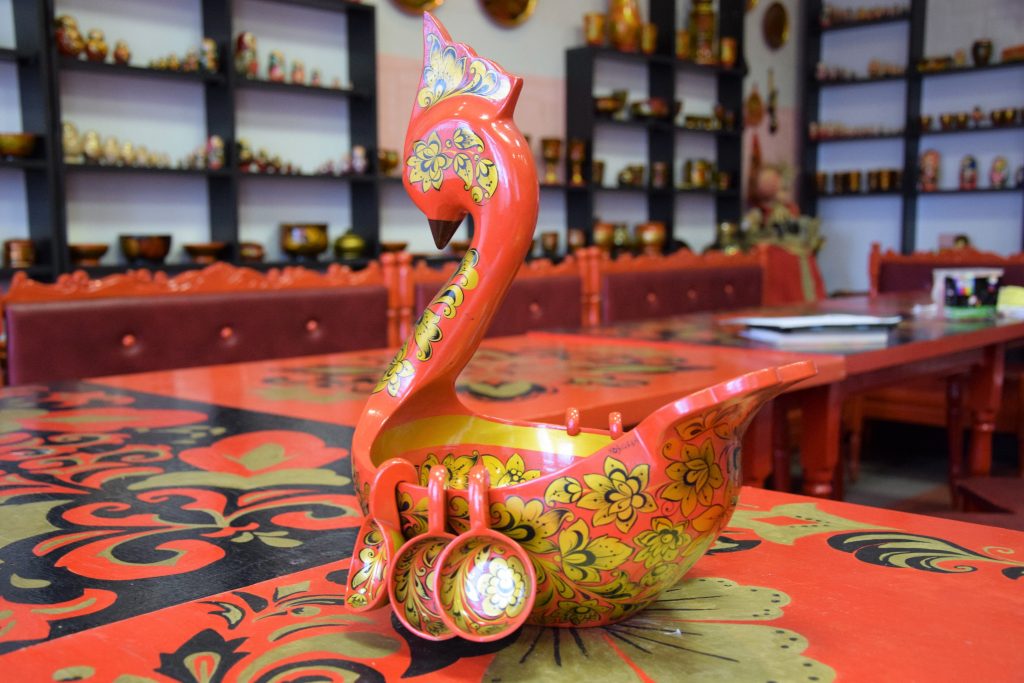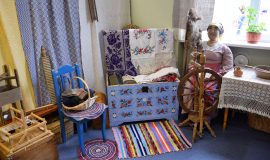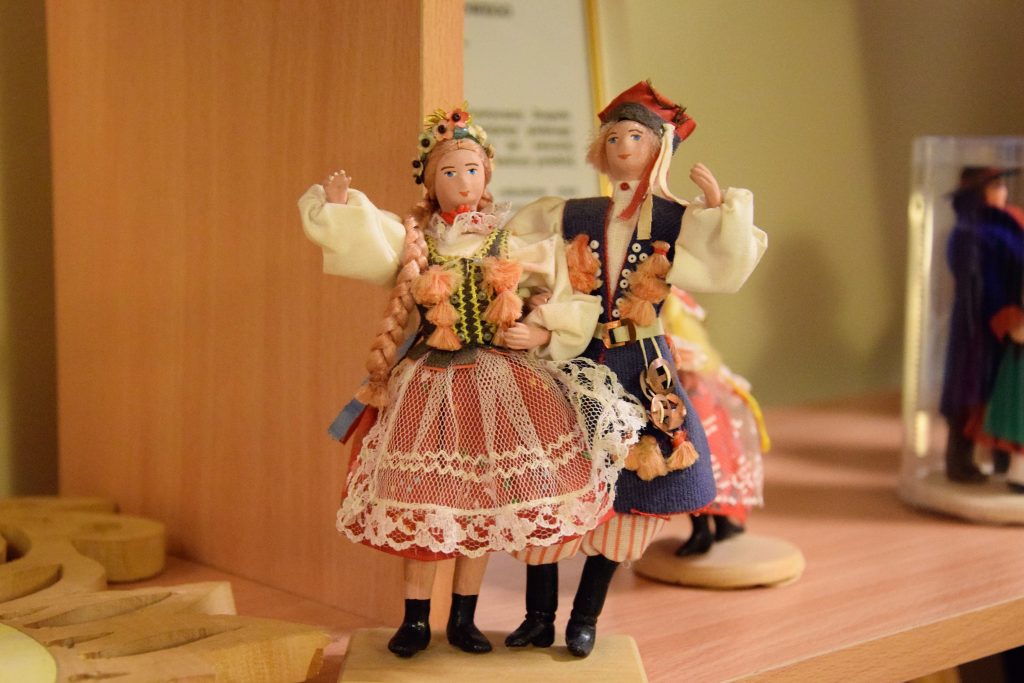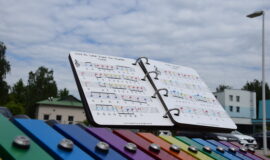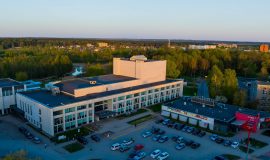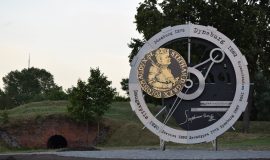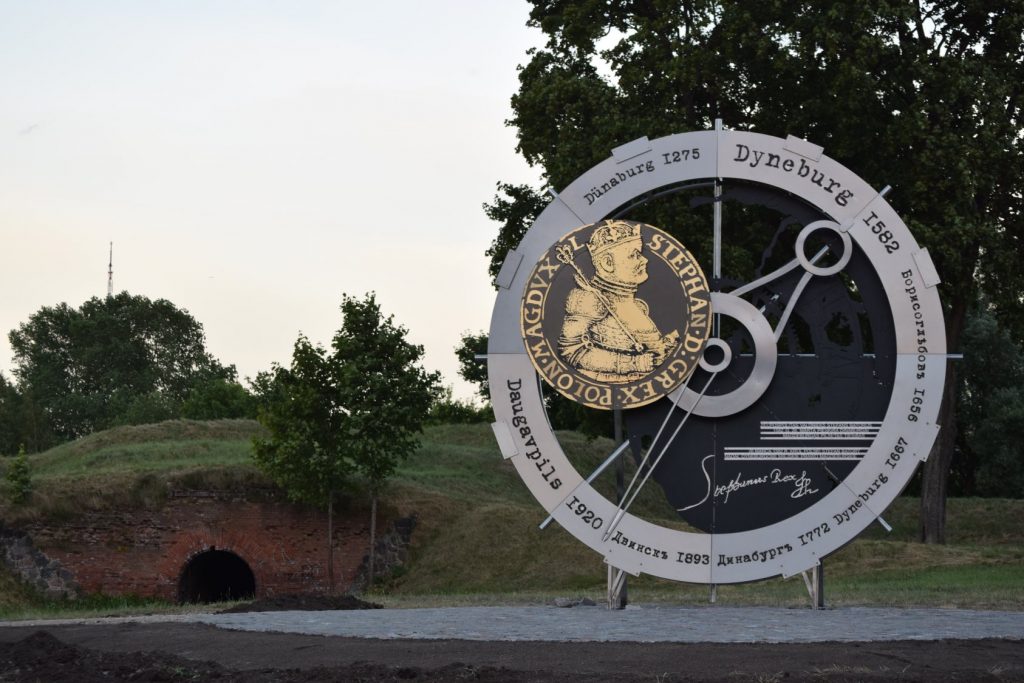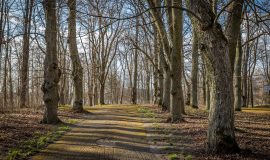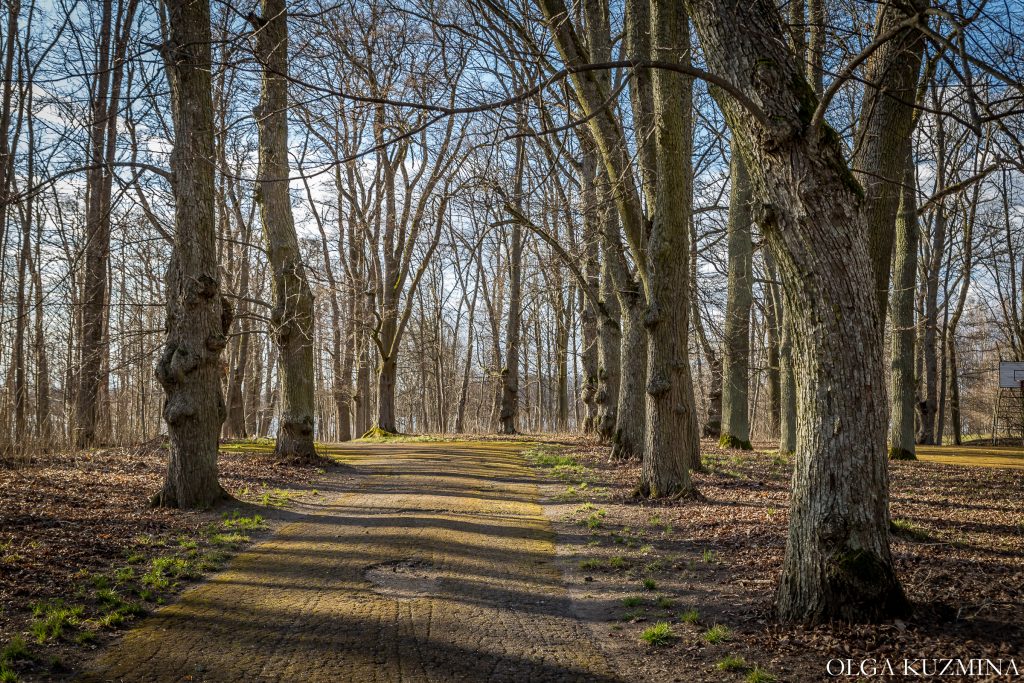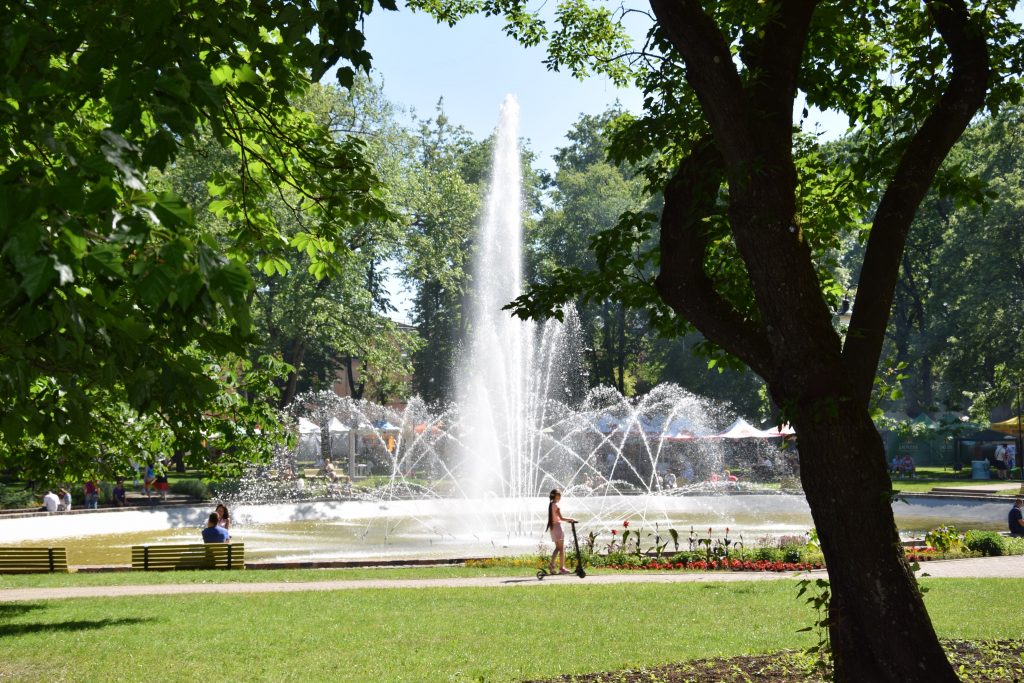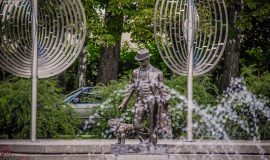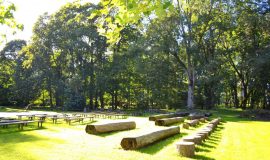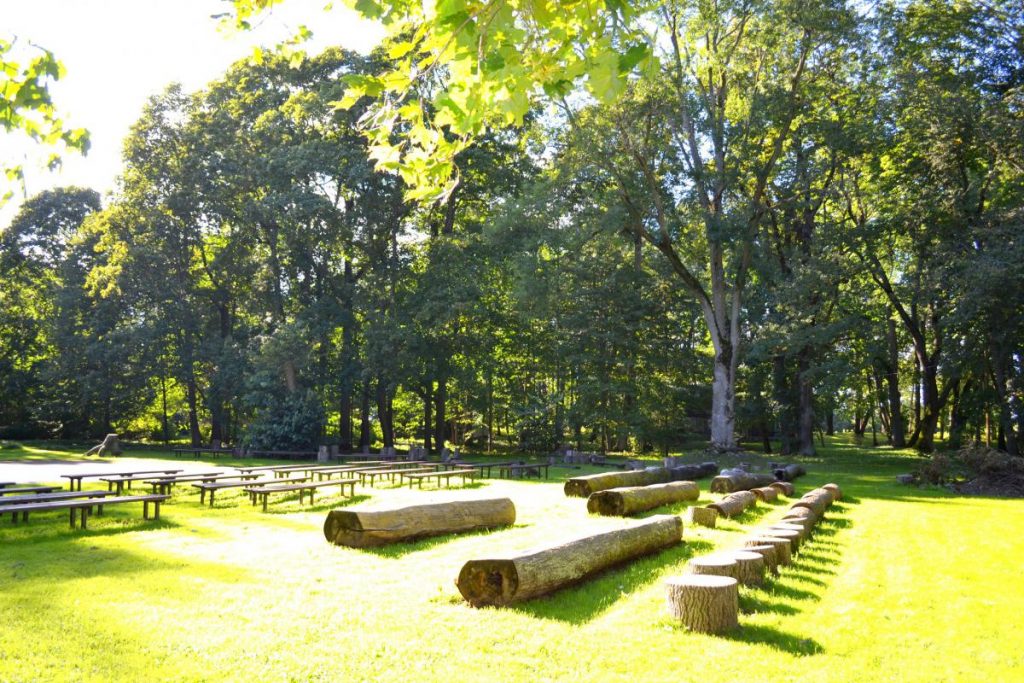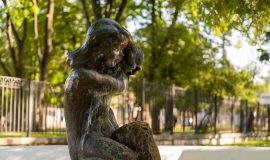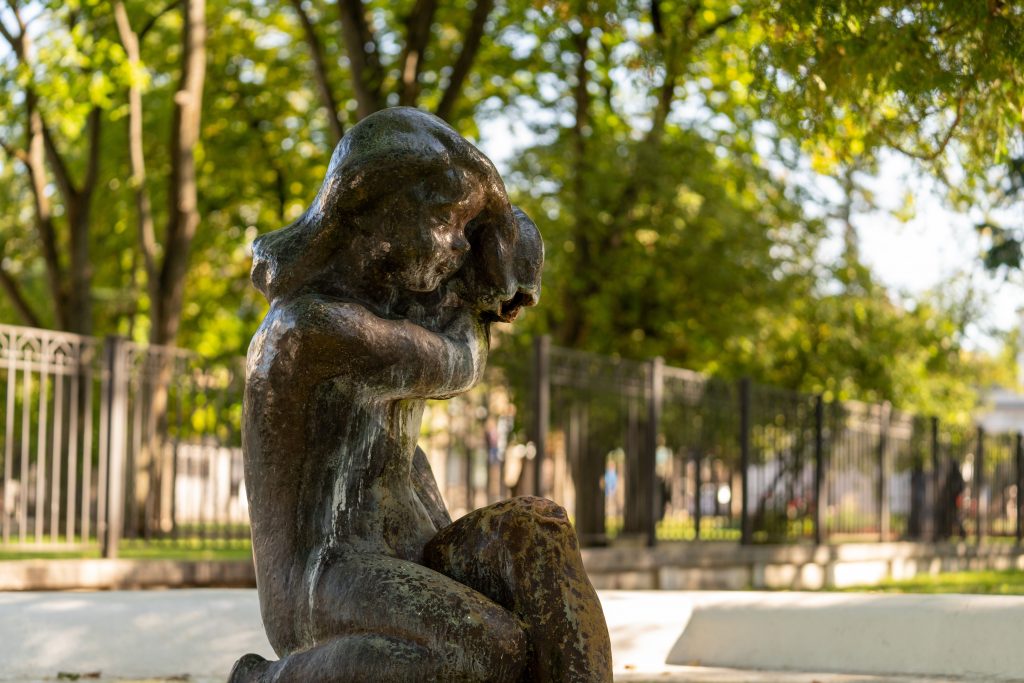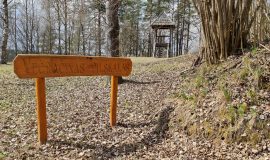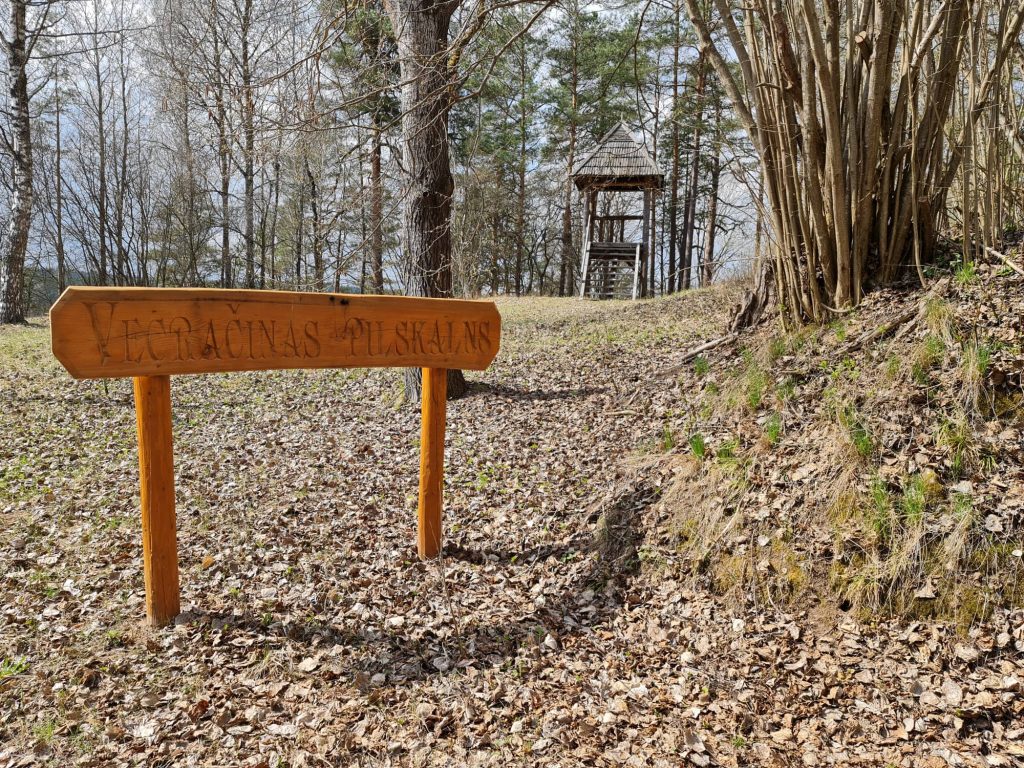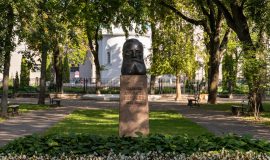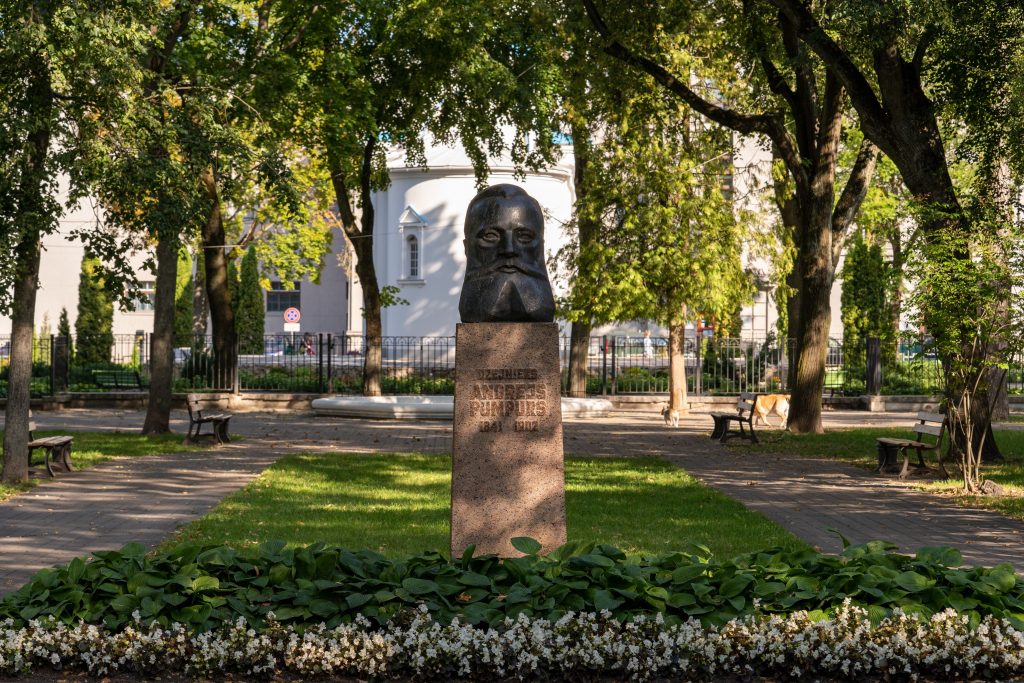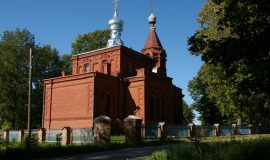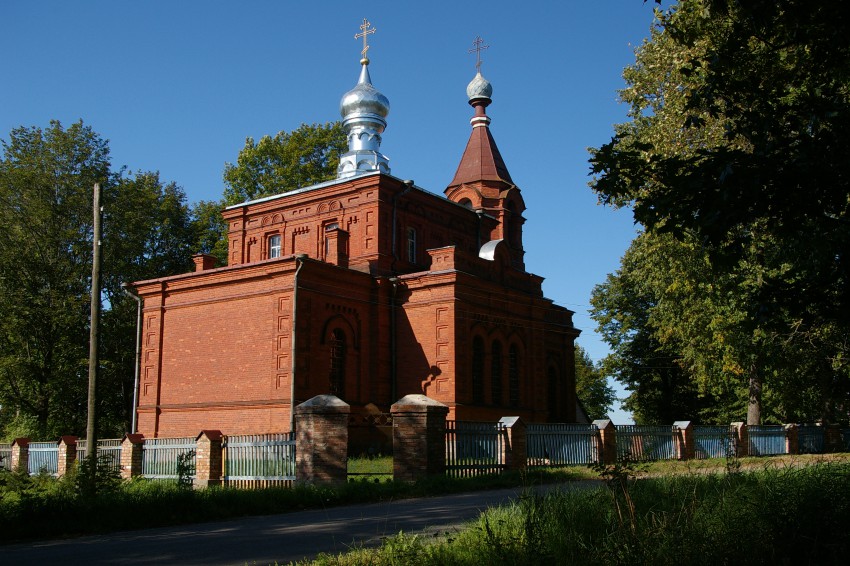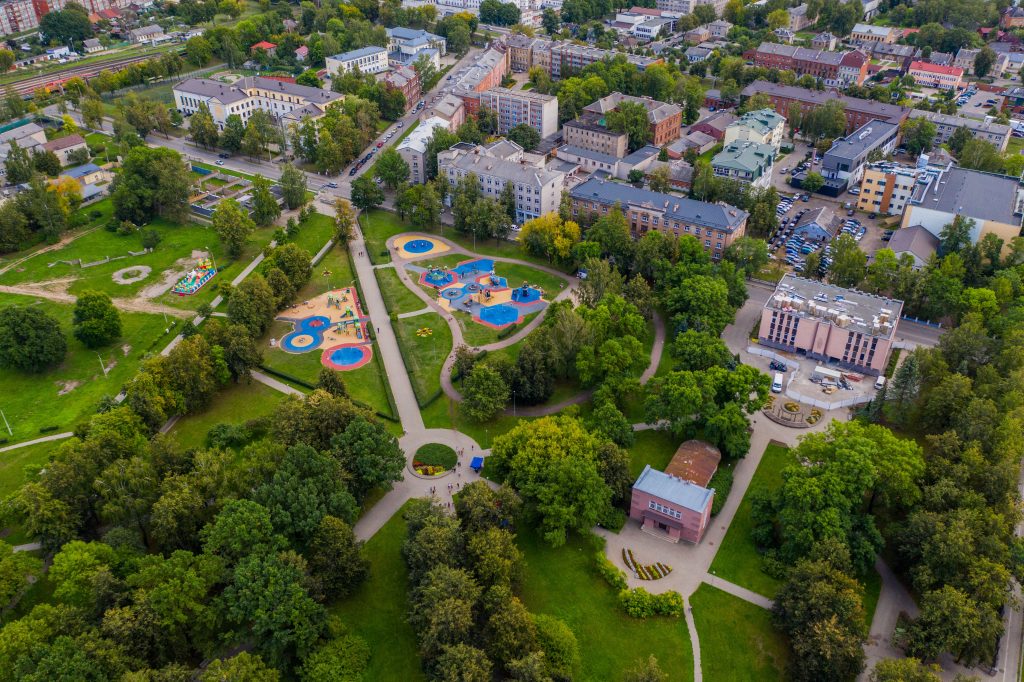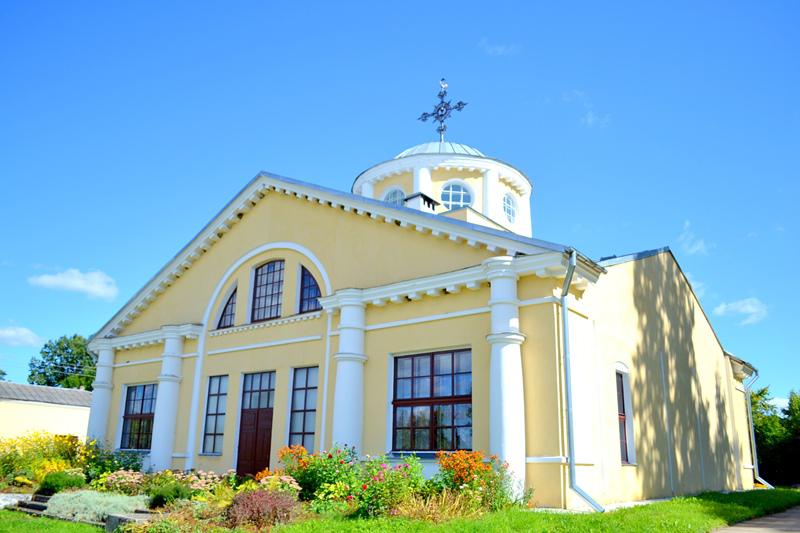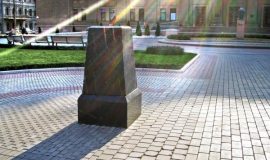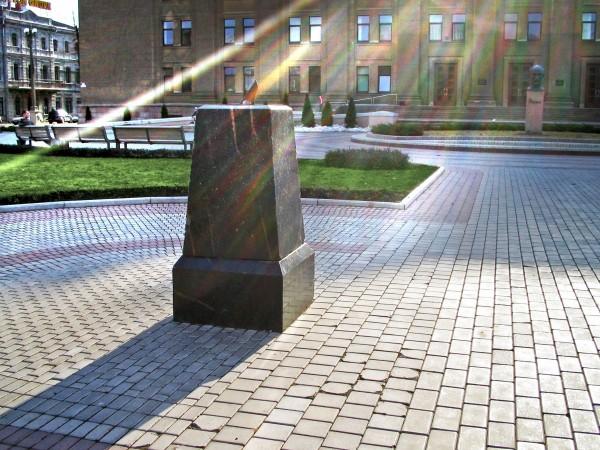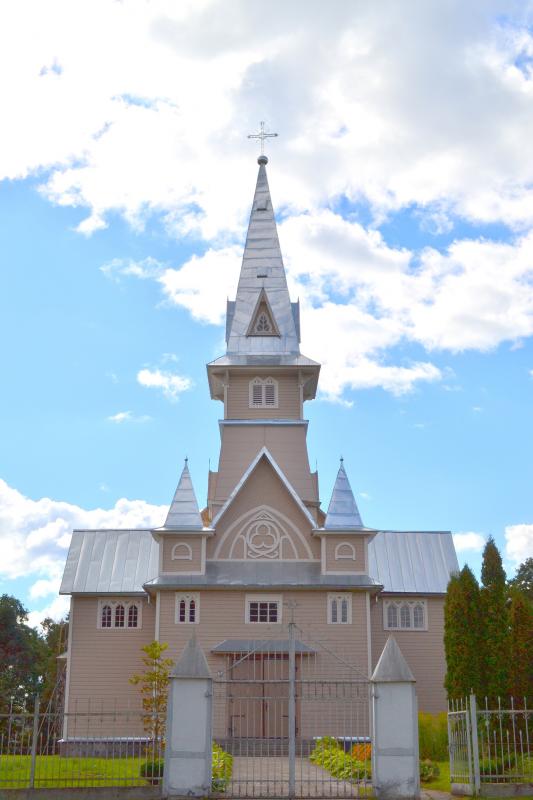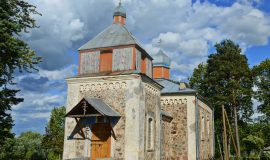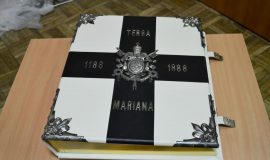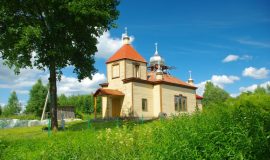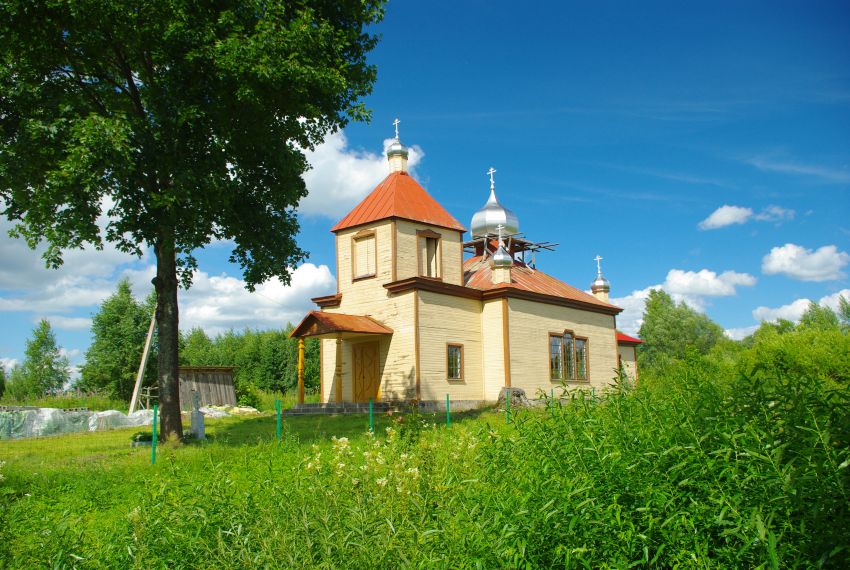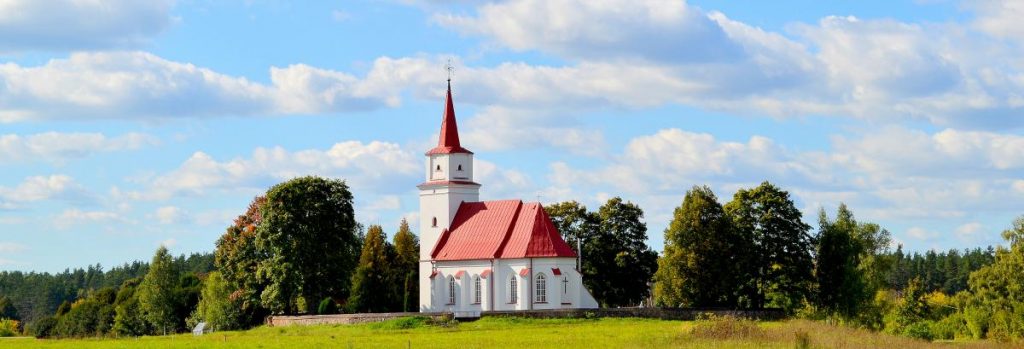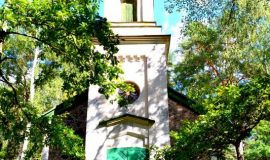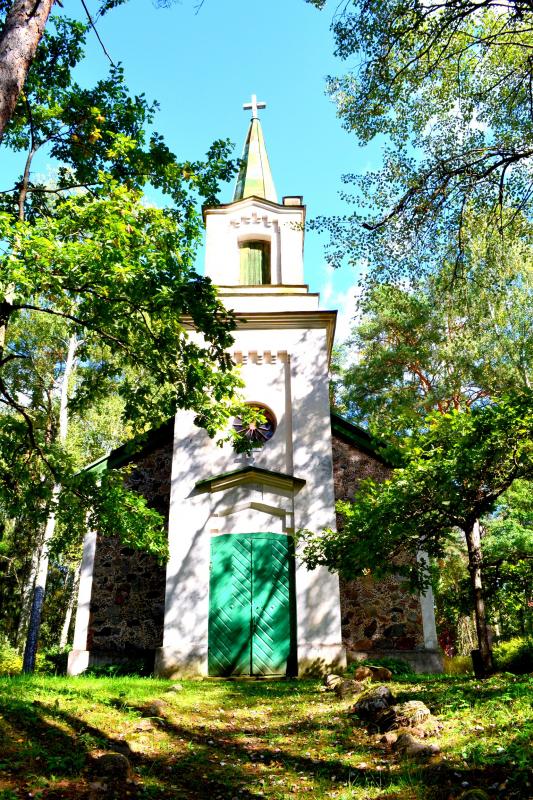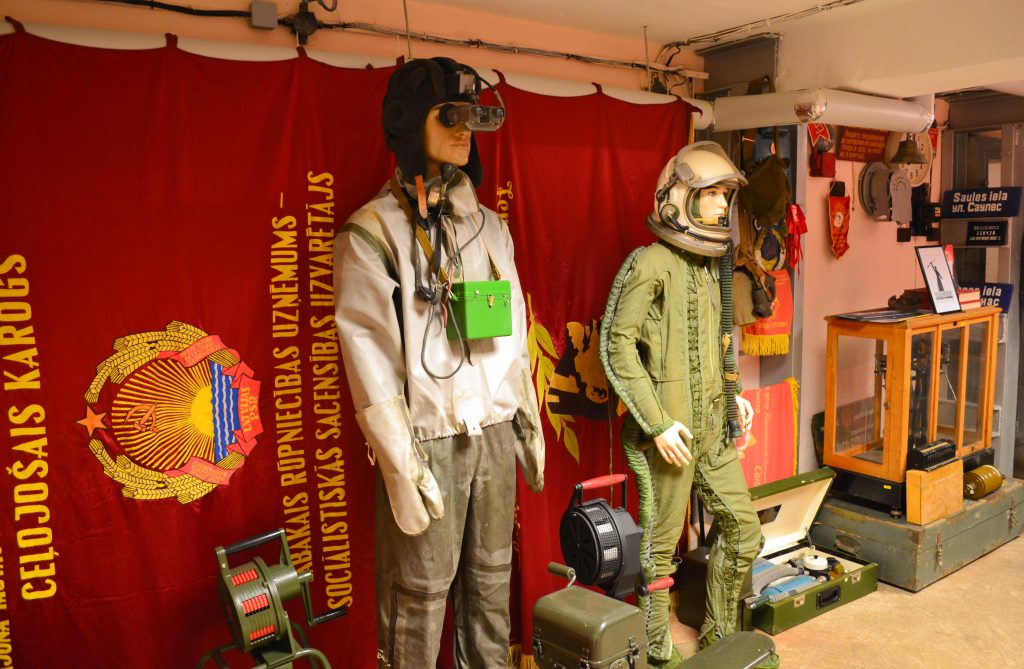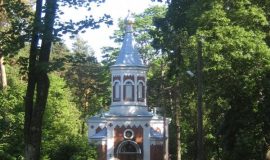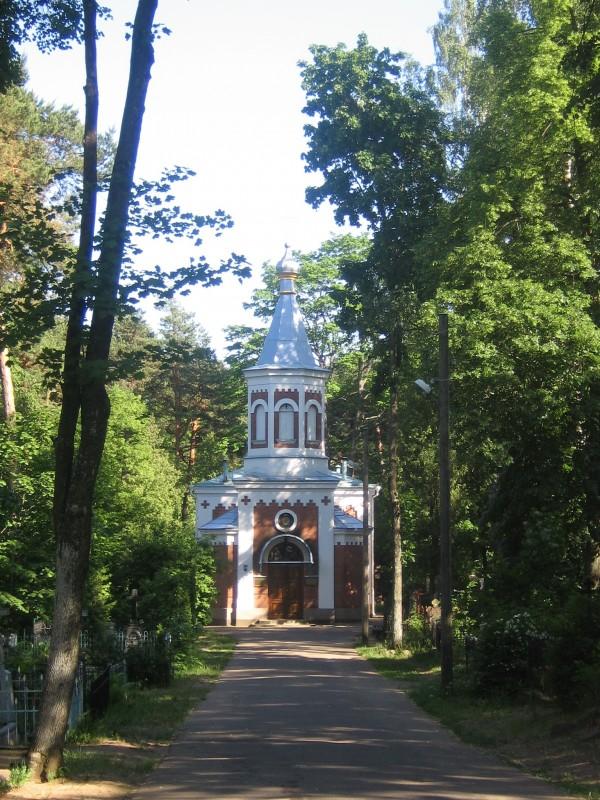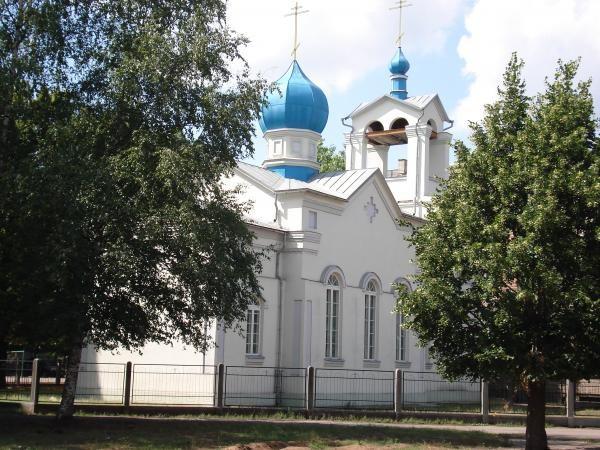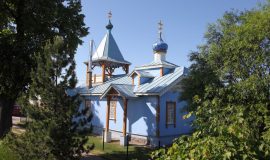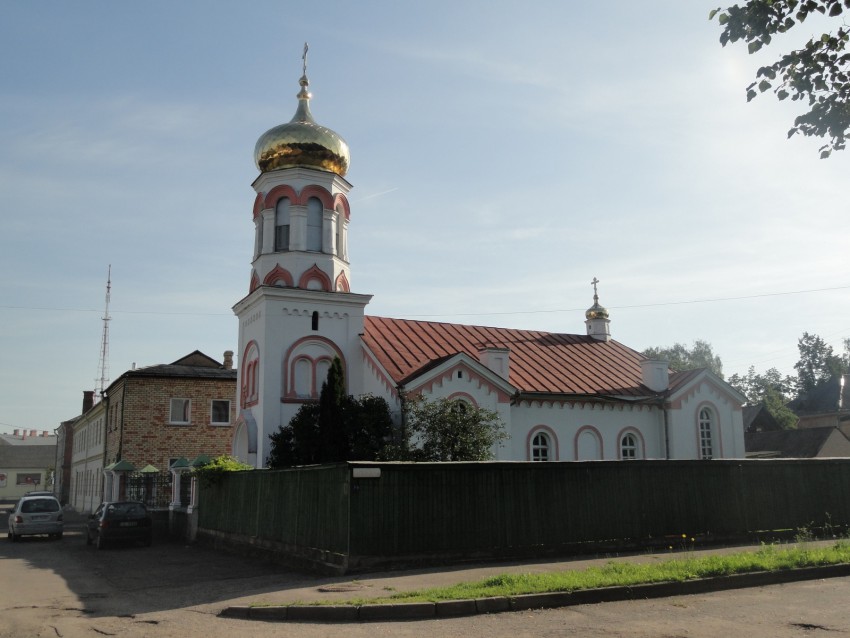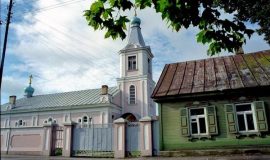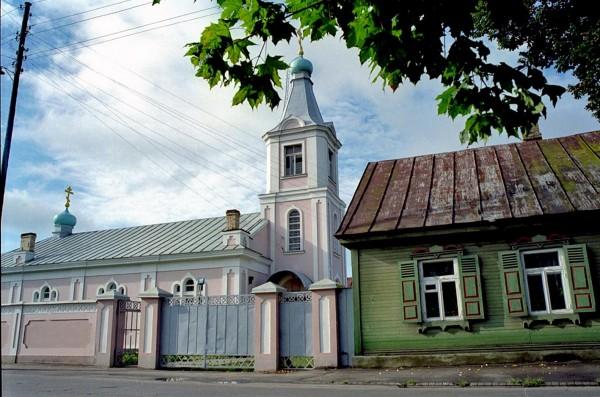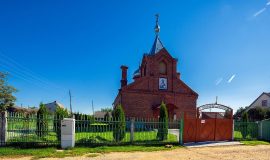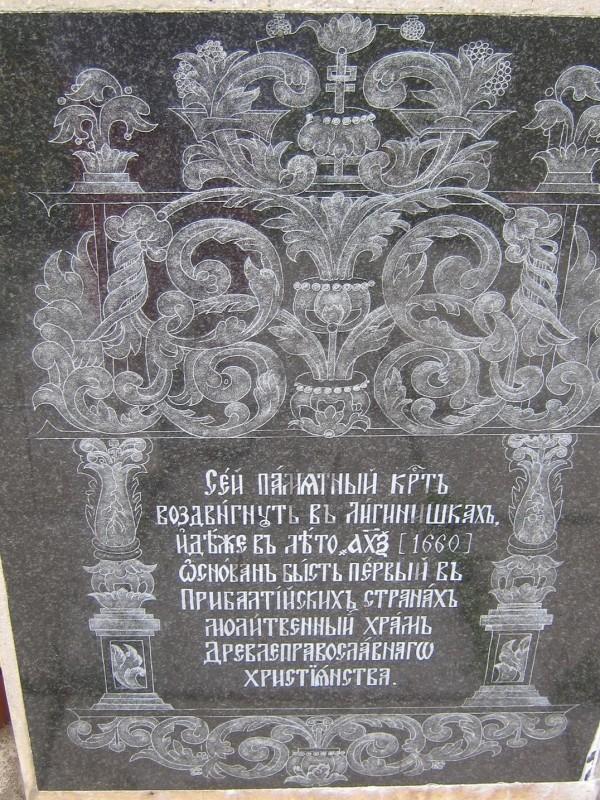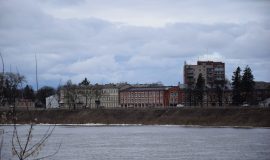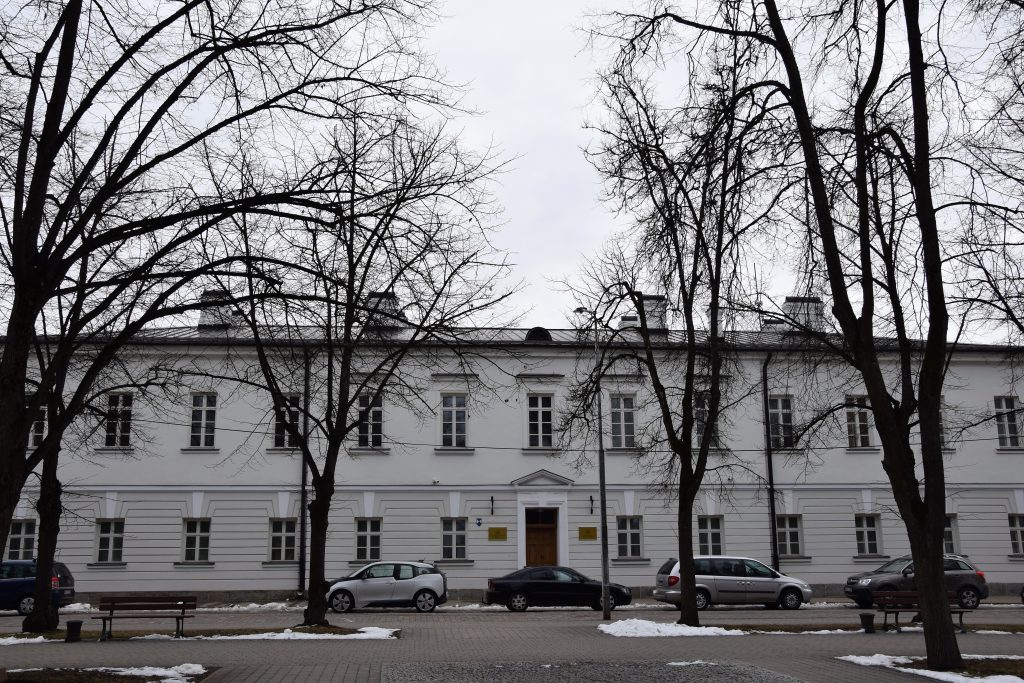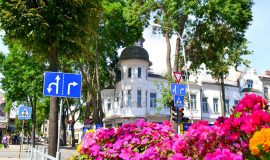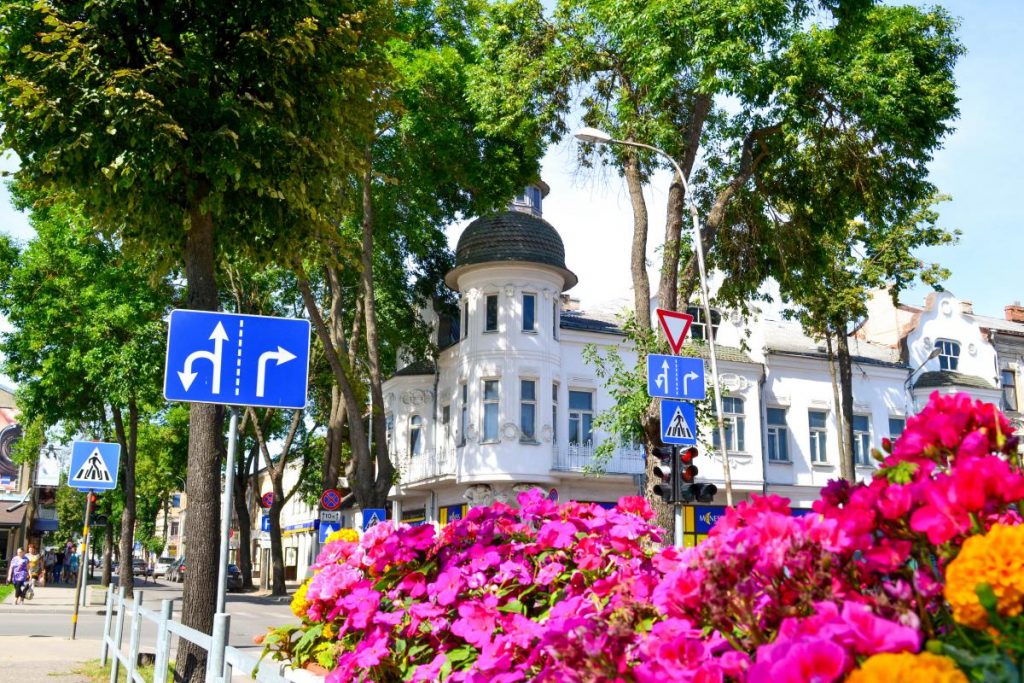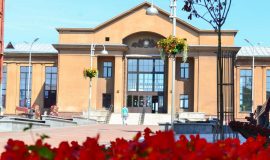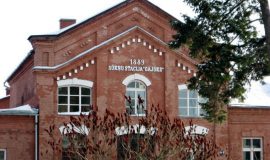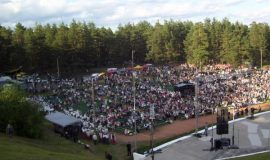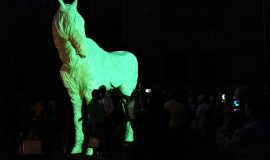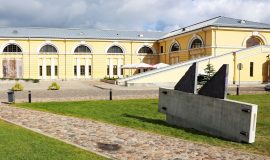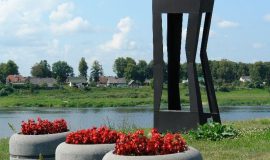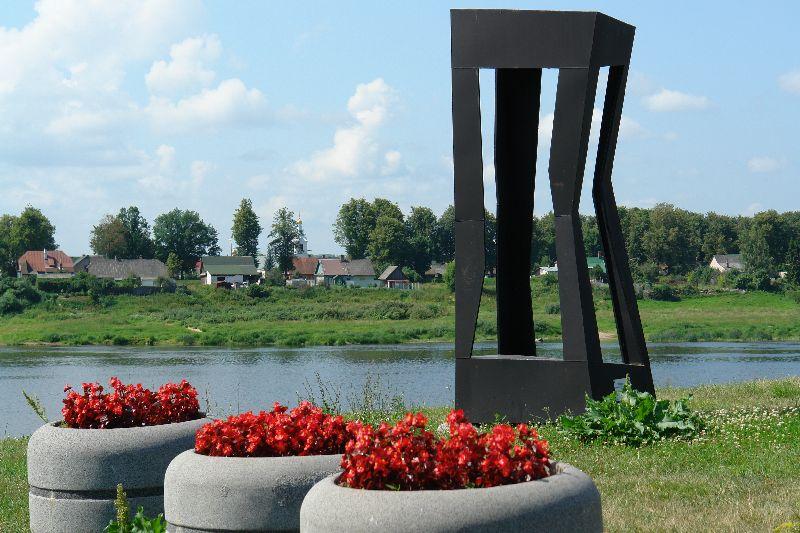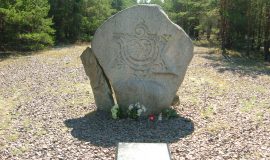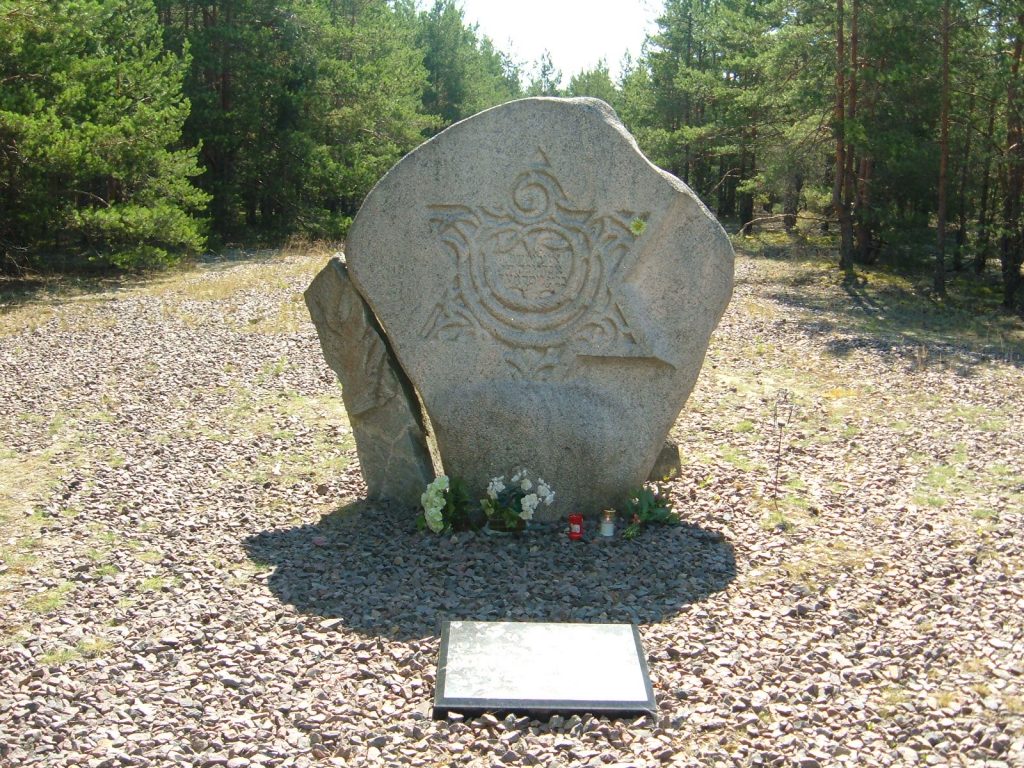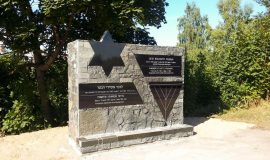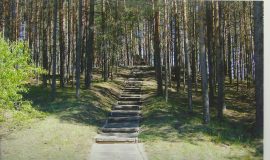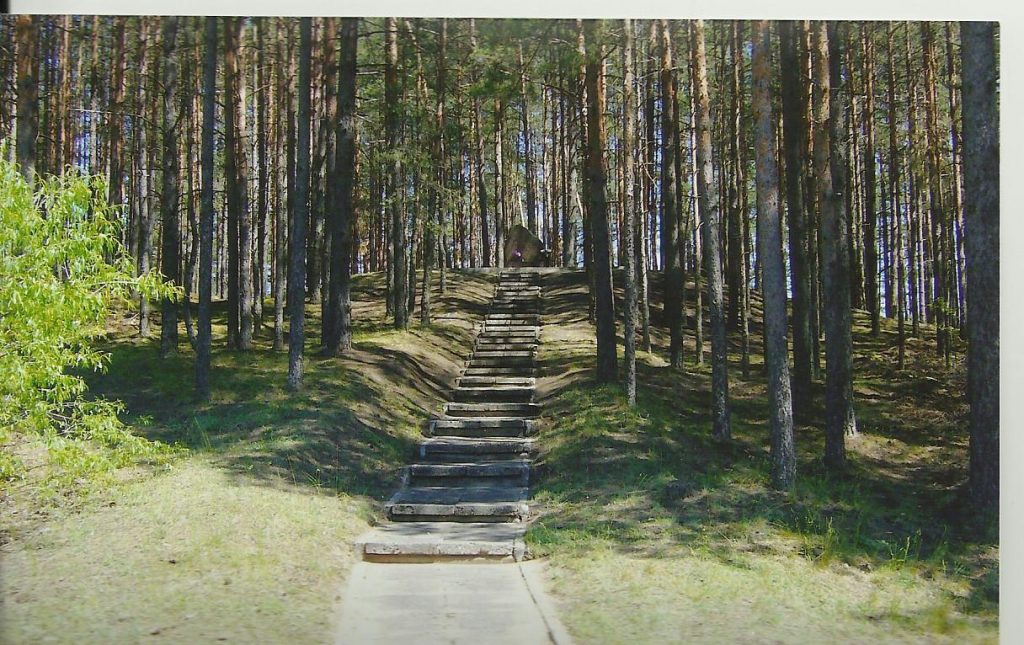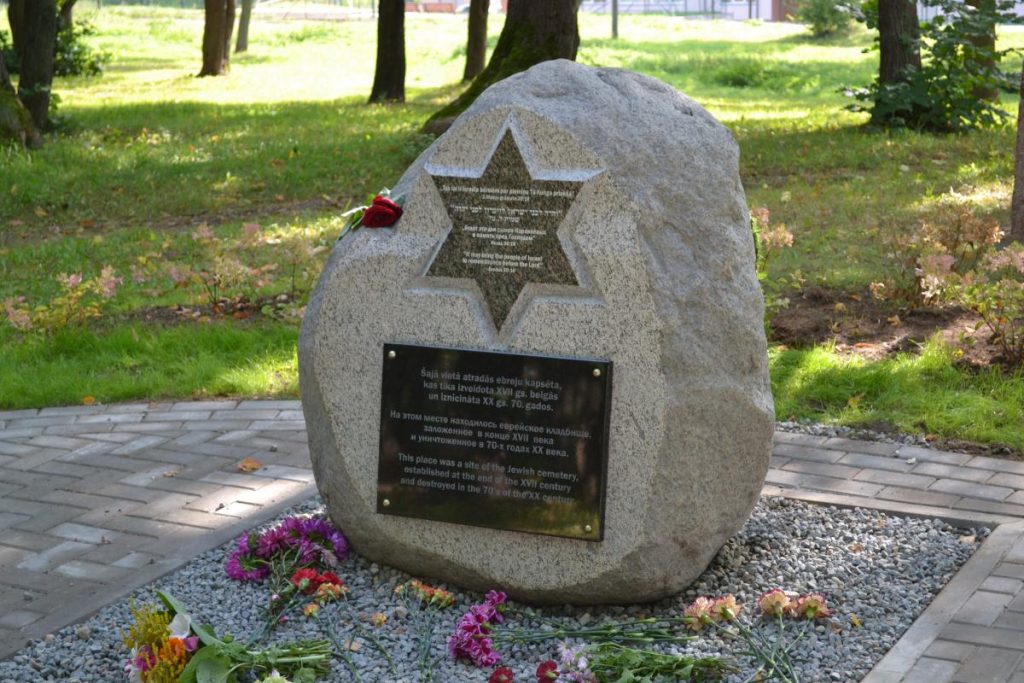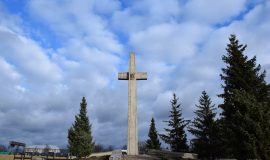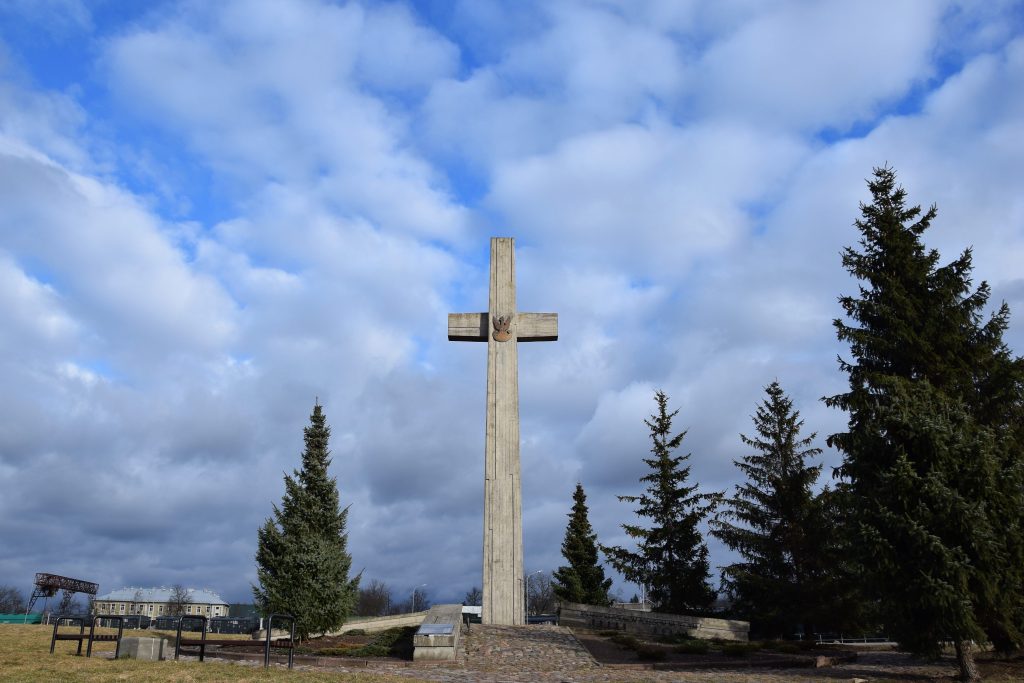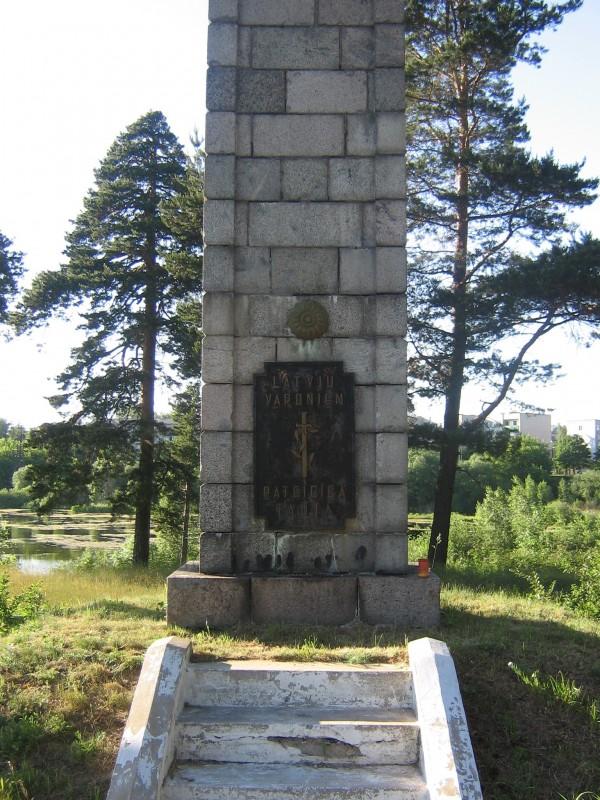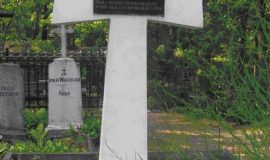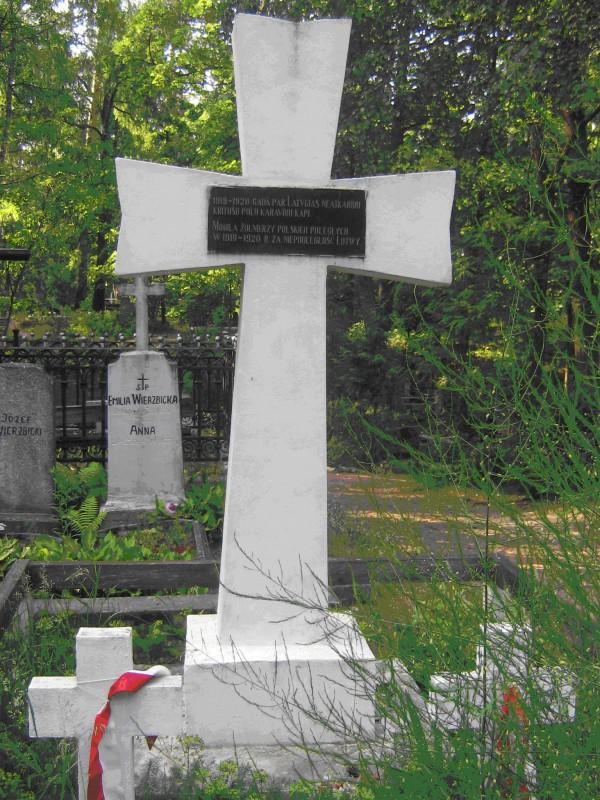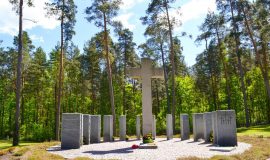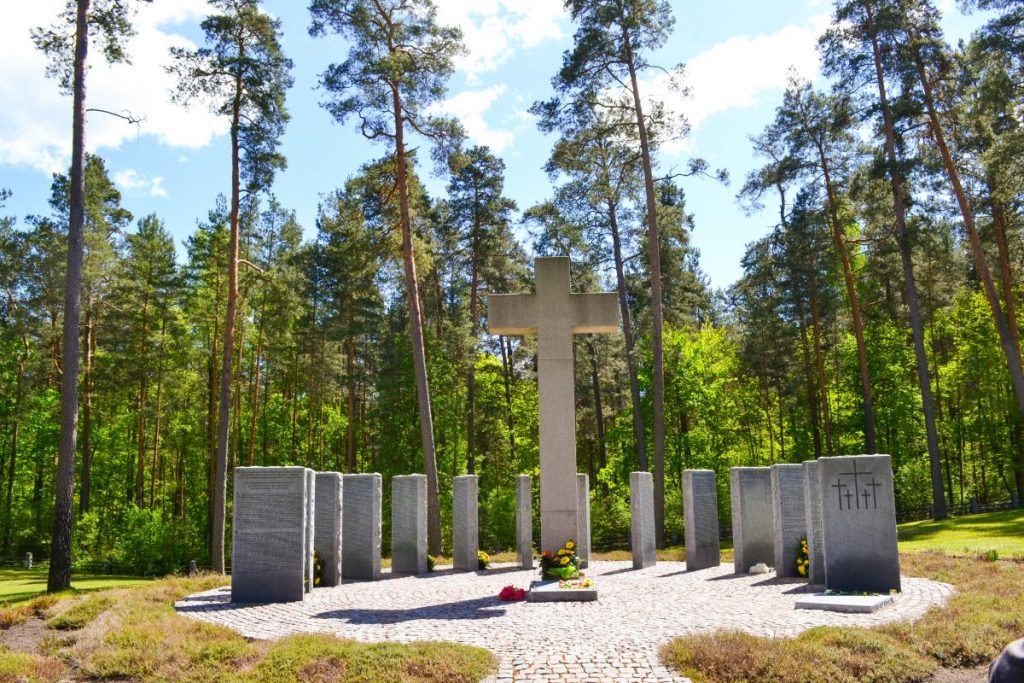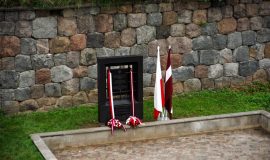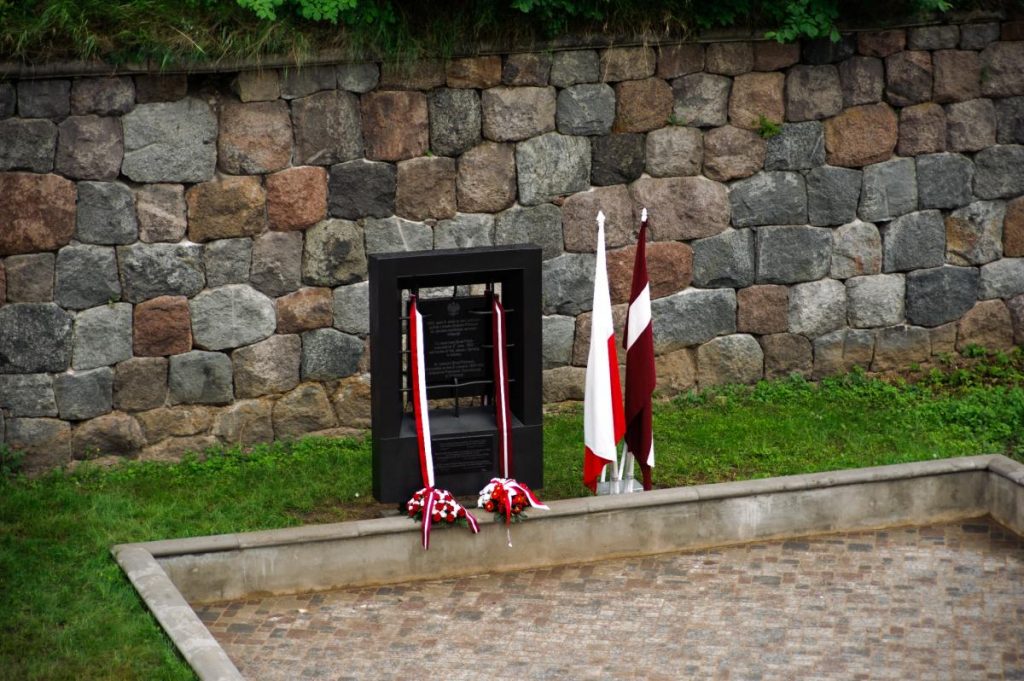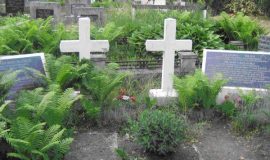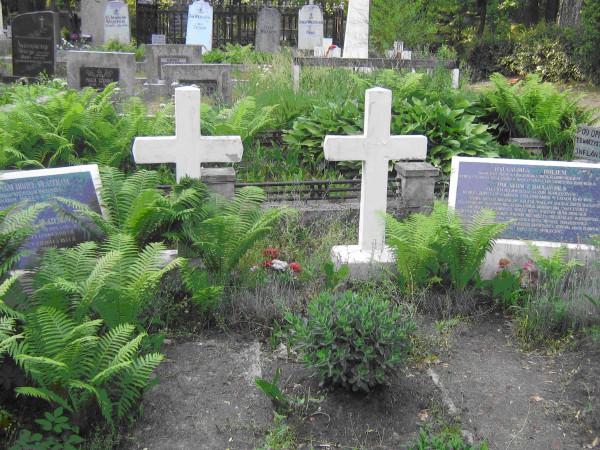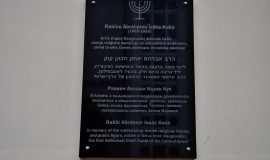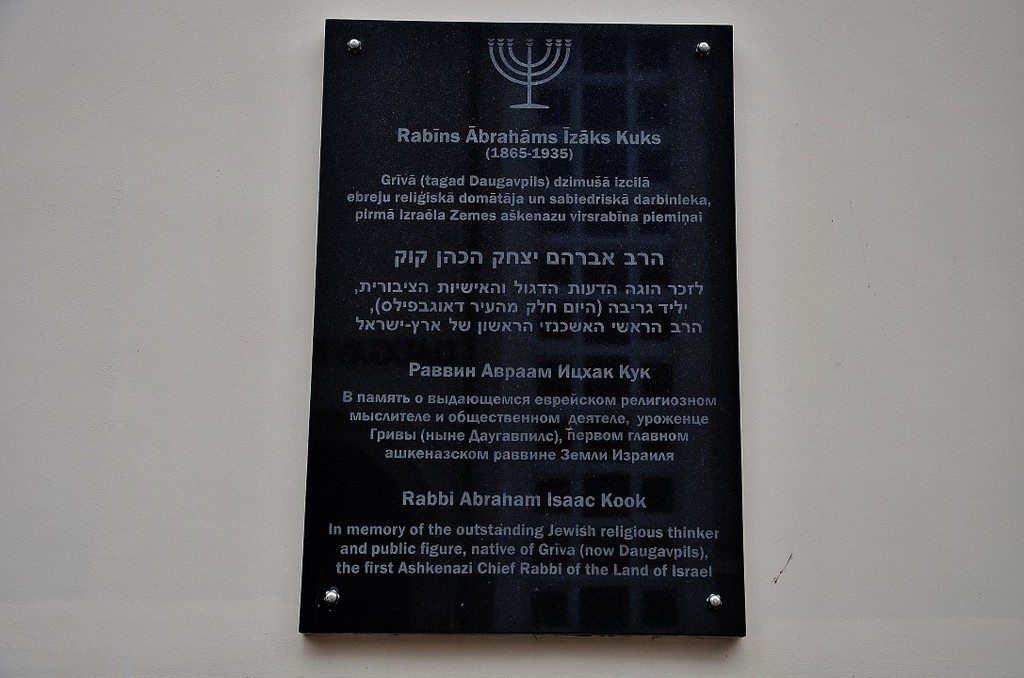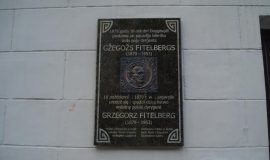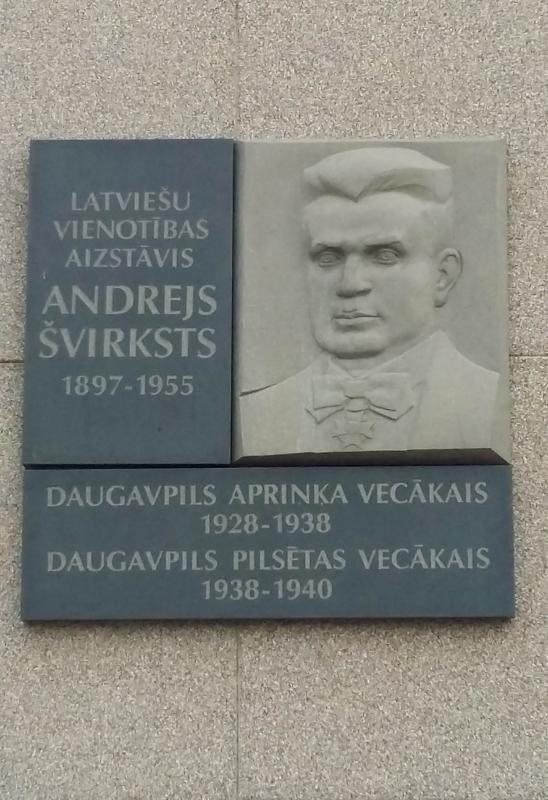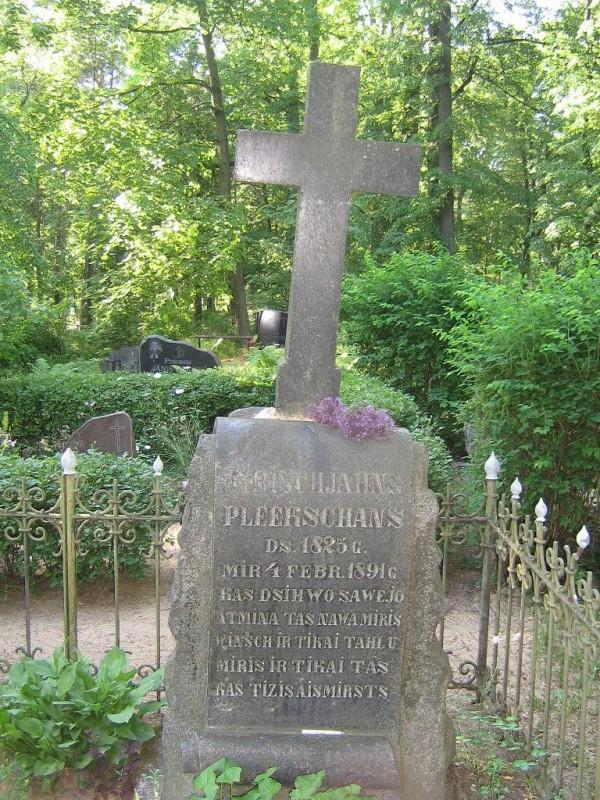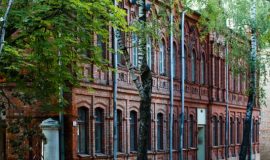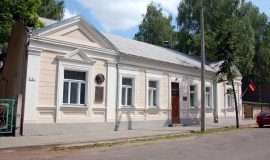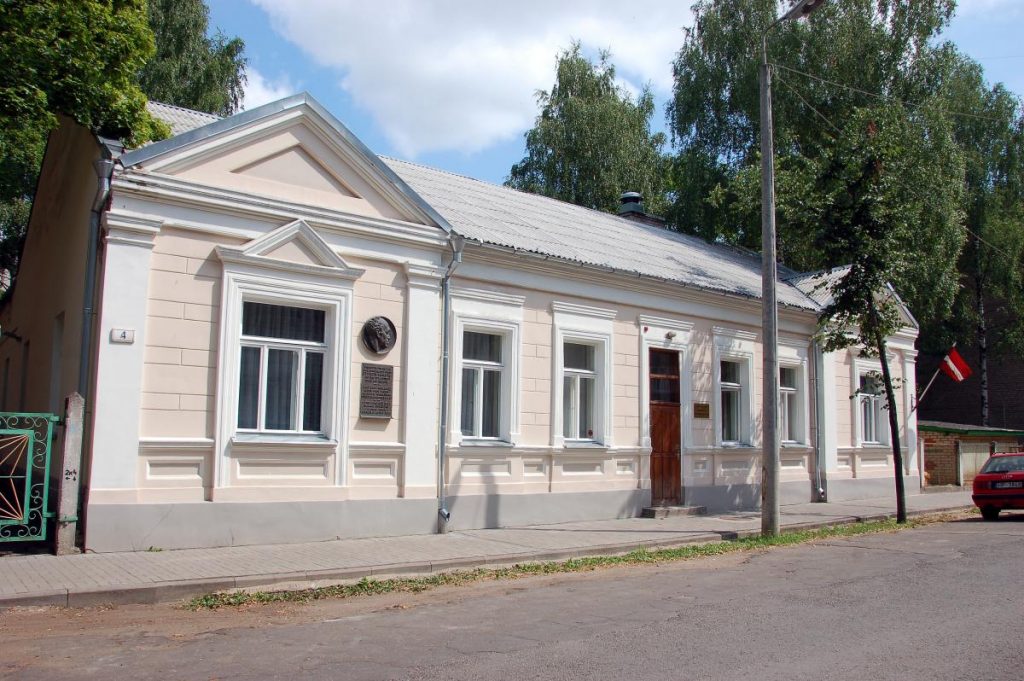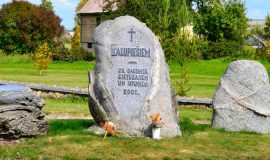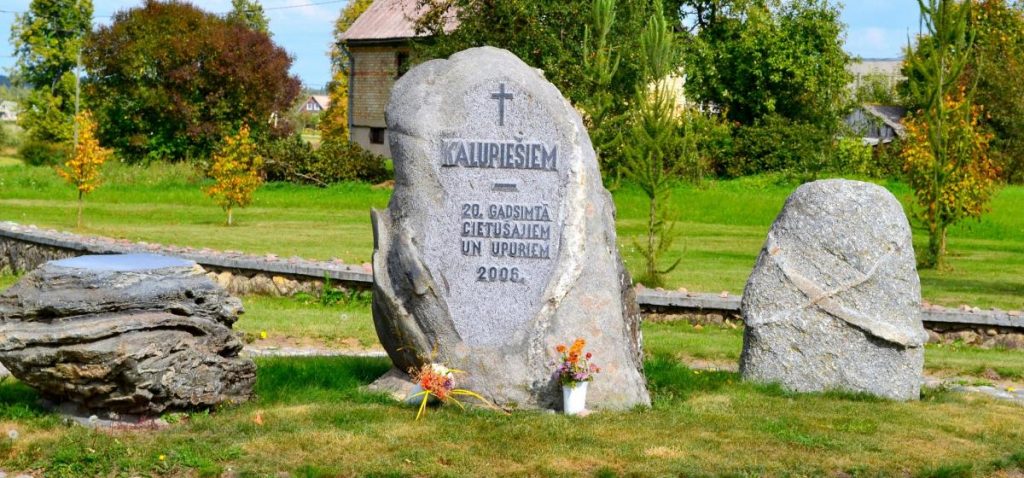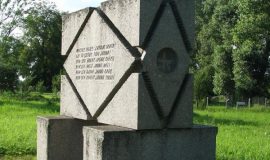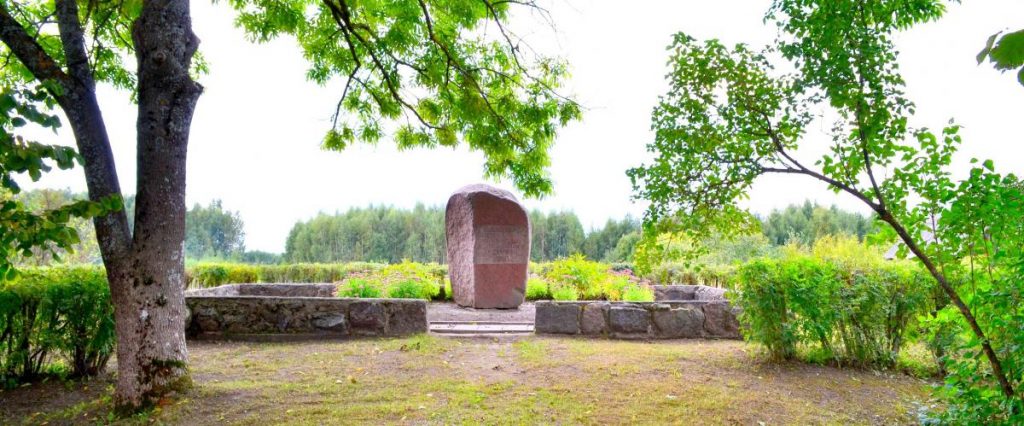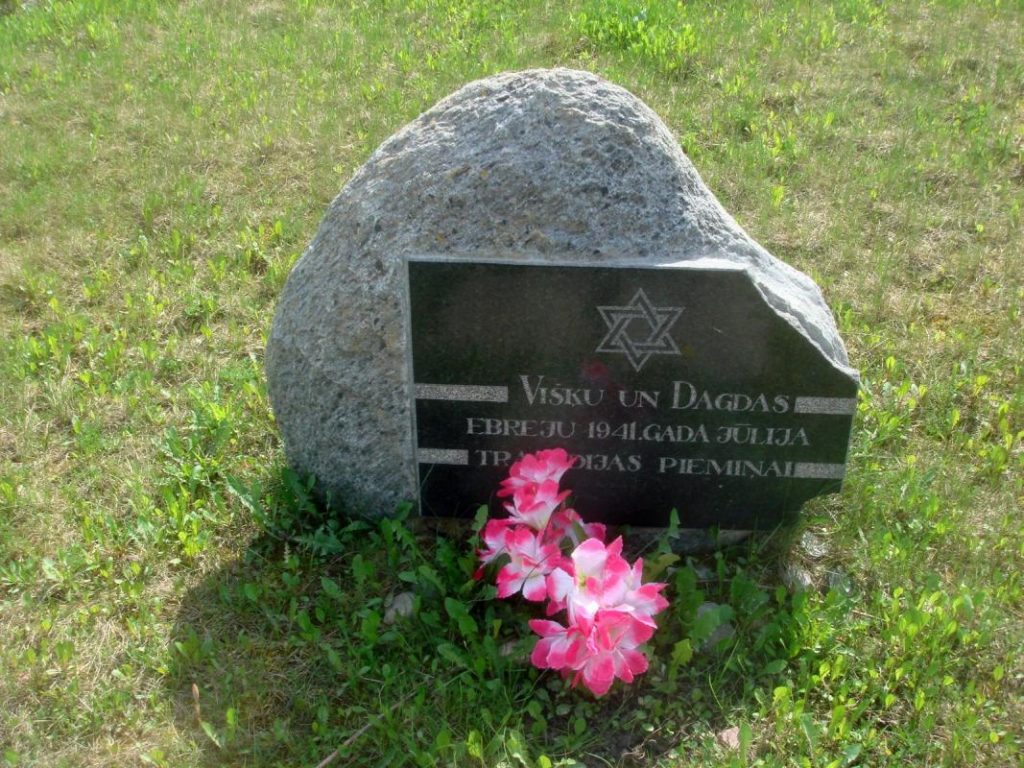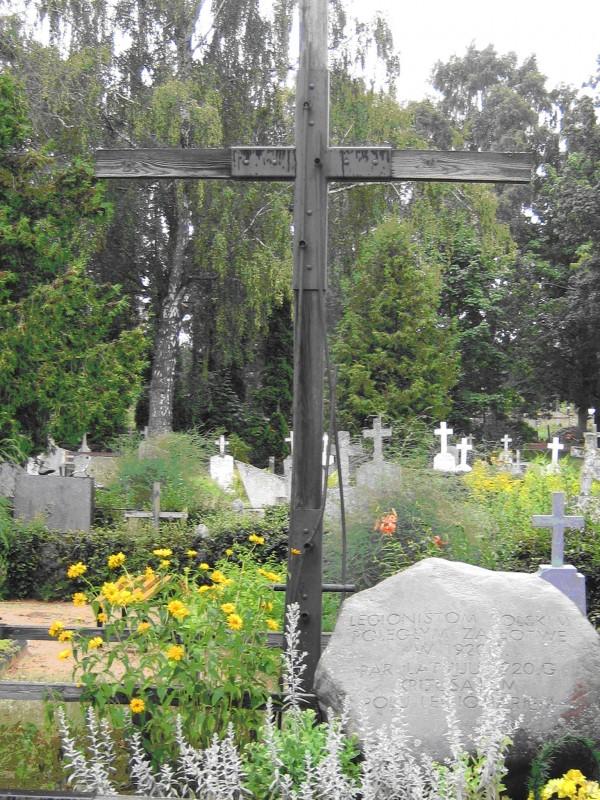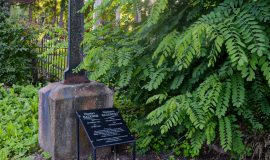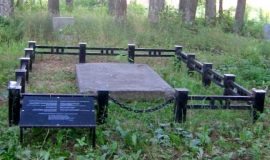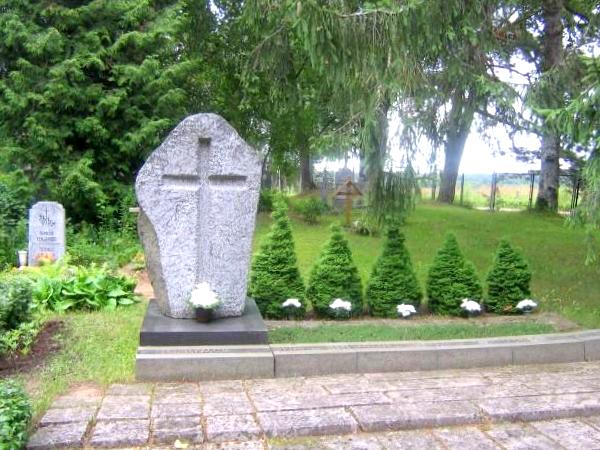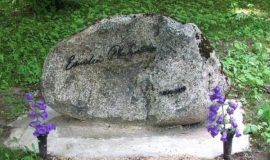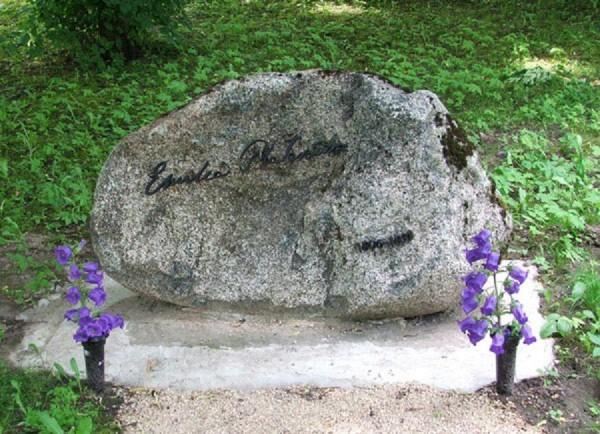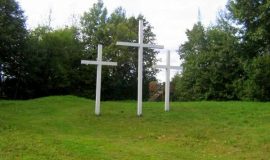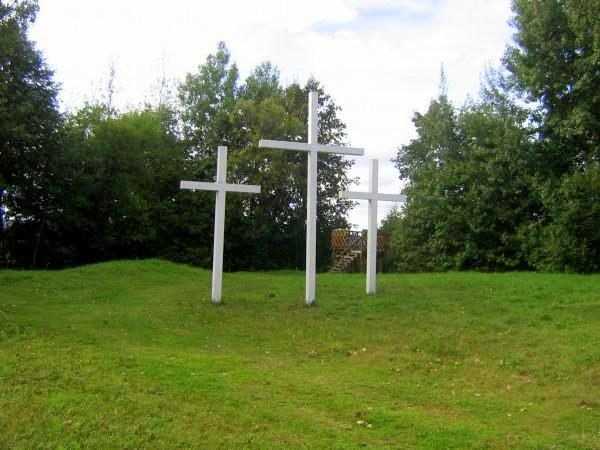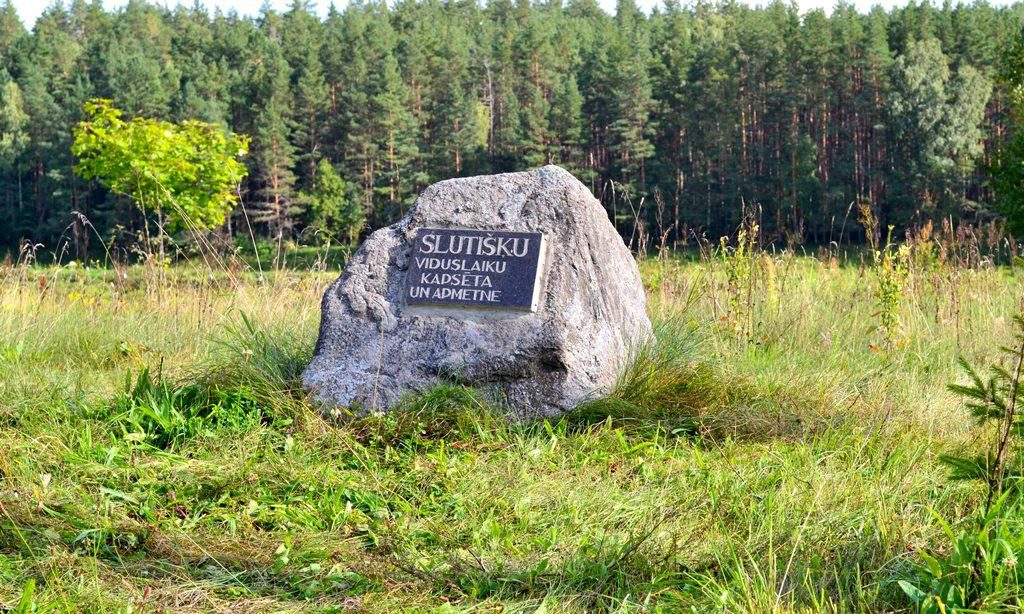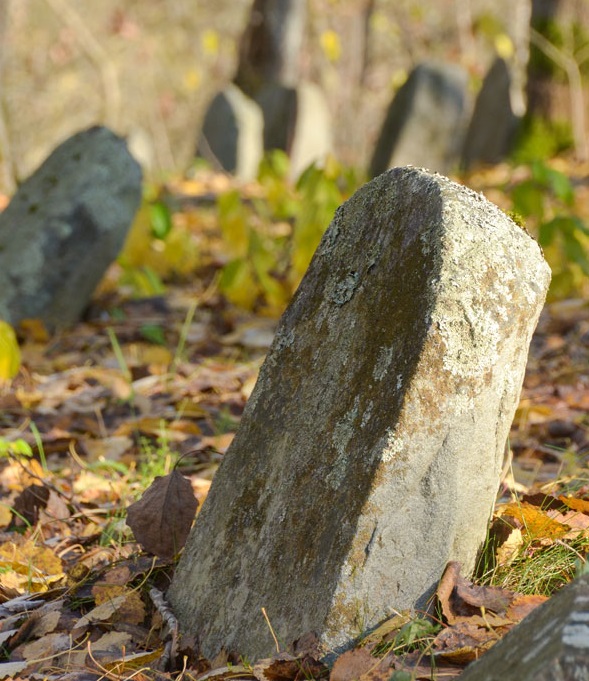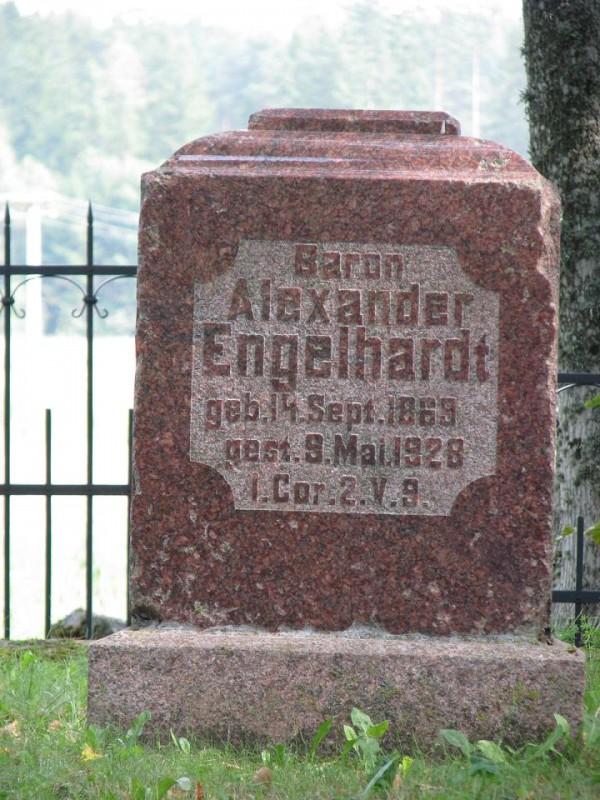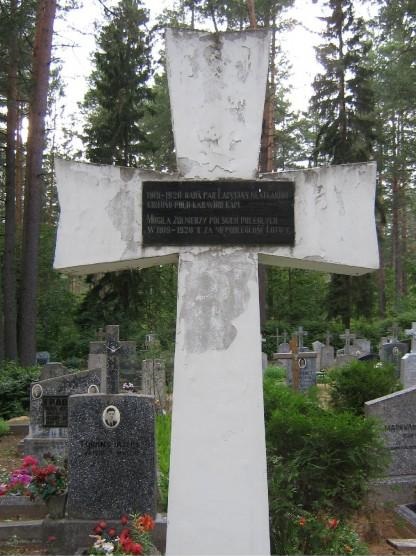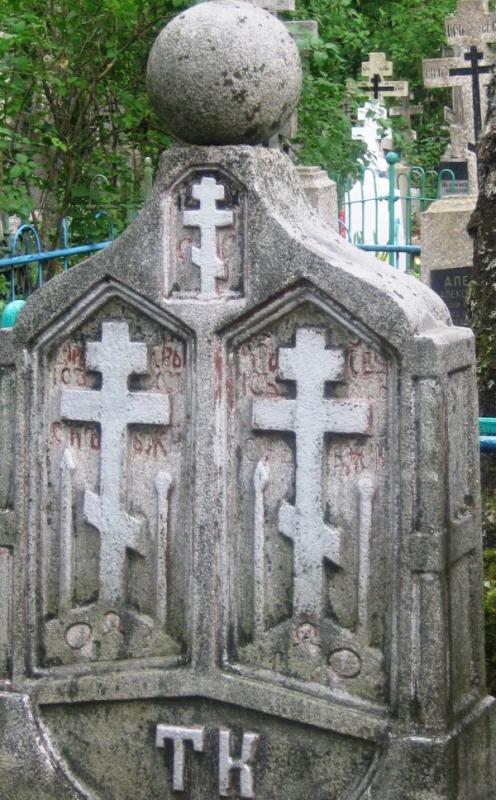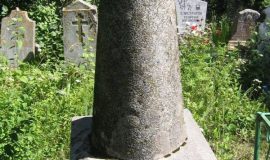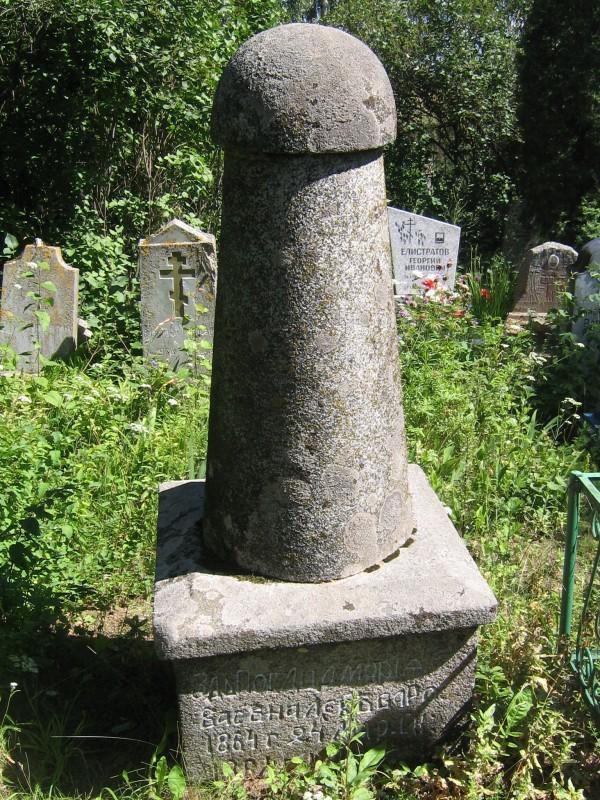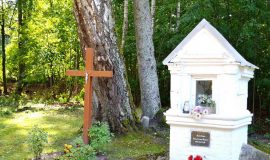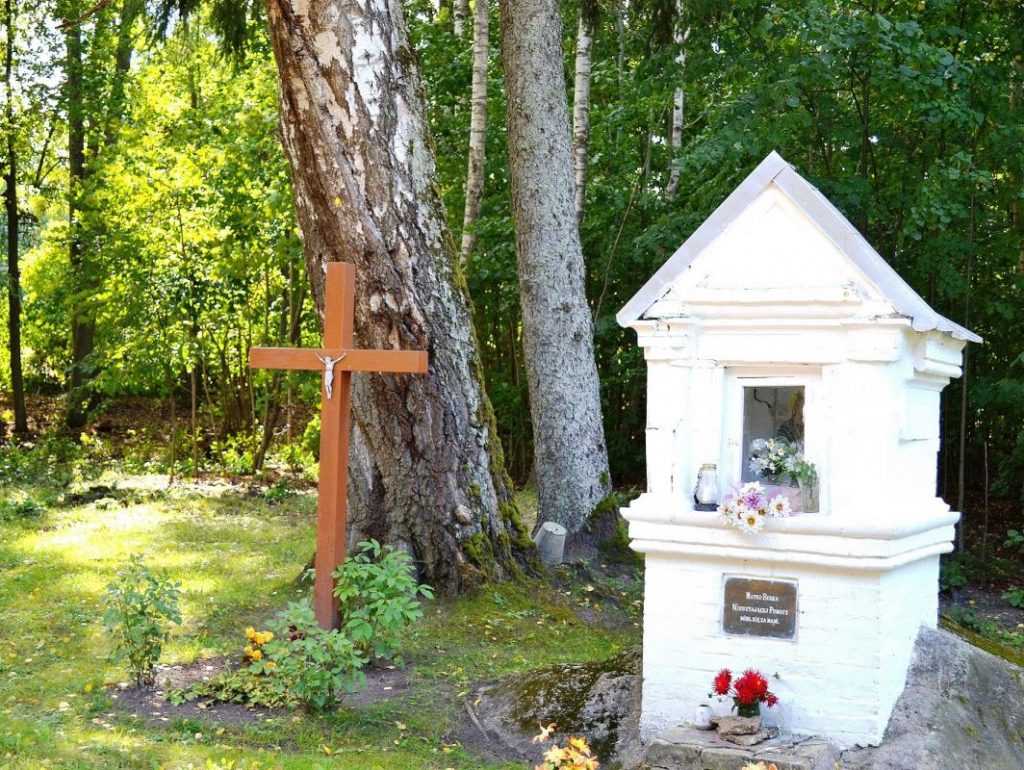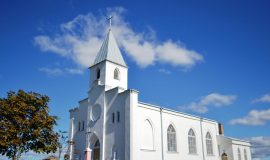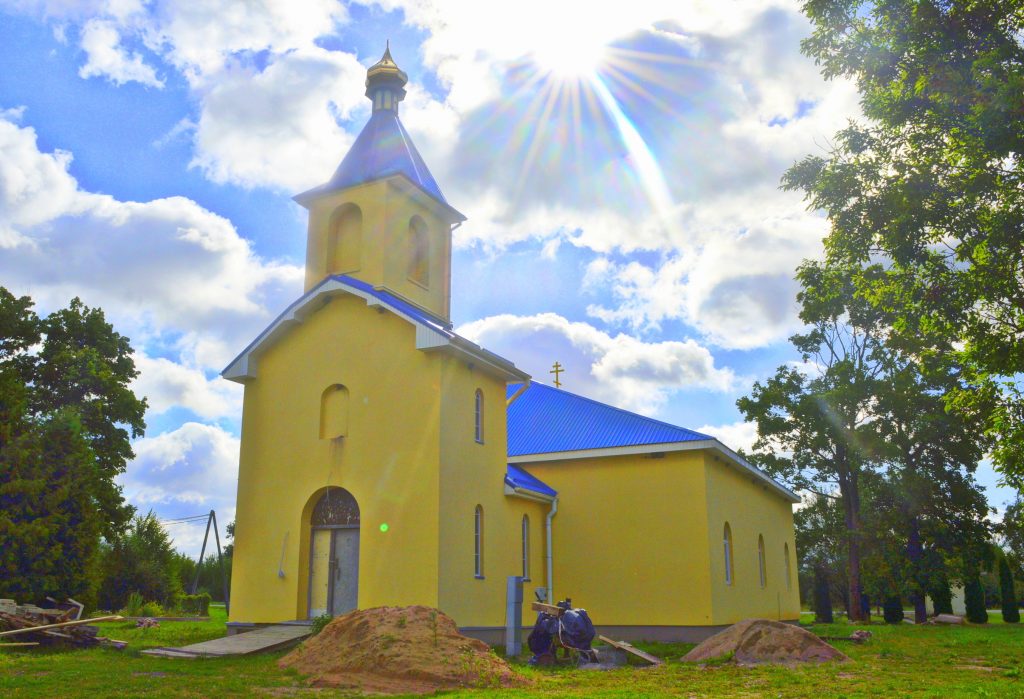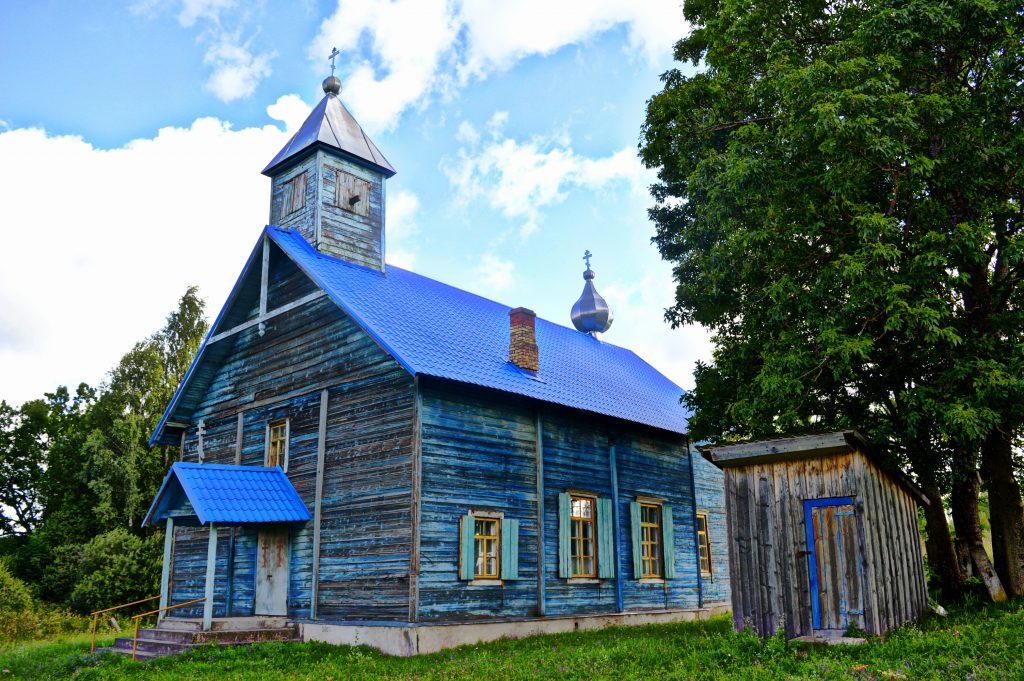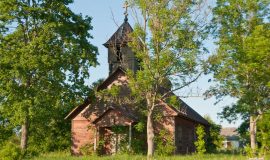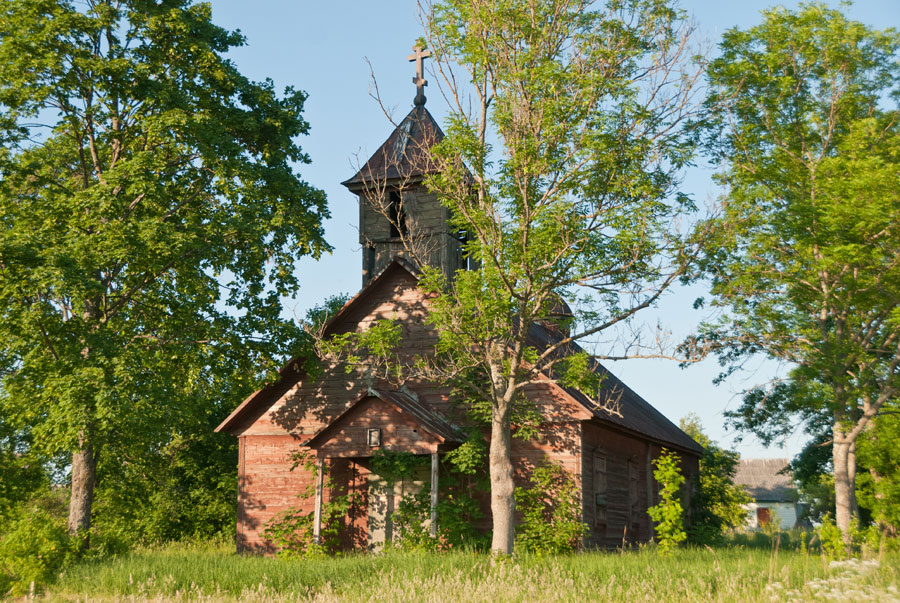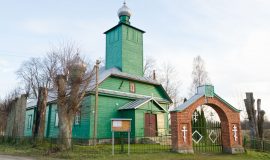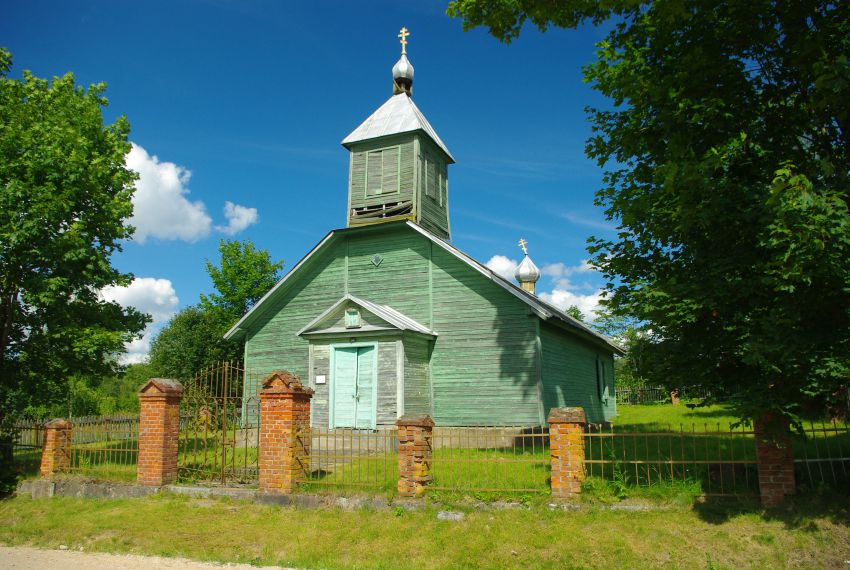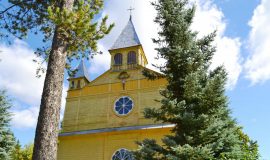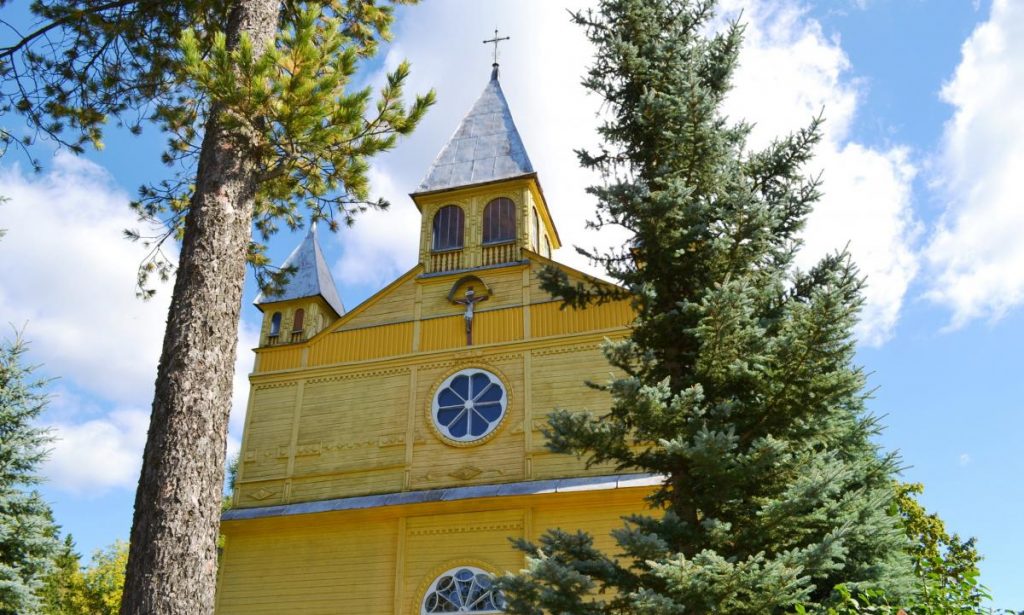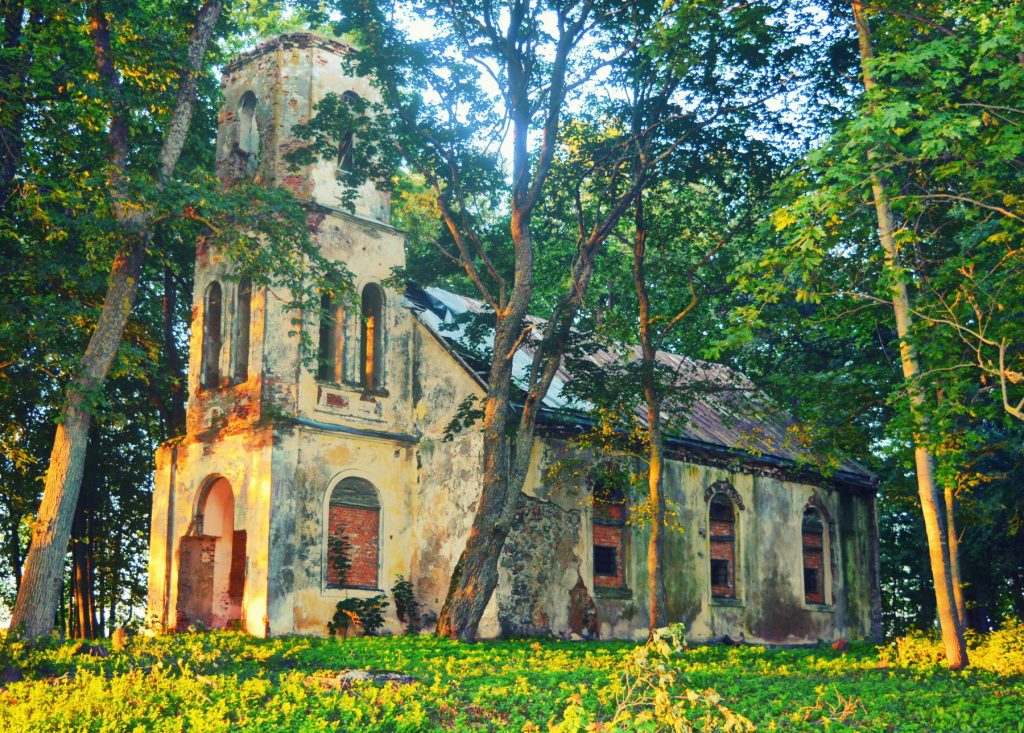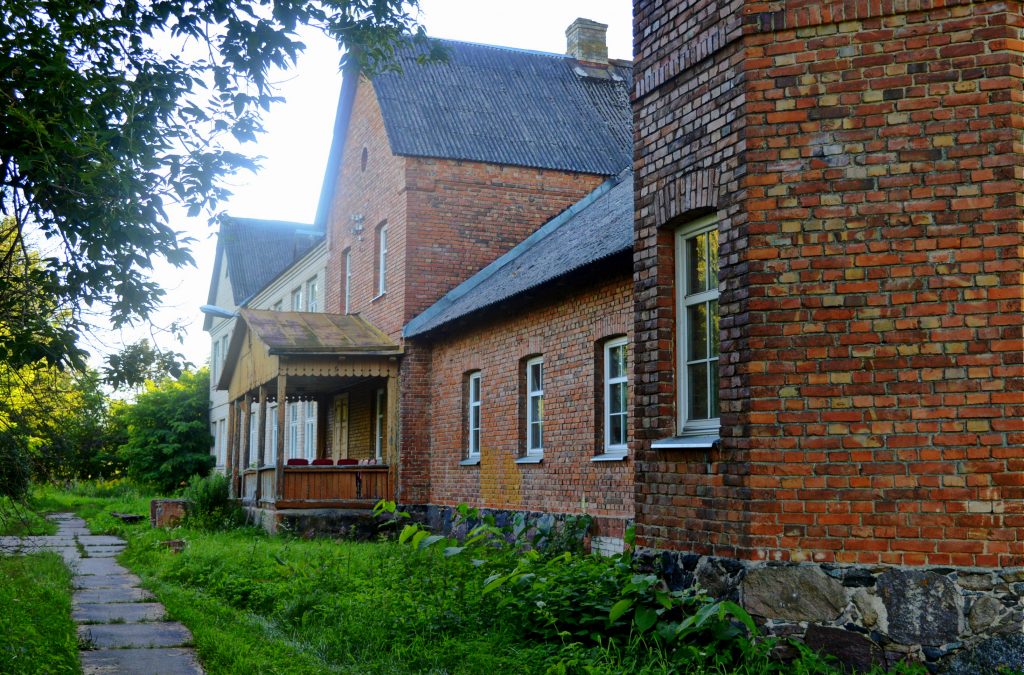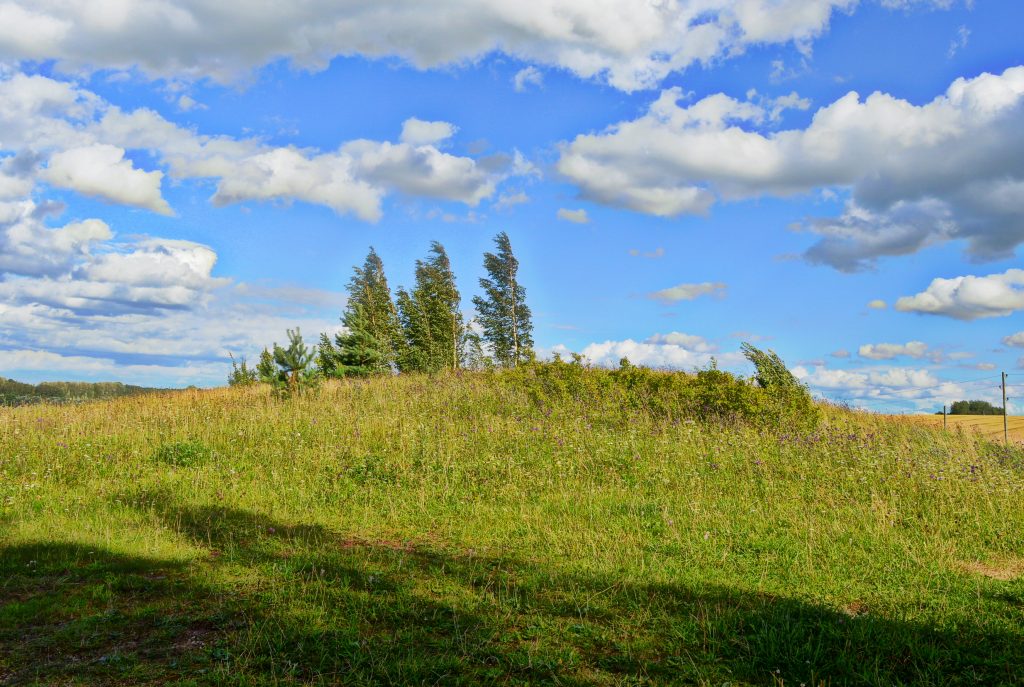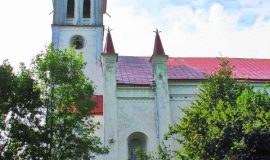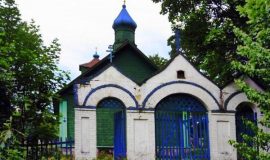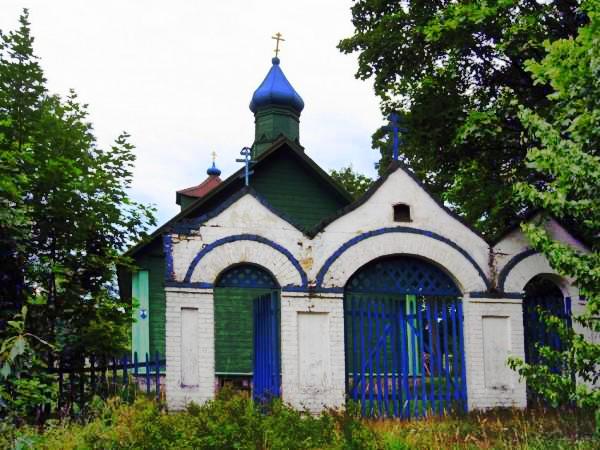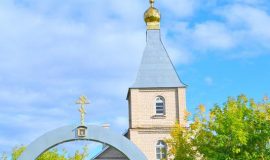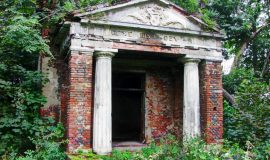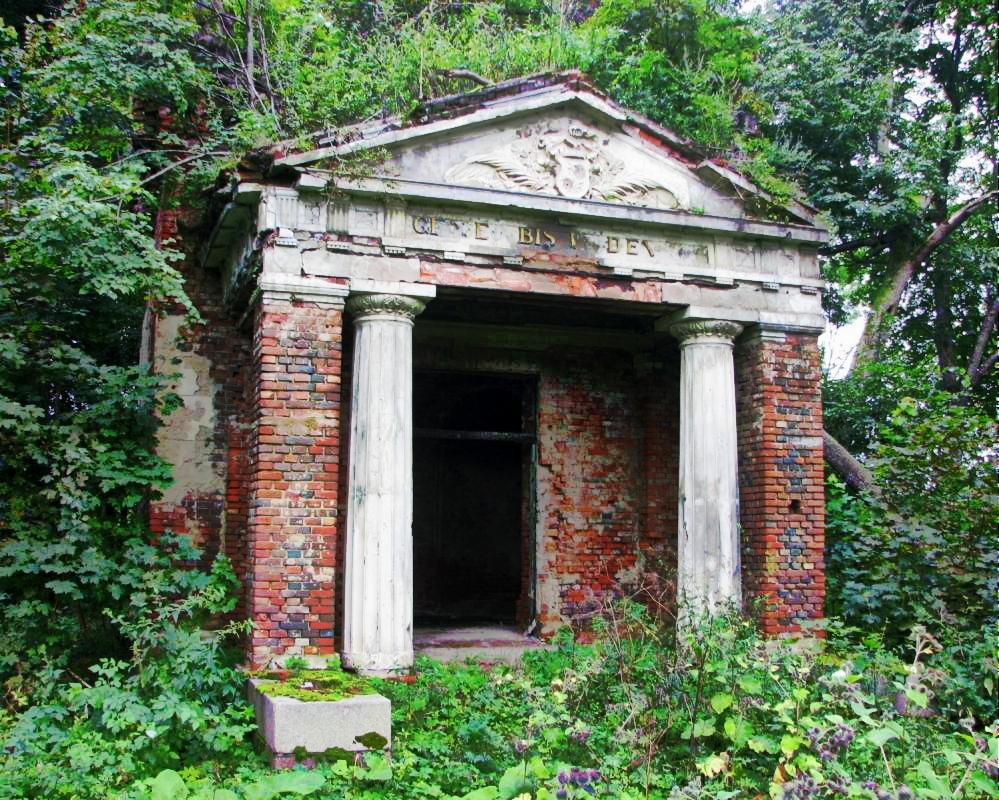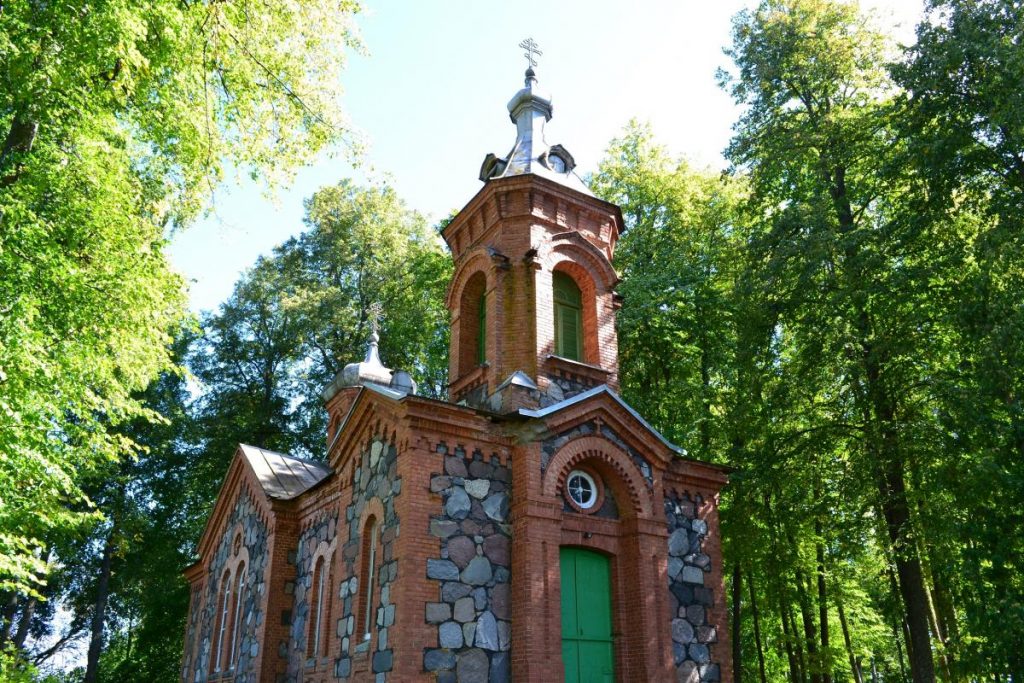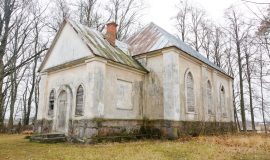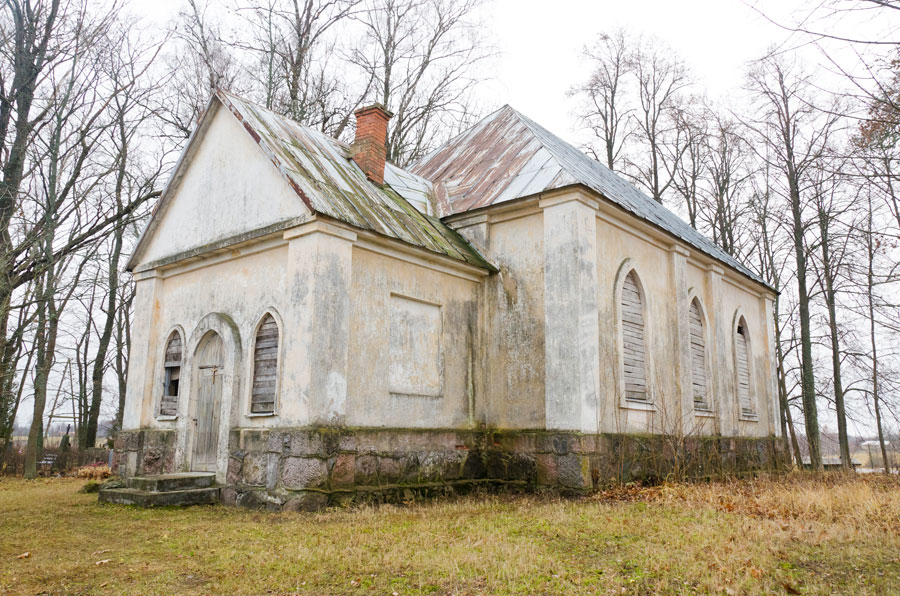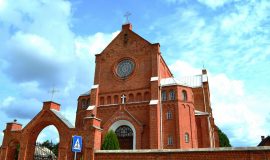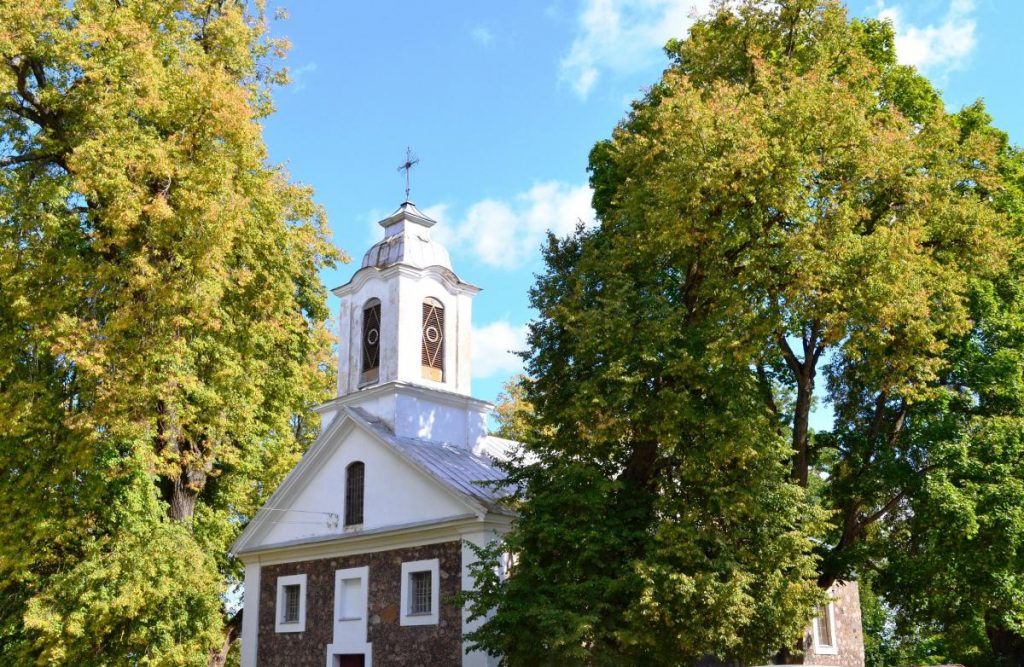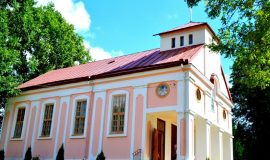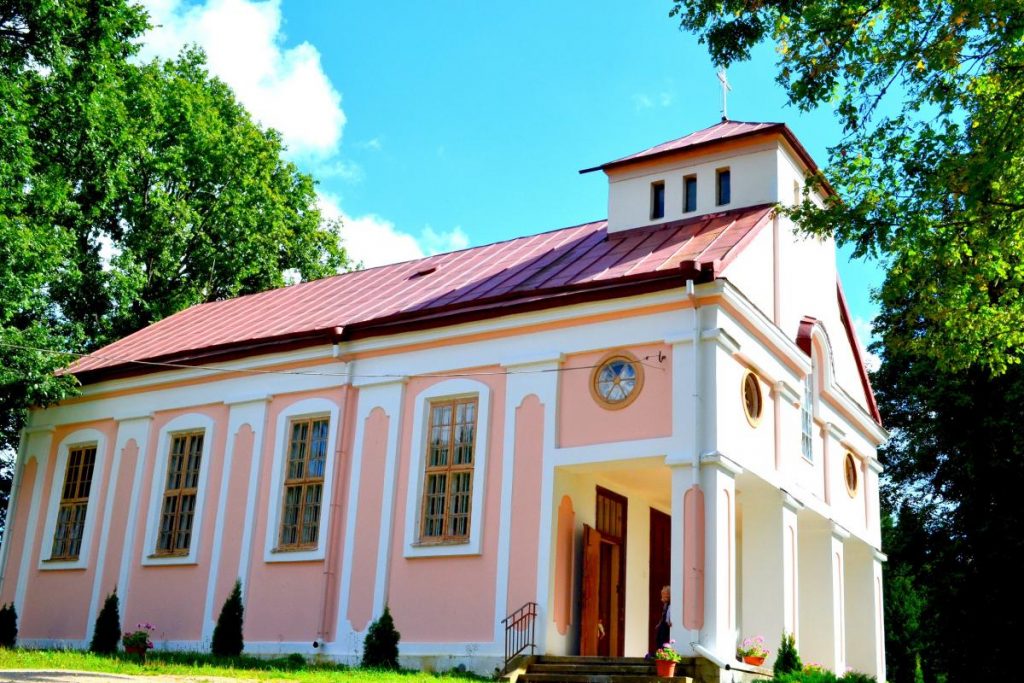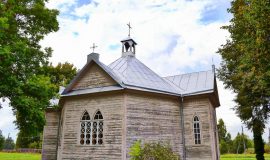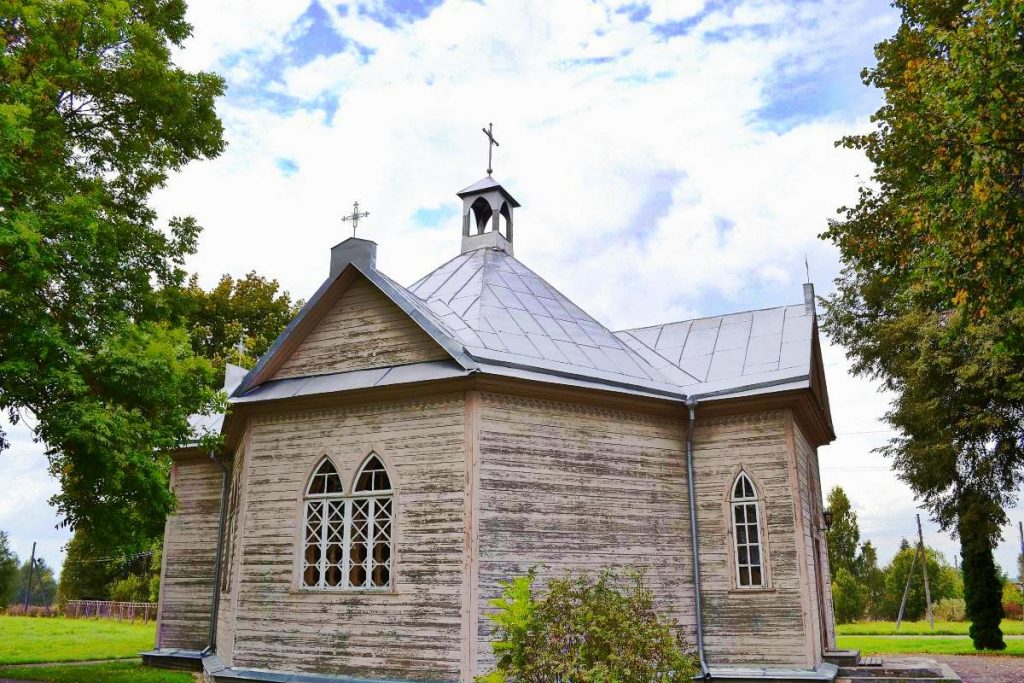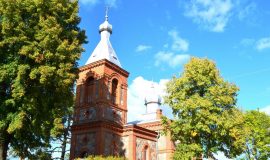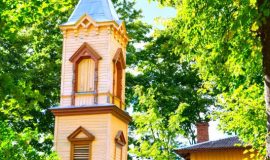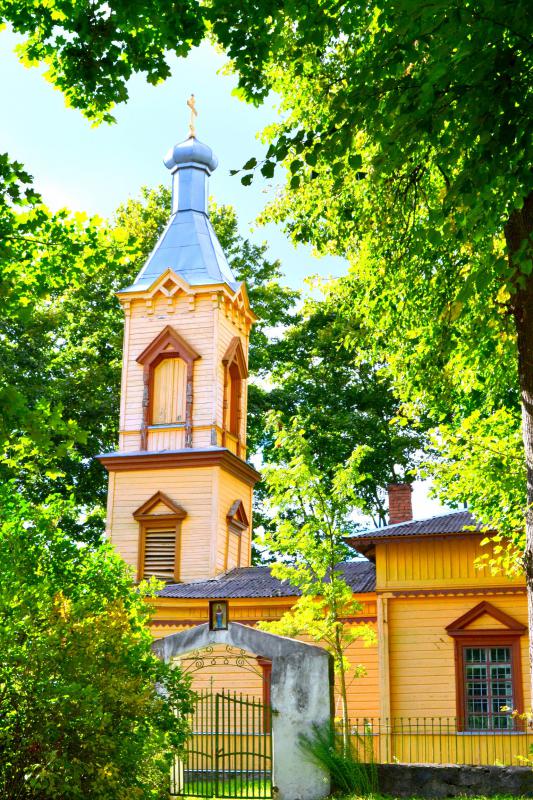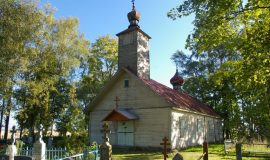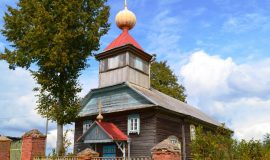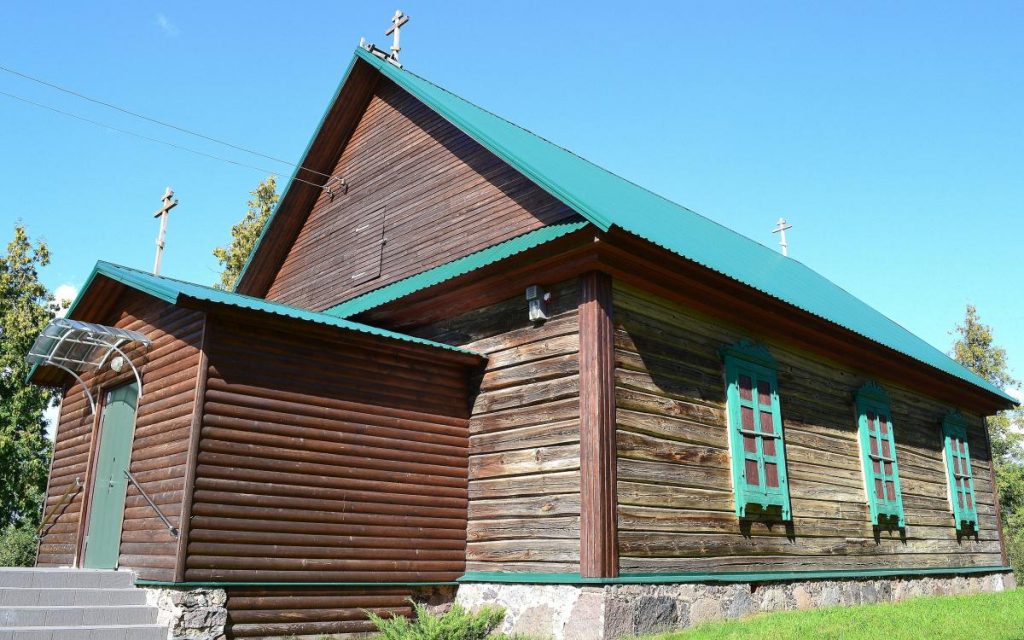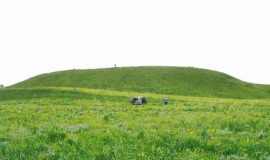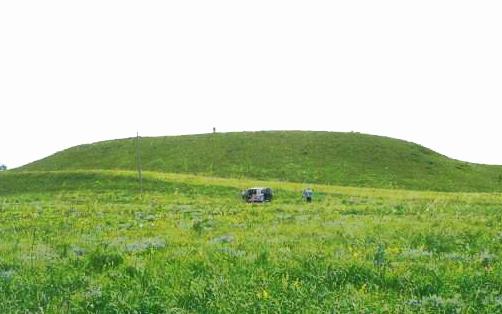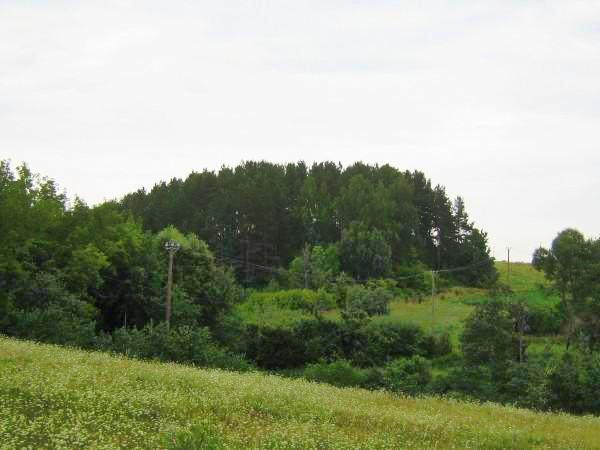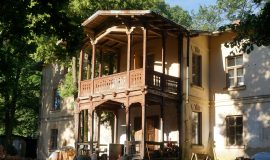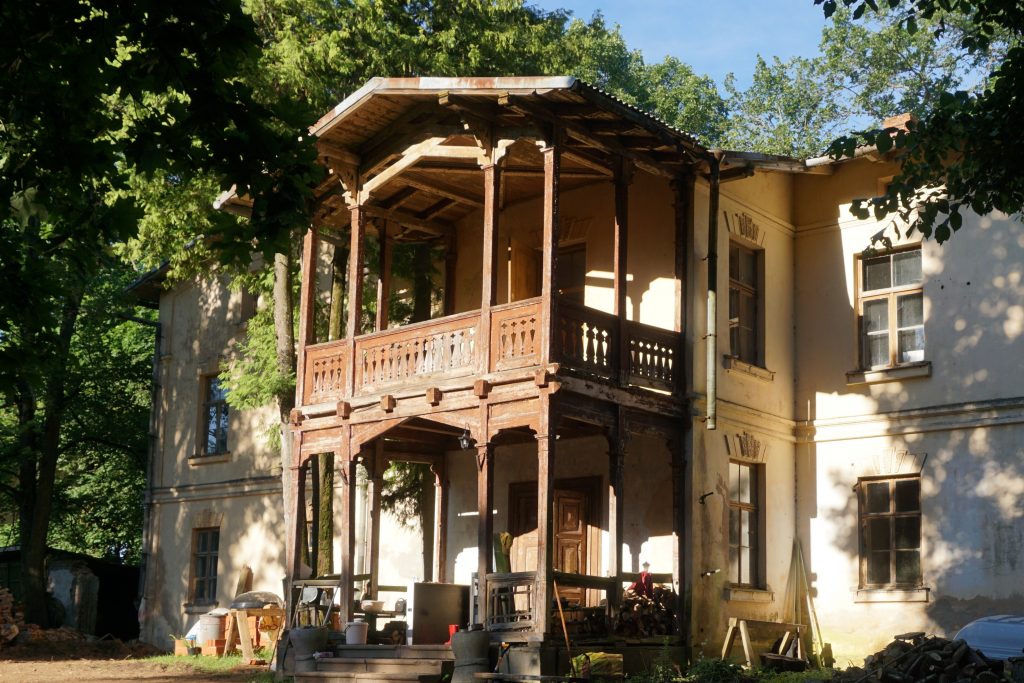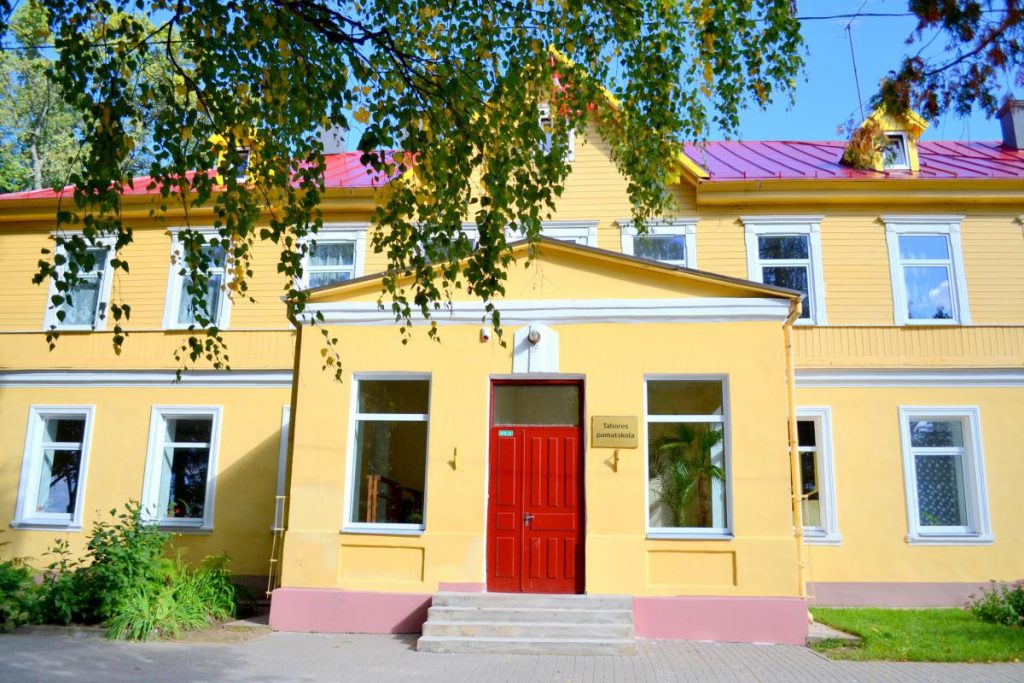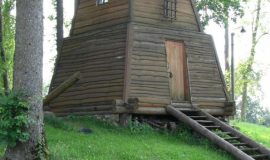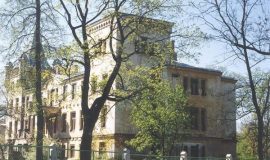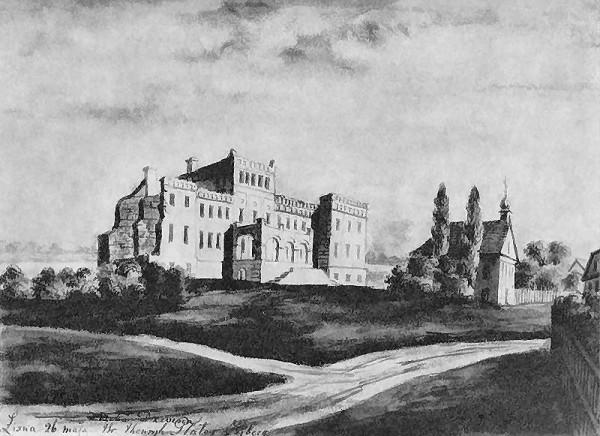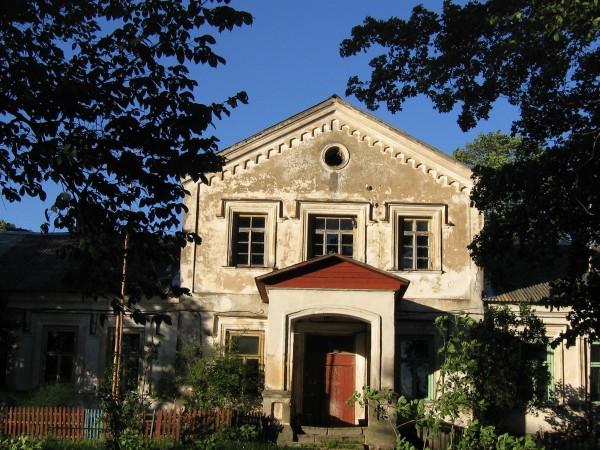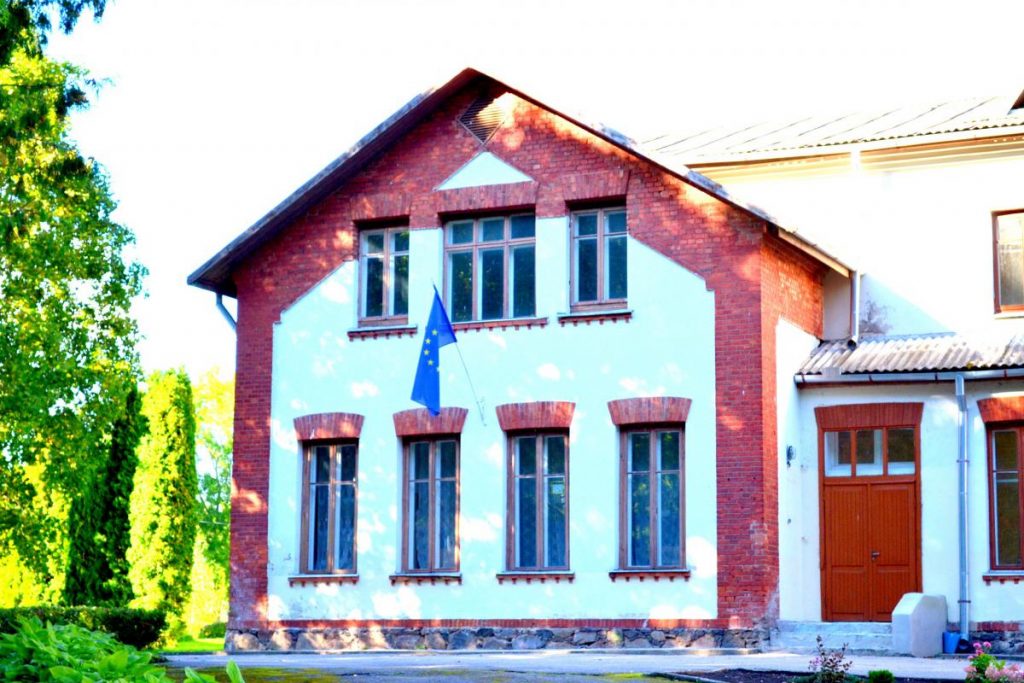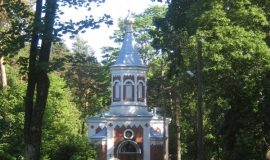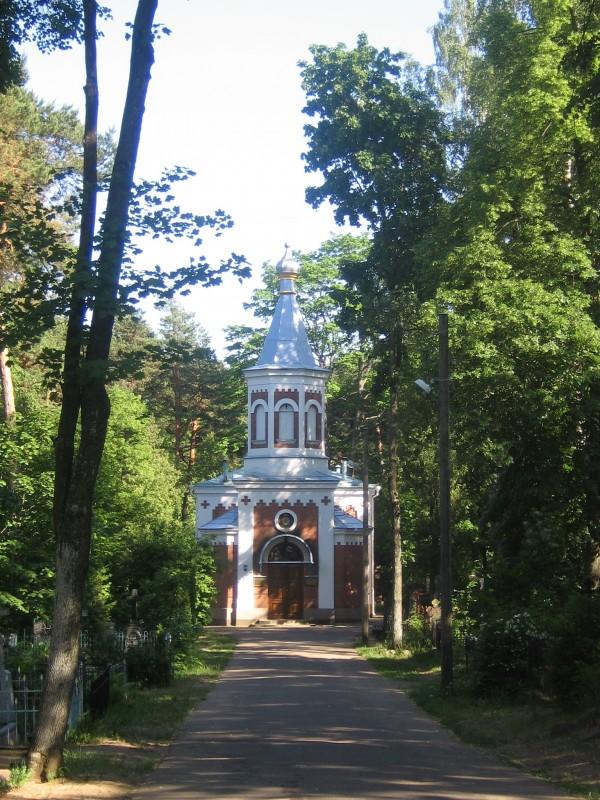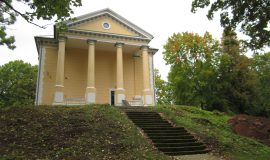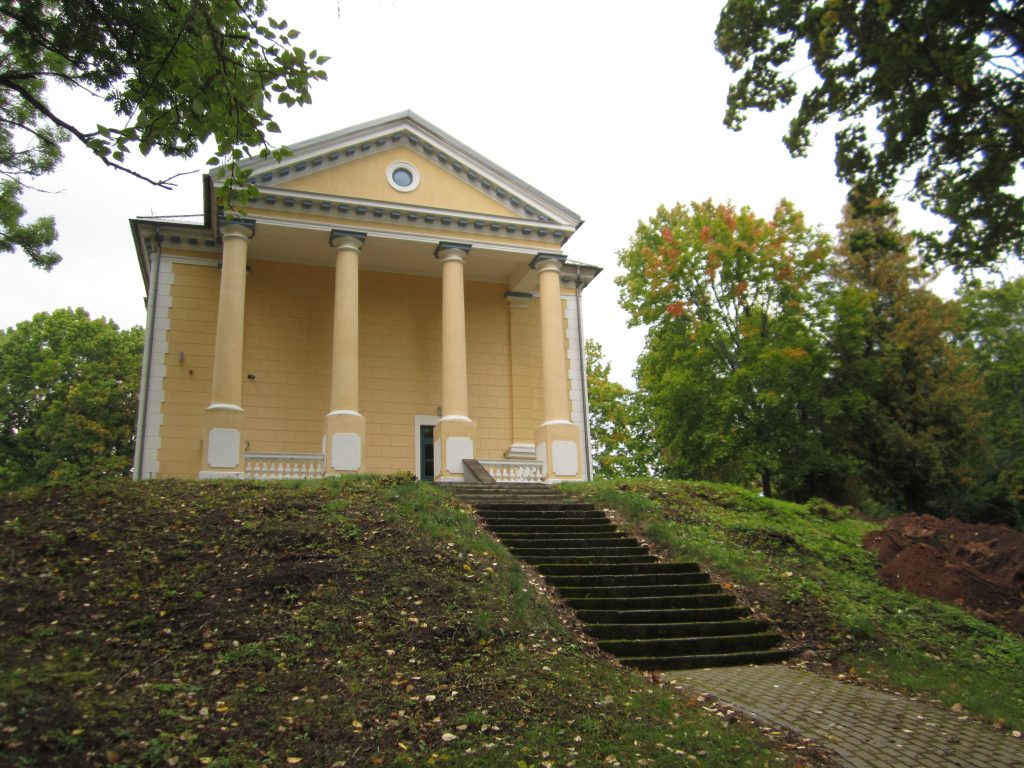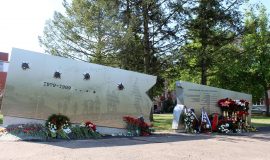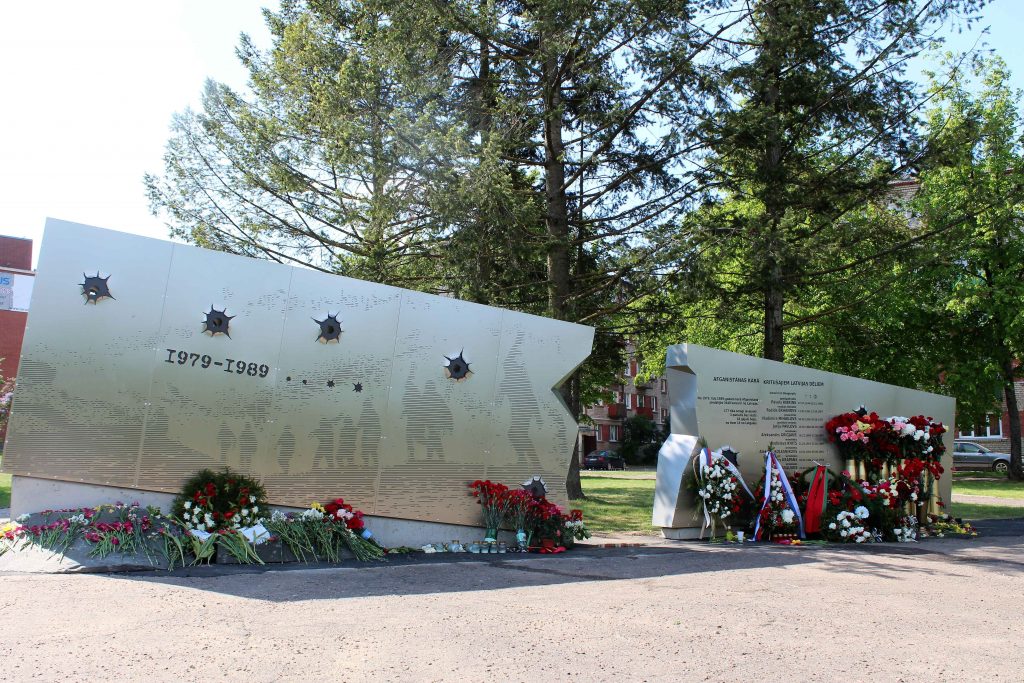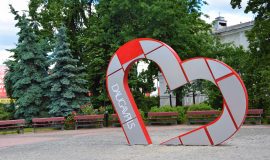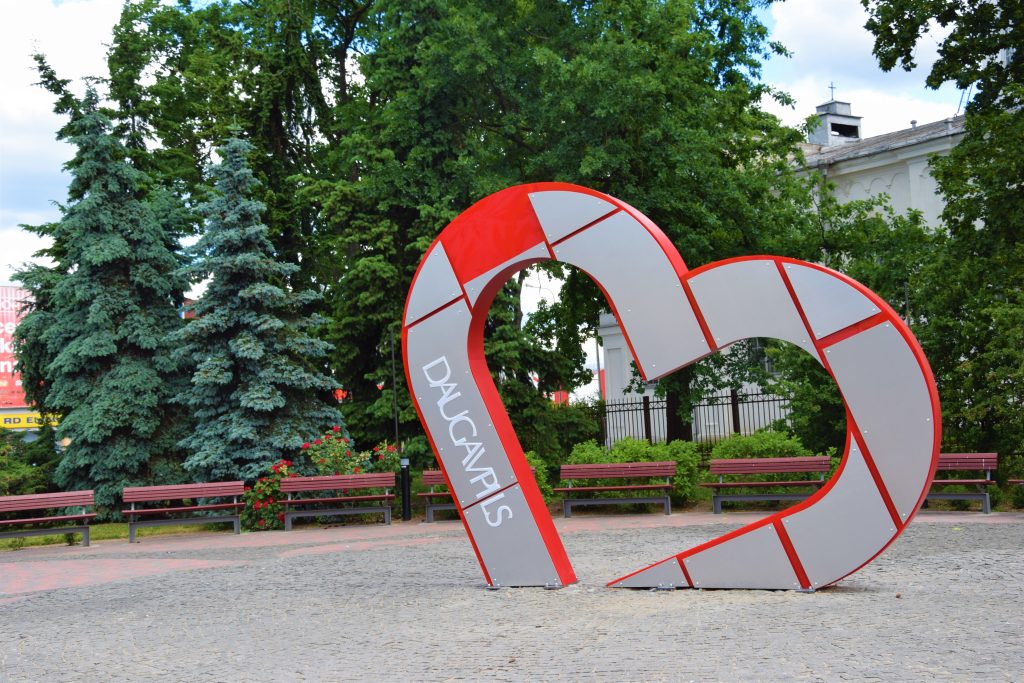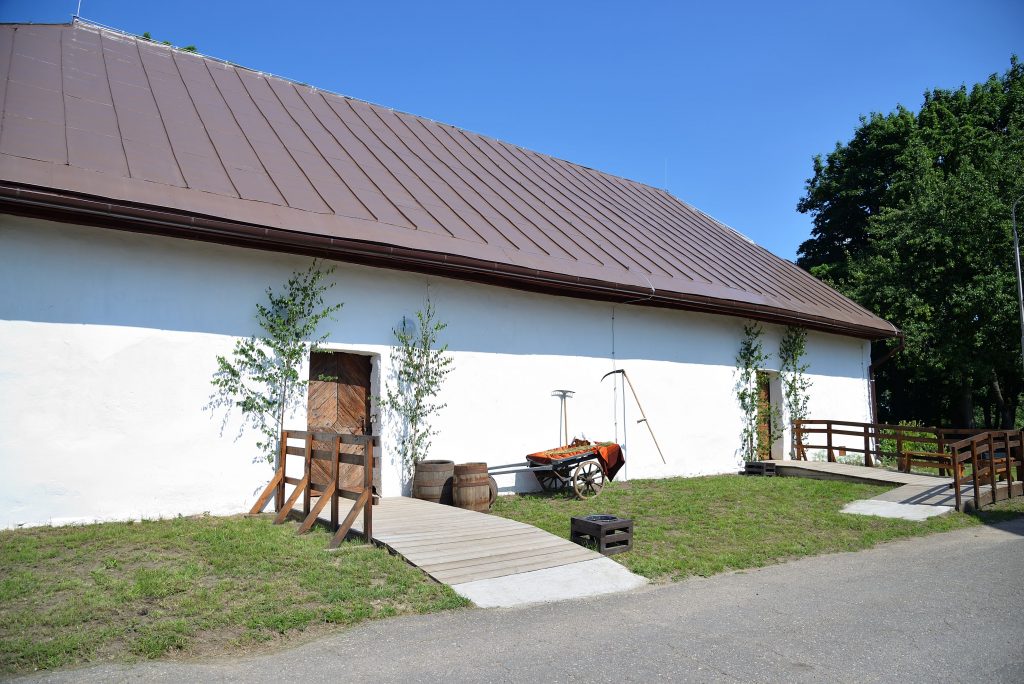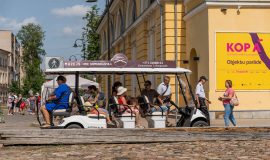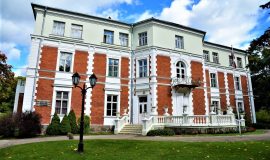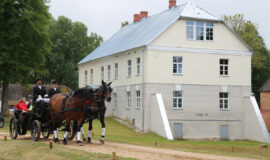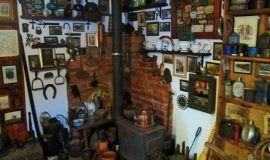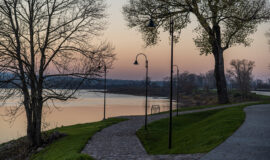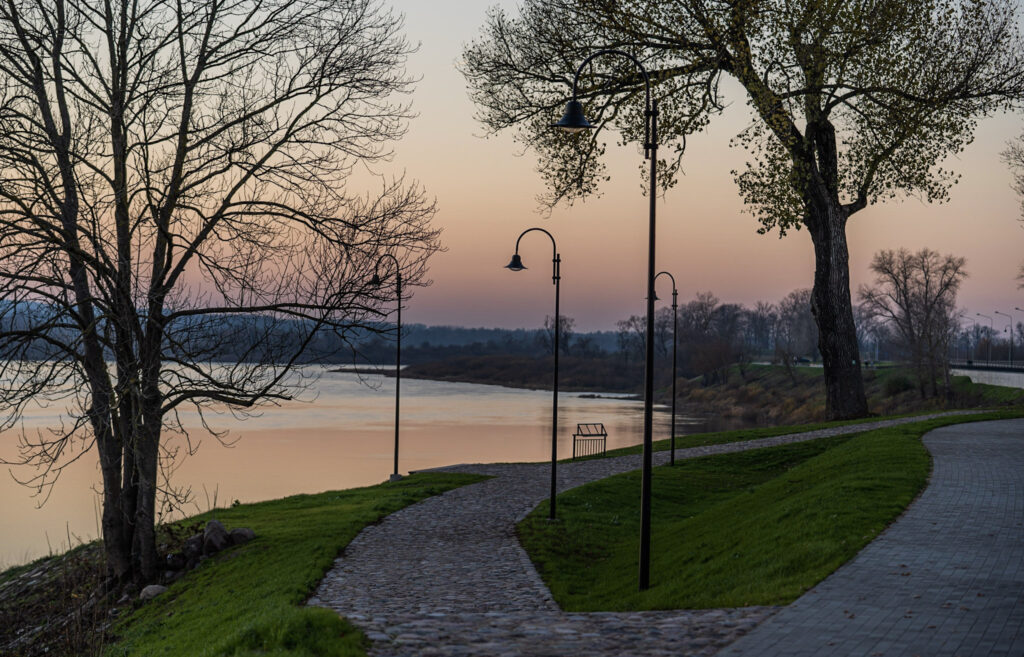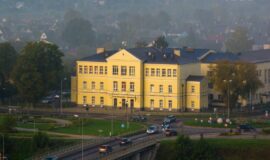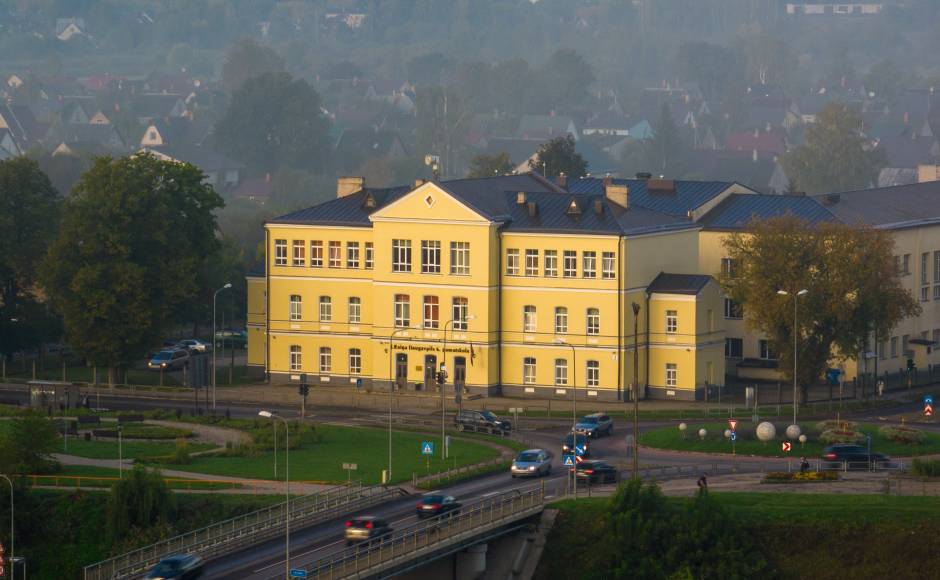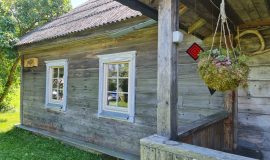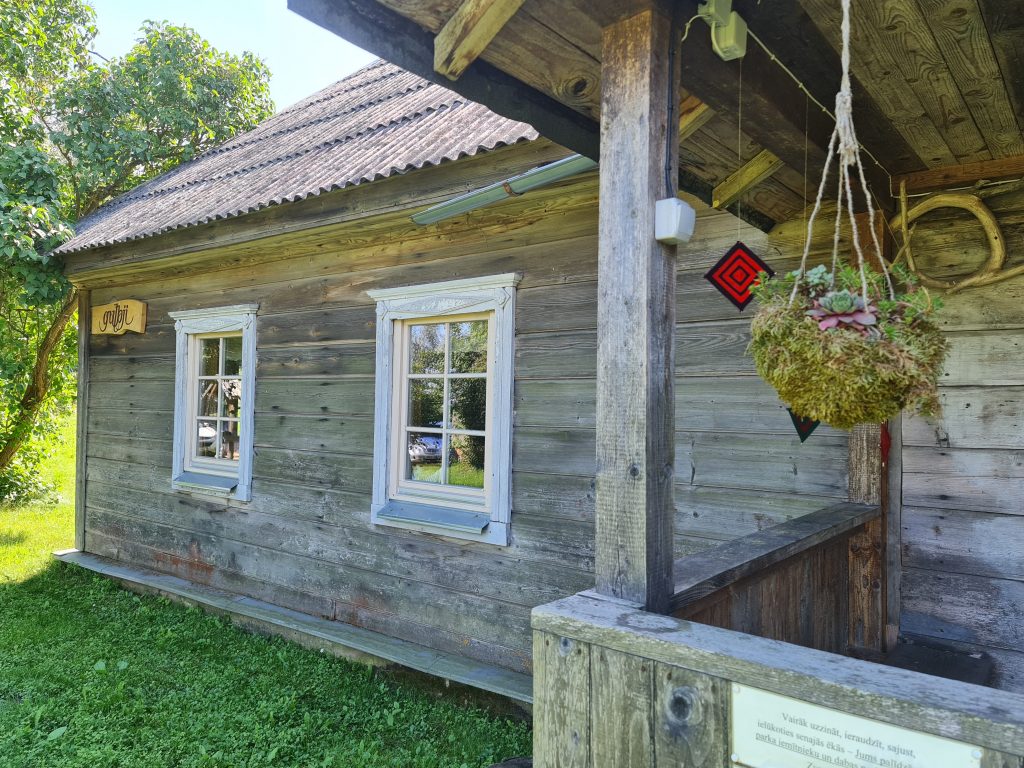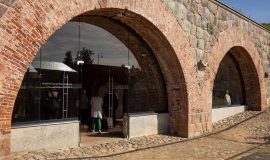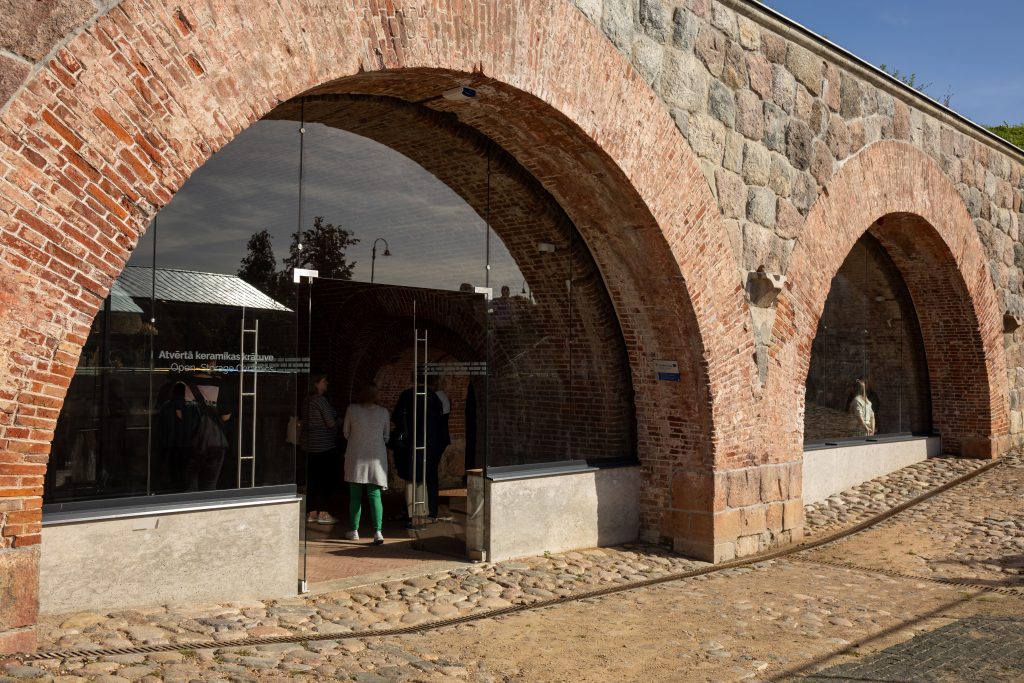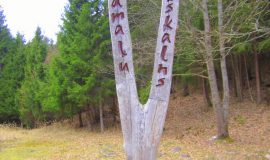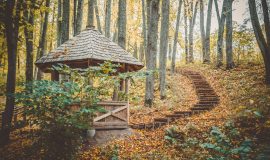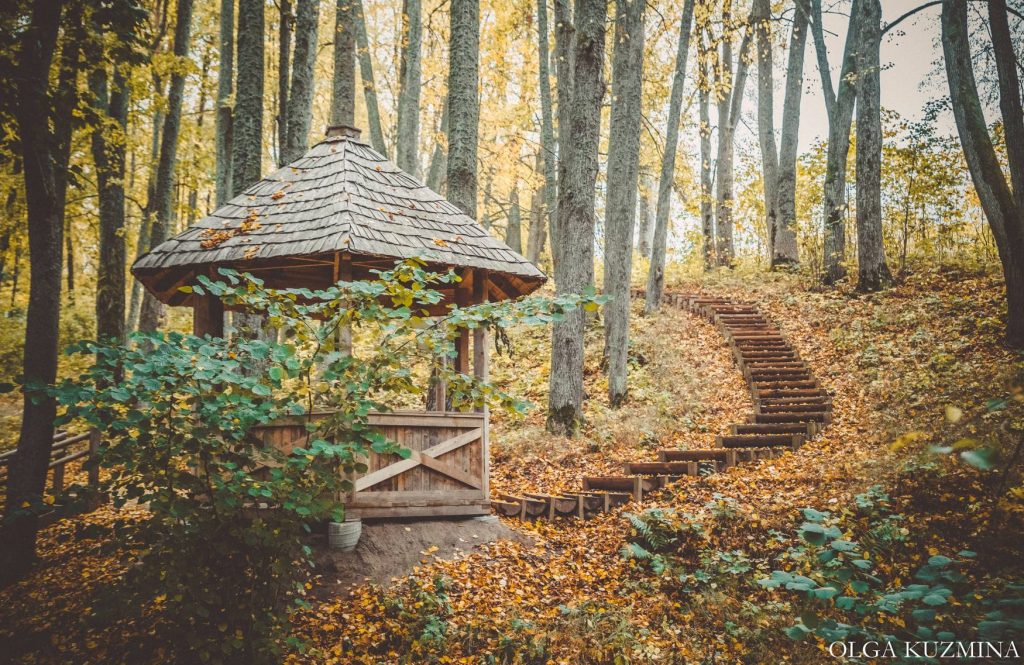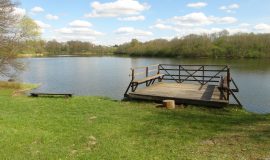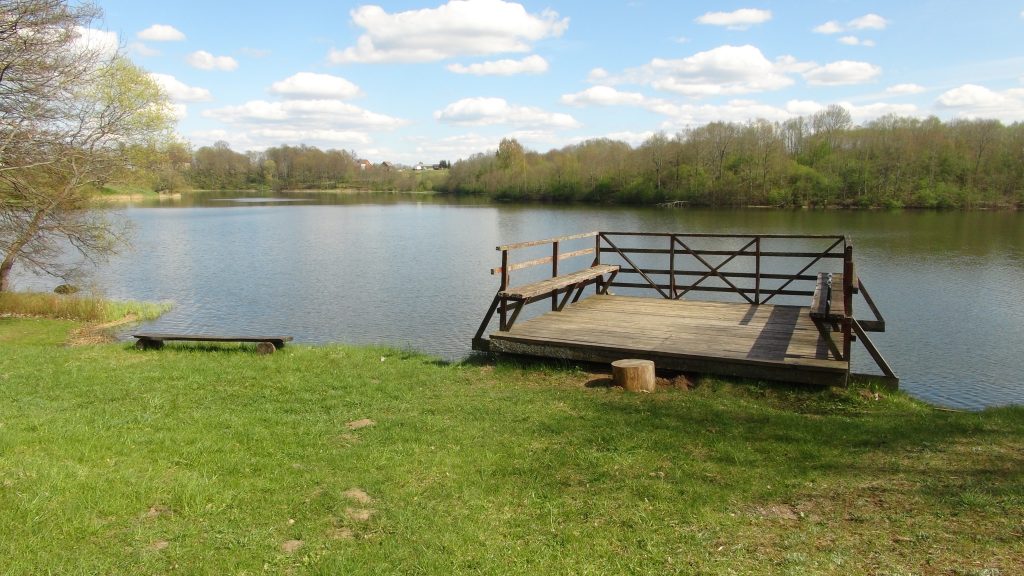Daugavpils Fortress is a unique cultural and historical architectural monument of national importance. Daugavpils Fortress is also considered as the last bastion-type fortress in the world that has been preserved without any significant alterations since the early 19th century.
Culture and history
Daugavpils Fortress Visitors Centre (Water Tower)
Daugavpils Fortress Visitors Centre is established in the building of a former water tower the foundations of which were laid in 1865. Previosly the building was a component part of the fortress water – supply system and also provided water to the fountain in the fortress boulevard.
Vecsaliena (Chervonka) Manor Castle
Vecsaliena (Chervonka) castle was built in 1870 in the Neogothic style and is located in a bend of the park, which was created in the 19th century. This picturesque building with a dynamic and complex composition of the volume is a real fairy-tale castle.
Liksna Manor Park (Liksna paths)
Walking paths was made by the inhabitants of Liksna village in 1999 and from then every year this paths has been extended. There are walking paths, well-equipped recreation places, creative forms of wood and metal, including the Love Tree.
Slutiski Village and Old Believers’ Rural Courtyard
Slutiski Village is authentic inhabited village, where visitors can get acquainted with the unique culture and household of Old Believers in Latgale. Slutiski Village was included in a State protected cultural monument list in 2016.
Rothko Museum
The Rothko Museum in Daugavpils, Latvia, is one of the 21st century’s most ambitious cultural projects in Eastern Europe. Located in the historical artillery arsenal of the Daugavpils Fortress, this multifunctional hub for art, culture and education remains an evolving and inspiring place for creative expression and experience.
“Nicholas Gates – a door to the past” – new historical exposition in Daugavpils Fortress
Daugavpils Fortress Culture and Information Centre presents new historical exposition – “Nicholas Gates – a door to the past”, which is located in Nicholas Gates in Daugavpils Fortress.
Church Hill
Every traveller who wants to be acquainted with Daugavpils should definitely visit the Church Hill that has gathered the churches of four different confessions – Martin Luther Cathedral, Roman Catholic Church of the Blessed Virgin Mary, SS Boris and Gleb Russian Orthodox Cathedral and Church of the Community of Old Believers.
Centre of Technics and Industrial Design “Engineering Arsenal”
Centre of Technics and Industrial Design «Engineering Arsenal» is the largest exhibition of motorised vehicles in the whole Latgale region. It is a unique exhibition space of retro technology and applied design, which is located in the historic 19th-century building of the Daugavpils Fortress.
St. Boriss & Gleb Russian Orthodox Cathedral in Daugavpils
St.Boris and Gleb Orthodox Cathedral was built in 1904-1905 and was consecrated on 12 June 1905. t.Boris and Gleb Cathedral in the sense of the use of numerous decorative elements is recognized as the most gorgeous orthodox cathedral of this region. Its building is justly considered as one of the most spacious, richly decorated and arranged orthodox cathedrals not only in Latgale, but also in whole Latvia.
Daugavpils Martin Luther Cathedral
Martin Luther Cathedral designed by V. Neimanis was built in 1893. The church was made in Neogothic style. It has an asymmetrical planning and one tower. The building was constructed of red bricks.
The Museum of Military Vehicles
2 World War II military equipment private collection is unique in the fact that the objects are found in the former battlefields and skillfully restored. Here you can see Soviet army tanks, battle attack landing car, all-terrain vehicles, and other military vehicles guns and equipment units.
Viewing platform of Martin Luther Cathedral
The tower stands at a height of 5 houses, and the observation deck is located at a height of about 40 m. It offers panorama of the Church hill.
Daugavpils Roman Catholic Church of the Blessed Virgin Mary
Daugavpils Roman Catholic Church of the Blessed Virgin Mary was built in 1905. The church facade with two towers together with the ordently towers is made in the Neobaroque forms, and the Historicist interiors are augmented by a copy of Bartolome Estebam Murillo’s “Immaculate Conception”.
Naujene Local History Museum and Nature Information Centre
The museum expositions and exhibitions reflects nature, history and ethnography of region. Here is exhibited original works of the sculptor Valentina Zeile. Museum offers workshops and educational classes.
Old Believers’ Church of Resurrection, Birth of Mother of God and St. Nicholas in Jaunbuve
Daugavpils first Old Believers’ church is one of the biggest in the whole Latvia. The church was consecrated in 1928 in honor of the birth of Mother of God and St. Nicholas.
The House of Rainis in Berkenele
The childhood of Latvian poet, translator, master of drama, public and political figure Jānis Rainis (1865 – 1929) was spent here, in Berkenele Manor. There is opportunity to see expositions “Rainis and Berkenele”, “Nursery”. Museum offers a wide range of workshops and the opportunity to host seminars.
Latgalian Culinary Heritage Centre “Šmakovka”
The largest Latgalian Culinary Heritage Centre “Shmakovka” in Latvia. The centre invites to listen to a cognitive story about the oldest Latgalian alcoholic beverage – shmakovka that is the culinary heritage of the region.
Roman Catholic Church of the Sacred Heart of Jesus in Liksna
Liksna Church was build in Neo-Gothic style. The building of Catholic Church in Liksna was finished in 1913. Churchs silhouette is the most important landscape dominant of Daugava valley in environs of Kosa Lake.
Daugavpils Lead Shot Factory
Daugavpils Lead Shot Factory is the only one available for tourists ammunition plant in the Baltic States, where is the oldest shot tower in Europe, that still works.
Daugavpils Theatre
The Daugavpils Theatre is one of the oldest professional theatres in Latvia. It is the only professional theatre in Latgale.
Daugavpils Regional Studies and Art Museum
Daugavpils Regional Studies and Art Museum is one of the oldest museums in Latgale, founded in 1938. Located at 8 Rigas Street, in a magnificent building constructed in 1883.
Daugavpils Innovation Centre
Daugavpils Innovation Centre – a new learning environment for everyone, where you can experiment, research, create innovative solutions, develop entrepreneurial abilities, and connect learning content with real life and the digital environment.
Daugavpils Synagogue
Daugavpils synagogue Kadish built in 1850 is located at 38 Cietoksna Street. The Jewish of Daugavpils and Latgale museum is located on the 2nd floor of the synagogue.
Medical exhibition with an exposition of birth control items
Medical exhibition with an exposition of birth control items is a permanent exposition devoted to the history of medicine that is located in Daugavpils Fortress. Four large halls display objects, photographs and documents that tell the story of how people were treated in the last century and before.
The Skrinda family museum
Museum’s permanent exhibition is dedicated to the life and work of first national awakening members in Latvia – Skrinda brothers. There is an opportunity to participate in various thematic programs and local crafts workshops. Here offers the opportunity to taste latgalian traditional food “coma” local bread, honey and herbal tea.
Daugavpils Clay Art Centre
The centre offers the possibility to get acquainted with the cultural heritage of Latgale – ceramics and pottery traditions. This is the only place in Latvia where visitors can see and learn about the hardened Baltic raku ceramics which is being matured in fermented rye-flour liquid.
The Historical Centre of Daugavpils City
The historical centre of Daugavpils city is an architectural heritage of national importance (the construction work was carried out in the 19th century according to the project endorsed in St Petersburg in 1826). The historical centre is the greatest attraction of the city and one of the most successful examples of balancing the aspects of ancient and modern times.
Museum “Jews in Daugavpils and Latgale”
Jewish of Daugavpils and Latgale Museum is located on the 2nd floor of the Daugavpils synagogue. The museum exposition tells about Jewish life and living traditions in Latgale and Daugavpils since 1900. The exposition represents the change in the number of Jews, sibling’s stories in photos, household and religious items as well as a variety of publications: magazines, calendars and books about Jews life in Daugavpils and Latgale.
Exhibition of Retro Cars “RetroGaraž-D”
Different automobile brands are represented in the exhibition – 22 “Moskvich”, 2 “Zhiguli”, “Volga” and “Mercedes” cars. This is probably the largest “Moskvich” collection in the Baltic States.
Leisure Park “Stalkers”
Well-equipped rest park is located in picturesque place on the bank of the Daugava River on the territory of Daugavas Loki Nature Park. It is possible to organize a wide range of activities in the park. There are children’s playgrounds, outdoor grills, tables, terraces, benches etc. Several tourist groups can visit the park at the same time.
Private Collection of Antiques of “Egles” Farm
Private Collection of Antiques of “Egles” Farm There is a private collection of antiques in a log barn of “Egles” farm. Here you can see a variety of ancient farm tools: the centuries-old exhibits and horse harness, and the first mechanized equipment.
“Pie Komendanta” Museum of the World War I
The museum is located in Daugavpils Fortress. Artefacts that are viewable in Museum of the First World War (1914 – 1918) was found in surrounding of Daugavpils. A museum that is dedicated to the World War I time period. A collection of weapons, artillery shells, grenade and household items (e.g. bottles, glasses and other) are displayed. Old postcards and unique photos can also be found in the collection.
Rīgas Street – Walking Street
About half a kilometer long Rīgas Street is the busiest street of the city leading from the Daugavpils railway station to the Daugava River, with a passage through the embankment to the former landing place.
Roman Catholic Church of St. John the Baptist in Viski
Catholic Church in Viski was built in period 1908 – 1925. It is significant national landmark, one of the few sacral buildings in Daugavpils region that was built of abated stones and belongs to one-tower basilica crucifix church type.
Daugavpils Bat Centre
Daugavpils Fortress is a place where the second largest in the Baltic States hibernating bat colony inhabits. The fortress walls with a high humidity, as well as a special microclimate in the fortifications create favorable conditions for dwelling. Exposition of the Daugavpils Bat Centre is located in the lateral room of the Niсholas Gate in Daugavpils Fortress.
St. Peter’s in Chains Roman Catholic Church
Saint Peter’s in Chains Roman Catholic Church is built in 1848–1849, rebuilt in 1924–1934. It has some resemblance to Saint Peter’s Basilica in Vatican.
Ruins of the Dinaburg Castle and Castle Model
In 1275, instead of the Naujene mound, the castle of Dinaburg was built by the Livonian Orden Master Ernest von Racenburg. Nowadays only ruins of the castle remained, but there is a stone model of this castle on the mound. Nearby is located Dinaburg Nature Trail and recreation area “Knights glade”.
Unity House
The dominating structure of the historical centre of the Daugavpils is the Unity House built during the years of the First Republic (22a Rīgas Street).
The promenade on Bruģu Street on the bank of the Daugava River
On the right bank of the Daugava River, in the vicinity of Gayok district the Bruģu Street promenade has been built. It is aimed at giving the streets a new, functional look and meaning. After completion of the Bruģu Street promenade, Daugavpils city acquired a new, facilitated area for strolling and enjoying the splendour of nature.
Markova Mound and Cognitive Trail
In the surroundings of Markova Mound, there is a 1.6 km long Markova cognitive trail, where such objects as Markova Mound, Markova Cemetery, Putānu Streem, Putānu Streem Boulder are located.
Lielais Stropu Lake Promenade
Lielais Stropu Lake – the largest water body in Daugavpils, located 8 km from the city centre, attracts a large number of holidaymakers in the summer season. There is a ~5km long promenade along the shore of the lake. By walking along the promenade from the Central Beach to the left, you can reach the beach “Stropu vilnis”, where the adventure park “Daugavpils Tarzāns” and a camping site are located.
House of Traditions
It is possible to learn about the Latvian folk traditions by working practically, participating in workshops and classes in the House of Traditions. Traditional Latvian festivities are celebrated here, folk craft workshops, exhibitions, training sessions on playing folk musical instruments, seminars on traditional Latvian festivals, games and dances, as well as dance evenings, conversations and discussions on preservation of intangible cultural heritage are held here.
The Centre of Russian Culture (Russian House)
The Centre of Russian Culture offers unique expositions: Old Believers in Latvia, The Orthodox in Latvia, Pictures by Pyotr Khudobchenok, Gzhel Ceramics, Khokhloma Ware, Dinaburg Fortress in the War 1812.
Jezupova (Juzefova) Manor Park
Jezupova (Juzefova) Manor Park was built in the 19th century in Dutch style. Nawadays only a small part of the park, which contains more than 100 different species of plants, has survived.
Daugavpils Belarusian Culture Centre
Daugavpils Belarusian Culture Centre offers the excursion „Belarusian House” for pupils.
Polish Culture Centre in Daugavpils
Polish Culture Centre in Daugavpils popularizes Polish language, the culture, the history and national heritage. The Centre organizes exhibitions, concerts, festivals and other cultural events.
Music Square in Esplanade Rest Park
Music Square in Esplanade Rest Park is a place for rest and walks in Daugavpils. The central theme of the new recreation and walking area is the sounds of music in an urban environment. There are various music instrument in the open air which allow to both hear and feel the music in its various forms. There are 10 different outdoor musical instruments – drums, xylophone, tube bells and other interesting objects.
Daugavpils Palace of Culture
Concert hall of Daugavpils Palace of Culture is one of the biggest concert halls in Latvia with capacity to host events for 1070 persons. The Concert Hall has been awarded with compliance certificate from Association of European Mass Event centres in Baltic States, which proves that the concert hall is able to host the highest quality events.
Memorial sign to the King of Poland Stephen Bathory
In 1582, King of Poland Stephen Bathory gave the Magdeburg law for Daugavpils (Dinaburg). Thus, it opened wider opportunities for the development of the city. The clock, gear wheel and clock hands, which are depicted on the monument, represent the history of Daugavpils (Dinaburg) before and after granting the Magdeburg law and historical titles of the city. The bas-relief of Stephen Batory, his sign facsimile and short explanation is also illustrated on the monument.
Medumi Park and walking trail
In the beginning of the 20th century Lacky, botanical garden manager from St. Petersburg, created a park near to Medumi lake. Now this is a popular place for fishing and relaxation on the beach of Medumi lake. 2 km long trail is located in the park.
Dubrovin Park
The development of the park was actively supported by Pavel Dubrovin (1839–1890), who was the city mayor from 1876 to 1890. The park was named after its creator, and not far from the fountain there is a monument to Pavel Dubrovin.
Monument to Pavel Dubrovin
Monument for park creator and ex-mayor of Daugavpils Pavel Dubrovin (1839-1890) is erected in Dubrovin Park. The monument was made by sculptor from Moscow Alexandr Taratinov.
Vabole Manor Park
The Park was landscaped in a 19th Century in English style by the count Plater-Zyberk. Many historical buildings (part of the old manor and horse stables) remained to this day. There are 21 tree and brush species, pond and equipped recreation area in the park.
Andreja Pumpura Square
In the square it is situated the bust of poet Andrejs Pumpurs, the Russian Orthodox Chapel of Alexander Nevsky, the monument to the innocent victims of the Communist terror.
Vecracina Mound
Located in Vecracina of Naujene parish on the right bank of the River Daugava, 2.5 km to the south of the railway station in Izvalta. The settlement is surrounded by a deep ravine (depth about 18-27 m) from the east and south-east.
Bust of Latvian Poet Andrejs Pumpurs
The poet A. Pumpurs (1841-1902) created epos “Lacplesis” (1888) about the legendary national hero Lacplesis (13th century), the fighter against foreign conquerors that is based on folk tales. The street and the square in the center of Daugavpils, where the bust of the poet is located, have the name of the poet.
Assumption of the Blessed Virgin Mary Orthodox Church in Lipiniski
The church was built in 1906 and was consecrated in 1908. The church was constructed in the form of a cross in Byzantine style and is made of red bricks and has two towers. There are a lot of decorative elements in the facade design.
Central Park
Central park in modern park with numerous flower beds and plants is a real jewel in the heart of the Daugavpils city.
St. Peter and Paul Roman Catholic Church in Jezupova (Juzefova)
The building of Jezupova (Juzefova) St. Peter and Paul Roman Catholic Church was started in 1934 and was finished in 1961. After the building was finished the church was taken from the parish and there was established club. In 1989 the church was returned to the parish.
Zemgale Catholic Church
It was consecrated in 2006. The church is located in the building of the previous estate and in Zemgale station building (1928).
Sundial
Sundial (1910) located in the Daugavpils University public garden.
Silene Roman Catholic Church of the Assumption of the Blessed Virgin Mary
Present-day wooden building of Silene Roman Catholic Church was built in 1913, not far from the burnt down chapel that was built in 19th century. Silene Church is one of the largest wooden churches in Riga’s Metropolis.
Public Garden of Daugavpils University
The features of the square are a small fountain, a bust of the poet Janis Rainis (by I. Folkmanis, 1966) and a Sundial.
Maskovska’s (Moscow) St. Virgin Shelter Orthodox Church
Built and consecrated in 1879. The church’s altar is simple, without ornamentation. Especially expressive is church gates built in Novgorod style and several ancient icons.
The exhibition of “Terra Mariana” album’s facsimile
The exhibition takes place in the lobby on the 2nd floor of Daugavpils University (DU) building, Vienibas iela 13. The album itself is a property of Vatican Library, it was presented to the Pope Leo XIII in 1888 by the inhabitants of the Baltic region as a gift on the 50th anniversary of the Pope’s ordination.
Orthodox Church of St.Peter and Paul in Danisevka
Church is located in a picturesque place Daniševka, near the Lake Lukna. The building was built and consecrated on August 31, 1908. There is a grave of the first pastor of this church – I. Digilev (1869-1933) in the church garden.
Holy Cross Roman Catholic Church in Jaunborne
Built in 1859 at will of Polish landlord Julius Sivickis. It was rebuilt in 1890 and renewed in 1921. There is a cemetery around the church, where are burials of Sivickis family.
Elerne Ascension of Lord Jesus Roman Catholic Church
The building of the Elernes Church was constructed in 1650 by Heinrich Tienen. Until 1761 it served the needs of the Lutheran Church, but later the Lutherans exchanged with Catholics with the Sīkele Church. The architecture of the church, in both volume and details, is in correspondence with other churches that were built in the territory of the Courland Duchy of that time.
Sikele Lutheran Church
It was built in 1819. At first the church belonged to the Catholic community, but it was given back to Lutherans instead of Elerne church in the second half of the 18th century.
Crucifix Way
The largest number of crucifixes in Latvia is located on the territory of the Vabole parish. After the Second World War, many were destroyed – from 44 crucifixes only 29 remained.
“Bunker” Gallery
“Bunker” gallery is located in the basement of an apartment building in the authentic Soviet-era bunker with the heavy original metal door. There are more than 300 exhibits that belongs to different periods of history: the end of the 19th century and the beginning of the 20th century, World War I and World War II, Latvia’s first independence period and Soviet time.
Forstate Heart of Jesus Roman Catholic Church
The church in the urban landscape is distinguished by its pointed tower made in the Gothic style and by light finishing of the facade. In addition, this project combines classical and modern, as the temple of God is located near the cultural and historic wooden building which is typical for Daugavpils.
Grīva Roman Catholic Church of the Holy Mary
Grīva Roman Catholic Church of the Holy Mary was built in 1881 – 1889 and altered in 1935 – 1942. Next to, it a bell tower was built in 1990 (arhitect: Kazimirs Lielausis). Grīva Church is a brick building with Romanesque and Gothic elements in the facade decoration. The most important interior features are the 3 stained glass windows with figural scenes, made at the St. Lucas Workshop in Warshaw in 1889. The pipe organ made at the Krustpils workshop of Friedrich Weissenborn in 1890.
St. Alexander Nevsky Orthodox Church in Daugavpils
The church was consecrated in 1897. The church is a one-story wooden log building that is not covered with boards. The pointed towers with four-sided roof are located above the side entrances on the roofs. The part of the altar roof is decorated with a tower, which hexagonal volume supports the cupola with a cross in the form of an onion.
St. Nichola’s Russian Orthodox Church in Daugavpils
St. Nichola’s Russian Orthodox Church in Daugavpils was built in 1894 and is located near graves. It is built of red bricks; the decorative masonry bands are made in the corners of the building, above the footings and under the roof cornices.
Daugavpils St. Peter and Paul Russian Orthodox Church
Daugavpils St. Peter and Paul Russian Orthodox Church has two towers: a bell tower above the entrance and smaller tower at the east end. The icons date from 1833 up to the earl 20th century, one group of them brought from Moscow.
Dormition Orthodox Church
Dormition Orthodox church was consecrated in 1877. In 1964 The Soviets closed it. Until 1991 there was a library in the church building. In 2007 the first divine service took place in the renovated church.
St. Nicholas Russian Orthodox Church in Griva
St. Nicholas Russian Orthodox Church in Griva was consecrated in 1924. The wooden carvings are the characteristic feature of the church.
Old-believer’s Prayer House in Gajok
Old-believer’s Prayer House of The Annunciation of the Most Holy Mother of God and Nicholas the Wonderwoker in Gajok. Old-believer’s Prayer House in Gajok was consecrated on March 30 in 1886. The church was one of the most beautiful religious buildings in Daugavpils. The hand of a professional is clearly seen in the architectural shapes of the church.
Old Believer’s Prayer House in Griva
The temple was built in the 30s of the 20th century.
Old-believer’s Prayer House in Niderkuni
Old-believer’s Prayer House in Niderkuni was built in 1907, but in 1908 – 1911 work on the interior design was carried out. The parishioners presented icons and books to the new church. The icons painted by Konstantin Pavlov, Vasilij Kirillin, Barbara Kirillina and Leontij Seleznev have remained in the iconostasis till nowadays.
Memorial Place of the 1st Baltic Old-believers Prayer House (1660)
In Daugavpils, at the cross point of Baznicas and Liginisku streets, the memorial place of the first Baltic Old Believer’s prayer house (1660) is located.
Protection Embankment
A unique 6-km long engineering structure along the bank of the Daugava River, which not only protects the city against floods, but also serves as a road.
Ensemble of Administrative Buildings and the Building of the City Classical School
Ensemble of Administrative Buildings and the Building of the City Classical School in Daugavpils designed by A. Y. Shtaubert, a famous Russian architect, the buildings were constructed at the beginning of the 1840s in the classical style.
Art Nouveau buildings
Art Nouveau buildings in Daugavpils located at 41 Saules Street, 55 Saules Street and built at the end of the 19th – the beginning of the 20th century.
Unity Square
Unity Square is the heart of the city where all the greatest events of the city take place. The Square unites the inhabitants of the city during the most significant events.
Daugavpils Railway Station
Daugavpils is a railway hub with 5 railway lines. The present building of the railway station was constructed in 1951.
Sculpture Garden
The Sculpture Garden is decorated with the works of Latvian sculptors and magnificent carpets of flowers.
Daugavpils Water-supply Museum
The museum exposition includes historical documents and photos of Daugavpils water-supply system.
The Stropu Stage
The stage in Stropi is the cultural-historical complex, situated in a scenic place with interesting relief and is the place for carrying out big folklore events, song festivals and performances.
The open-air art work “GHOST OF THE FORTRESS”
The open-air art work “GHOST OF THE FORTRESS” was created in 2017 during the Second International Sculpture Symposium. The main inspiration for the work came from the Daugavpils fortress. For Daugavpils fortress it is ghost of a war horse, because as a war horse, fortifying structures like the one in Daugavpils was once a crucial military instrument that became obsolete as the progress rolled on.
Environment object “Tribute to Rothko”
On 25 September 2016, which was the 113th Mark Rothko’ birthday, near to Mark Rothko Art Centre was opened an environment object “Tribute to Rothko” made by the French artist Patrick Peltier.
Dedication to Rothko Memorial Monument
Dedication to Rothko memorial monument that was created by the artist Romuald Gibovsky, was erected on the picturesque bank of the River Daugava – the source of the brightest impressions of the artist’s childhood.
Memorial to Commemorate Victims of the Genocide against Jews and of Daugavpils Ghetto
The Memorial to commemorate the victims of genocide against Jews and prisoners of the Daugavpils ghetto was opened on 10 November 1991, commemorating the fiftieth anniversary of the beginning of the Holocaust (author of the memorial – sculptor Oleg Marinoha). The memorial consists of a granite stele with the Star of David cut into it and an inscription on Yiddish “To the Memory of the Children of Israel”, with 16 stone steles placed on both sides of it, symbolically reminding of the memory of the Holocaust victims from various European states.
The memorial stone “In memory of Daugavpils ghetto prisoners”
On 6 September 2015 in the place of former Daugavpils ghetto, next to Daugavgrīva Prison the Jewish community of Daugavpils unveiled a monument with an inscription in English, Latvian, Russian and Hebrew: “In memory of ghetto prisoners. From July 15, 1941 to May 1, 1942 Daugavpils Jewish ghetto was located here.”
Memorial to the Victims of Nazism
From July 1941 to the end of 1943 in the Mežciems (historical name – Poguļanka) Forest Jews, taken from Daugavpils ghetto at various times, were shot here. The exact number of victims is unknown. In 1960 a memorial (sculptor Harijs Sprincis, architect Zigurds Ābelīte) to the victims of Nazism was unveiled in the Mežciems Forest; however, the most part of the monument was destroyed in the 1990s. On 9 July 1989 Jewish activists from Daugavpils reinterred the remains that had been found at the end of the 1980s in Mežciems in separate pits. In 2007 the Council of Jewish Communities of Latvia placed on the site two black granite plaques with an inscription in Latvian, Russian, English and Hebrew: “The remains of prisoners of the Daugavpils ghetto are buried here”.
Monument to the Victims of Action of 8–9 November 1941
In total approximately 15 000 to 20 000 Jews were placed in the Daugavpils ghetto, of which less than 100 persons survived. On 8 – 9 November 1941, as the result of regular selection in the ghetto, 1134 Jews, children among them, were sent to Mežciems and shot. In 1967, on the site of mass murder, close to the Mežciems Station a memorial obelisk was erected. In 1974 a memorial stone was placed, its inscription in Russian sates: “In this place on 8–9.11 1941 German fascists shot 2000 civilians – children and adults”.
Holocaust Memorial Place in Railwaymen’s Garden
The Nazi troops entered Daugavpils on 6 June 1941 and already on the first days of occupation launched the campaign to exterminate the Jews of Daugavpils. Until 7 July 1125 Jews were arrested and taken to the prison, they later were shot in the Railwaymen’s Garden. During the Soviet period a granite stele on a concrete base was erected here, it bears the inscription “Here the fighters, commanders of the Soviet Army, tortured to death by German–fascist invaders in 1941–1945 are buried. Eternal glory to those who perished.” In 2007 the Council of Jewish Communities of Latvia placed a memorial sign – two black granite plaques with the Stars of David and an inscription in Latvian, Russian, English and Yiddish: “In July 1941, the Nazis executed here more than 1,000 of Daugavpils Jews”.
Holocaust Memorial Place in the Daugavpils Communal Cemetery
A part of Daugavpils ghetto prisoners, who were shot in the Mežciems Forest, have been reinterred in the Daugavpils Communal Cemetery, their remains were found in the 1950s. During the first post–war years the reinterment site was in the Old Jewish Cemetery, but in the 1970s, when the Cemetery was liquidated, the monument was moved to the Communal Cemetery. There is an inscription in Russian and Yiddish on the monument: “Here Jewish families rest, shot by Hitler’s executioners in 1941–1945”.
Memorial Stone at the Place of the Old Jewish Cemetery
The memorial stone by artist Juris Pundurs was erected on September 12, 2013, in Aizpilsetas park close to the Gubisces lake (behind Daugavpils 15th Secondary School), in the place where once was the old Jewish cemetery.
Memorial Stone to the Innocent Victims of Red Terror
Memorial Stone to the Innocent Victims of Red Terror was erected in 2004 (sculptor is J. Volkova).
Memorial place of graves of soldiers of Polish army of the 1st Legion Regiment
Graves of the soldiers of the 1st Legion Regiment of Polish army in Slobudka, near Satiksmes street were the biggest ones in Latvia of Polish soldiers, who fell in Latvian fight for freedom in 1919 -1920, a cemetery, where 500 soldiers were buried. On June 22 in 1928 Latvian President Gustav Zemgals opened a monument at this cemetery.
Warrior’s Cemetery of Latvian Army Soldiers Killed in Latvia Liberty Battles
The mass grave of fallen in Latgalian battlefront in 1920 Latvian army soldiers of Latvian fight for freedom is located in Daugavpils Lutheran cemetery. At this place on June 22 in 1928, the President Gustav Zemgals opened a granite monument, which was created by architect Alexander Birzenieks.
Graves of soldiers of Polish army fallen in Latvian fight for freedom at Daugavpils Catholic cemetery
At the right side of Daugavpils Catholic cemetery, the graves of Polish army soldiers are marked with a marble plate and a cross. There is an inscription in Polish on a tomb plate: “Tomb of the unknown soldier”. On January 21 in 1920 Polish soldiers from Daugavpils Polish military hospital 101 (Warsaw Street) were buried there.
The Memorial in honour of the fallen German soldiers of the World War II
In Daugavpils you can visit the biggest reconstructed German soldiers’ cemetery in Eastern Latvia in honour of the fallen in World War II, where 3000 soldiers are buried and among them also Latvians. Graveyard is denoted with groups of crosses.
The Memorial Plaque to the Count Leon Plater
Daugavpils Fortress was an imprisonment place of downtrodden participants of Polish uprising where leader of the uprising Leon Plater was sentenced to death penalty.
Memorable place of Count Leon Plater at Daugavpils Catholic cemetery
The memorial place of Leon Plater is set at Daugavpils Catholic cemetery. The black granite plate, which is decorated with the inscription: “To count Leon Broel Plater – the organizer of Polish uprising (killed on June 9 in 1863)” is erected there. Originally, the plate was erected on June 9 in 1923, but renewed in 2002.
A Memorial Plaque to Rabbi Abraham Isaac Kook
The Memorial Plaque to Rabbi Abraham Isaac Kook (1865 – 1935) was opened on March 7, 2013 on the wall of the Daugavpils Synagogue. Rabbi Abraham Isaac. He was the outstanding Jewish religious thinker and public figure, the first Ashkenazi Chief Rabbi of the land of Israel.
The bust of poet Rainis
Daugavpils is the poet Rainis’ first childhood city. On the front square of Daugavpils University there is the poet’s bust sculpture made by sculptor Indulis Folkmanis (1966).
A Memorial Plaque to Gzegoz Fitelberg
Gzegoz Fitelberg (1879 – 1953) was born in Dinaburg (Daugavpils) in Jewish-Polish family.
The memorial plaque of Andrejs Shvirksts
Andrejs Shvirksts (1897 – 1955) was Local government officer (since 1928 till 1934 – the Chairman of the Daugavpils district, since 1934 till 1938 – the senior of the Daugavpils district, sine 1938 till 1940 – mayor of Daugavpils), Public figure (since 1938 till 1940 – Chairman of the Association of Latvians of Daugavpils).
The Grave of Education Officer Valerija Seile (1891-1970)
Valerija Seile (1891-1970) was an educator, publicist, bibliographer. She was the first Constituent Assembly Member, the director of Daugavpils Teacher Institute.
The Grave of Latvian Poet Rainis Father Krishjanis Pliekshan
The father of the poet Rainis Krishjanis Pliekshan leased several manor in the nowadays Daugavpils region territory – in Birkineli, Randene and in Vasiljovo. He died in 1891 and was buried in Daugavpils Lutheran cemetery.
Latvian Culture Centre (Concert Hall in Unity House)
Latvian Culture Centre is situated in premises of Unity House, which is the leading culture organisation focusing on preservation and popularisation of Latvian culture in Daugavpils.
Red Bricks Buildings in Daugavpils
Daugavpils is exceptionally rich in red brick buildings. The shape-forming techniques typical of eclecticism that were applied in the facades of these buildings even many decades later make one appreciate and admire the striking accuracy of detail.
Family House of the Actor Solomon Mikhoels
There is house number 4 on Mihoelsa Street at Daugavpils, where the great actor Solomon Mikhoels was born in 1890. This outstanding person is rightly considered the legend of the 20th century theatre.
St. Alexander Nevsky Russian Orthodox Chapel
St. Alexander Nevsky Russian Orthodox Chapel was consecrated in 2004. Located in A. Pumpurs public garden (20 Saules Street) on the former site of St. Alexander Nevsky Cathedral (1864–1961). The chapel is a memorial structure that has a symbolic meaning, serving as a reminder of the demolished cathedral.
Monument to the Suffered Inhabitants of Kalupe and Victims of the 20th Century
Three stone composition marks in details the Revolution of 1905, the wars and the experienced pain of export, as well as people’s experienced sufferings in Kalupe.
The Memorial Place of the Former House of Rainis Parents in Randene
Father of Rainis Krishjanis Pliekshan rented Randene from 1869 till 1972. House was destroyed during the Second World War – тow at the place of the former house you can see the memorial sign.
The memorial stone at the place of the former Janis Rainis parent’s house in Vasilova
The memorial stone is set in Vasilova, on the left side of the highway Daugavpils-Rezekne, at the place where Vasilova halfmanor is located. The father of Janis Rainis Krisjanis Pliekshan rented the halfmanor in Vasilova since 1981.
Memorial Place to Victims of Genocide – to the Shot Jews in Viski and Dagda
The mass murder place of where Jews from Viski and Dagda is located in Klana Viski, Viski parish. In 2001 the memorial place was built and a small granite stone was placed here.
The mark of the most southern point of Latvia “Saules puke”
Sculptor Vilnis Titans created four granite sculptures and placed them in the most remote locations in Latvia within the project “Latvia in the Sun’s Sign”. “Saules puķe” denotes the farthest southern point.
The Monument to the Polish Soldiers who were killed in Latvian War for Freedom (1918-1920)
In Catholic cemetery in Viski, near the entrance on the left side, there is a mass grave of 20 soldiers of the I and V regiment of the I Legion, who fell in the battle near Vishki and Dubna.
The Grave of the Teacher of Janis Rainis Gustav Bazeners
German language teacher of famous Latvian poet Janis Rainis – Gustav Bazeners (1827-1883), who worked at the German school in Griva, was buried in Berkeneles Lutheran Cemetery.
Grave of Birkineli Estate Owner Vidzeme Landmarshal Hamilkar fon Felkerzam
The former owner of Birkineli estate Vidzeme landmarshal Hamilkar von Felkerzam is buried at the Lutheran cemetery in Birkineli.
Cemetary of Polish Army Soldiers Killed in Latvia Liberty Battles (1918-1920) in Laucese
There are two Polish soldiers’ burial places at the Catholic cemetery in Laucese. The Polish soldiers who have fallen on September 27 and 28 in 1919 and January 1920 in the battles for Griva bridge are buried there.
Monument to the Fallen National Partisans
The monument to 5 fallen national partisans is erected at Misteli cemetery. It was designed by the sculptor I. Folkmanis.
Memorial Stone to Emilia Plater
The memorial sign is located in Liksna Trails, in the beginning of Emilia Plater path. Emilia Plater (1806 – 1831) is Poland and Lithuanian national hero, who lived in Liksna estate since 1815. She led a patriot combat unit in Latgale and Lithuania during the time of Polish uprising, which happened in 1830-1831.
Memorable Place of Vecpils Cemetery
There are three white crosses in memory of the Old Vecpils Cemetery that was destroyed in 1986 because of the planned construction of the Daugavpils HES.
The Medieval Cemetery of Slutiski and Ancient Settlement
There is a memorial sign on the side of Slutišķi village, which testifies that there was a Slutišķis medieval graveyard (15th-17th centuries).
Memorial stone for writer and ornithologist Karlis Grigulis
The well-known ornithologist and a children’s writer K. Grigulis (1884 – 1972) was born in Stumpuri of Saliena parish where he spent his childhood. The stone was erected in 1994.
The Jewish Cemetery in Viski
The cemetery started at the beginning of the 19th century. It was used also by Somerset (now Aglona) Jews. The oldest gravestones are stone steles at the cemetery that date back to the 50-90s of the 19th century. Most of the monuments are well preserved.
Counts Engelhardt Family Cemetery
It is located near the former manor castle Sengeida, it was built by count Eugene von Engelhart. In 1996-1997 cemetery was restored and cleaned up by old baron’s grandson, Baron Sigvard von Engelhart.
Cemetary of Polish Army Soldiers Killed in Latvia Liberty Battles (1918-1920) in Jankiski
The white concrete cross with a black granite plate and the inscription in Latvian “The cemetery of Polish soldiers fallen for Latvian independence in 1919-1920” is erected here.
Grave steles at Old Believer’s Cemetery in Krivosejeva
Near Old Believer’s prayer house, there are two Old Believer’s cemeteries, where it is possible to observe the steles of the 19th century.
Tombstone at Moscow (Maskovska) cemetery
In the vicinity of (Maskovska) Orthodox Church, on cemetery, there is a gray granite monument in the form of a phallus. Barely visible inscription: “devica” (virgin) is buried there and the years of her life (1864-1884), can be seen on the granite base.
Jaunborne chapel (crucifix)
There is a bricks chapel in Jaunborne, with a niche, in which there is the Virgin Mary’s permanent assistant painting in a wooden frame.
St. George Roman Catholic Church in Ambeli
Catholic church in Ambeļi displays typical use of local traditions of wood-building of 18th-19th centuries in sacral architecture, its structure represents work of professional painting and sculpture experts of baroque period.
Blessed Jesus’ Heart Roman Catholic Church in Demene
The construction of the Demene Church was started in 1932, but the Second World War stopped this plans. During the Soviet times here was a place of entertainment. Sacral meaning this building regained in the 80’s, but fully completed and consecrated in Church was only in 1992.
St. Ilija Orthodox Church in Malinova
The current St. Ilija Orthodox Church in Malinova is a rebuilt priest’s house. In 2010, the Culture House, located on the site of the former church, was burned down, now on this site new Orthodox Church is being restored.
Old Believers Chapel in Rubeniski
The chapel is build in 1907. Chapel has repeatedly lost its sacred meaning, but since 2003, the it has been repaired with the help of renewed parish. Local residents and Old Believer communities of Latvia help the church.
Old-believer’s Chapel in Bondariski
Old-believer’s Chapel in Bondariski was built between 1920 and 1930. The volume composition of the building is very simple: a single volume with a gable roof, a rectangular bell tower that “grows” from the roof and is covered with four-sided tent. The building is preserved in the authentic form.
Krivosejeva Old Believers Chapel
Krivosejeva Old Believers Chapel is built in the beginning of the 20th century, around 1906. The roof was erected in 1926. The chapel are built in the log house technique and clad with horizontally painted boards. Alongside the temple there is an Old Believers’ Cemetery, where you can see ancient unique grave monuments – steles.
Old-believer’s Chapel in Ascuki
The present chapel was built in 1910 at the place of the former chapel. After the Direktive “On Toleration” in 1905, Old Believers were allowed to build religious buildings and to build up their cemeteries.
Protection of the Holy Virgin Chapel in Danisevka
The chapel that has been preserved till nowadays, probably was built after 1905. The only decorative accent is a small diamond-shaped window over the entrance. The common image of the chapel has been created thanks to the precisely found proportions of shapes.
St. Peter and Paul Roman Catholic Church in Laucese
Catholic Church is wooden building built in period from 1921 till 1923 in place of old wooden church (1797), which burnt down in 1920. This was one of the oldest churches in Zemgale owned by landlords Ludvinghauzens-Volfs.
Egypt’s Lutheran Parish Church
The church was built in Vilkumiests by landlord A.Oettingen in 1823. In 1863 the church’s tower was built. During World War I it was destroyed, and during World War II – absolutely vandalized.
Berkenele (Birkeneli) Lutheran Church
Church building (1830) was built for Friedrich von Klopmann’s funds. The tower’s peak is decorated with an ornamental windshield, but the church has not been functioning for many decades since the Soviets have seized it.
Didrihstein (Laucesa) Manor House
The manor house was built of red bricks with a tower in the Neogothic style. Victoria Plater-Zyberk was the owner of the estate in the early 20th century. It used to be an elementary school of Laucese.
Maskovska Mound
It is situated 0,5 km from Maskovska Orthodox Church in the direction of Ambeli. There is a picturesque view on the Viski Lake.
St.Virgin Mary’s Roman Catholic Church in Nicgale
Stone building of the church was built in the Neo-Gothic style by order from Count Henrih Plater-Zyberk in 1863.
St.Family’s Roman Catholic Church in Aukskalne
Church is 18.5m long and 8.5m wide wooden building covered with bricks. Church was consecrated in 1947. Previous church burnt down in 1944, and most of building materials for the new church was donated by parish members.
Old-believer’s Chapel in Panteliski (Briveri)
The chapel was built in the late 19th century. It was made of logs and is covered with horizontal boards. There is a high bell tower covered with the unusual four-sided roof. The windows are decorated with jamb, which is ornamented with woodcuts.
Holy Virgin’s Old Believer Chapel in Voitiski
The Old Believer community in the village of Voitiski was founded in 1740. The first chapel was a wooden blockhouse, without a footing, with a straw roof. Срapel suffered from fires several times, so in 1979 it was decided to build a stone chapel.
The Charnel House of Brigene Manor House
Тear the former complex of Brigene manor where is situated one of the most beautiful national landmarks in Daugavpils district – a mausoleum that was built by order of landlord Max von Engelhardt in honour of his deceased wife Dorothea von Engelhardt (1862 – 1898).
Russian Orthodox Church of George the Victorious in Januciems (Fabijanova)
It was build thanks to August Pfug project and was consecrated in 1878. The building is made of chipped stones with a filling of a splinter. The corners and the edges of the church are made of red bricks, produced in the Kalkuni brick factory.
Lutheran Church in Demene
The church was built in 1895–1896. The project author is the architect Wilhelm Neumann. The church is a small, one-volume hall-type building with one-tower facade. The building has a gable roof. Now, the building is laid up and is not used.
Kalupe Sacrament Roman Catholic Church of the Holy Altar
The church was built from red bricks in the period from 1861 to 1882. It has cross-shaped form without towers.
St. Michael’s Archangel Roman Catholic Church in Svente
In 1800 landlord Casimir Plater-Zyberk in Svente built stone church in honor of the Trinity. Sacral building was consecrated in honor of Michael Archangel.
Medumi St. John the Baptist Roman Catholic Church
The church was built in the period from 1933 till 1935 according to the project of architect Pavlov under the supervision of J. Klonis at the expenses of the parish.
St. Anthony’s Roman Catholic Church in Sprukti
St. Anthony’s Roman Catholic Church in Sprukti was built of cement bricks at the expenses of the parish and the bishop in 1933 – 1938.
Jesus’ Heart Catholic Chapel in Dubna (Varsavena)
Chapel was built in 1800 as a wooden octagonal building with an extension of the altar part. This is the only sacred building of this type in the Daugavpils district.
St. John the Baptist Orthodox Church in Saliena (Tartaks)
Saliena Church was built in 1894 from abated rocks and it had brick lining inside. Church was consecrated in 1895.
Skrudaliena Orthodox Church of the Assumption of the Blessed Virgin Mary
In 1862 in Skrudaliena was built new wooden church that became the parish church in 1872, as a new belfry and cupola, as well as an iron roof was built up.
Old-believer’s Chapel in Korolevscina
Chapel was built in 1918. Later it was rebuilt – as a result new forms are similar to the motifs of the Protestant churches, and they were probably borrowed from the surrounding cultural environment in Latgale and testify the process of the mutual influence between the two cultures.
Old-believer’s Chapel in Krivani
The Chapel was built in the 20th century. The building has one tower and several windows of different sizes with decorative shutters.
Old Believer’s Chapel in Medumi
The available sources indicate different dates of the prayer house building – in the range from the early 20th century until 1940. The chapel is interesting because it gives the idea of how the religious building of Old Believers looked till 1905, at that time, when they were not allowed to give a recognizable form to their churches.
Lasini (Lasenbeka) Mound
It is located on the left ancient bank of the river Daugava near Daugavpils. It is partially damaged by the war trenches. The goods for fishing network, the handmade dish fragments and other antiques were found in cultural layer. It was inhabited from the first millennium BC till the first millennium AD.
Robeznieki Mound
It is a new-opened mound (1998) and is located near Belarus border. It is visually impressive and well-preserved. The flick ceramics is found in the cultural layer. It was inhabited from the end of the first millennium BC till the middle of the first millennium AD.
Zabornaja (Podgurje) Mound
It is located between Zabornaja and Podgurji. People also call it Napoleon redoubt. In 1812 according to the order, the guns of the French army were placed on the mound to repeal attacks of the Russian army.
Lielborne Manor and Park
Lielborne Manor is the only manor complex in the territory of the Nature Park „Daugavas loki“. There is the old castle, probably built in the 18th century, as well as the new castle built in the classical style in the first half of the 19th century.
Tabore Manor
Manor was built in the second half of the 19th century (possibly in 1875). During World War I, the manor was severely damaged. In the Soviet era, there was Tabore’s eight-year school, but until 2016 Tabore Elementary School was located in the building.
Grain Flourmill
It is located in the center of Vabole near Skrinda family museum. The workers of Skrinda family museum in the flourmill present baking traditions in Latgale.
Kalkune Manor Castle
The manor castle was built in 1890-1892 according to project of the well-known architect V. Neiman. The castle itself is asymmetrical, with towers, turrets and roof constructions its leaves quite a picturesque impression. The manor house is abandoned and not inhabited.
The Place of Liksna Manor
Liksna manor house was built in 1771 in the baroque style. Now you can see only fragments of ruins.
Brunenes (Brunu) Manor Buildings
Stables, 2 stone buildings and manor house remained here from 19th century. Before the agrarian reform of 1920, the manor belonged to the family ob Liveni barons, but later in the manor house was located school, local store and apartments.
Vabole Manor Buildings
Count Boleslaw Plater-Zyberk began the building of the estate in the early 19th century. The barn, the manager’s house and the stables have remained till nowadays. In the former stabler building there is the Vabole Secondary School.
St.Nichola’s Russian Orthodox Church in Daugavpils
It was built in 1894 and is located near graves. It is built of red bricks; the decorative masonry bands are made in the corners of the building, above the footings and under the roof cornices. A semi-circular-shaped sheet metal roof is constructed above the entrance door, where there is also a small round window with St. Nicholas painting in the center of it.
Ilgas Manor Castle
Designed by architect Wilhelm Neimann, the building was constructed in the second half of 19 c. as hunting palace of manor Ilgas.
Monument to the fallen in Afghanistan War
The monument was unveiled in 2017 in Jātnieku Street Square. The monument commemorates those who died in Afghanistan War.
The Monument to the 10th Aizpute Infantry Regiment of Zemgale Division soldiers fallen in the Latvian War of Independence
On November 14, 1924, in the garden of the Daugavpils Fortress, a monument of remembrance to 44 soldiers of the 10th Aizpute Infantry Regiment of Zemgale Division, who died in the Latvian War of Independence, was unveiled. During the Soviet period the monument was destroyed. On 2017 the monument has been restored to its original state. With an official opening ceremony the restored monument was unveiled on November 14, 2017.
“I Love Daugavpils” an open-air art object
An art object “I Love Daugavpils” is installed in the Daugavpils city centre on the square near the Saint Peter’s in Chains Roman Catholic Church.
ANCIENT CRAFT WORKSHOP “KLĒTS”
The ancient craft workshop “Klēts” has been established in the House of Rainis in Berkenele. On the first floor of the building there is an exposition of various ancient crafts and a multifunctional room for organizing various events. The attic is divided into two parts – one of them is an exhibition hall, but in the smallest part of the attic there is a heated room – a workshop, where in summer and winter craftsmen can work, but visitors can learn various skills of ancient crafts.
Sightseeing tour in Daugavpils Fortress on electric bus
The creators of the Museum of the World War I “Pie Komendanta” offer sightseeing tours in Daugavpils Fortress on an electric bus. During the trip, guests and residents of the city will be introduced to the most interesting and significant objects of Daugavpils Fortress and their history.
Bebrene Manor Complex
The ensemble of Bebrene manor is one of the few in Selonia, where all the 19th century manor houses’ building elements have been fully preserved – manor house, auxiliary buildings, park with gates and fence.
Dviete Manor Complex
The Dviete Manor Complex was built in the 19th century and belonged to the Plater-Zyberg family.
Bebrene mil
Just next to the Bebrene Manor and its wall, there is a mill building with a miller’s residential house.
Antique storage “Sēļu istaba”
The storage of antique things has been created over many years, collecting and summarizing the cultural and historical heritage of Selonia and Ilukste.
The private collection of First World War heritage and local history
The family of Stikani is engaged in collecting historical artifacts. A collection of World War I and World War II artefacts has been created.
Art object “DAUGAVPILS”
An environmental object has been installed in Daugavpils near the place where Laucesa River enters Daugava River – large-format letters that form the inscription “DAUGAVPILS”.
Fortress promenade
The total length of the promenade is around 1 kilometre, it goes on the upper level of the protection dam around the fortress. The fortress promenade is a great place for leisurely walks, to view fortress fortifications on both banks of the River Daugava, as well as to enjoy sunsets and slow flow of the river.
Šlosbergas (Pilskalnes) muižas vārti
The gates of Šlosberga (Pilskalne) Manor (1918) are the only historical remnants of the Plater-Zībergs manor. Pilskalne Park also features a monument dedicated to the countess’s dog (1892–1898).
The Сentrу of the outstanding Latvian writer Rainis
The Rainis Centre is a new cultural place in the vicinity of Griva, which operates under the auspices of the Daugavpils Regional Studies and Art Museum, offering Daugavpils residents and city guests to get to know the history, cultural heritage and notable personalities of the left bank of the Daugava.
Salon Antique “Housevintage”
The salon offers to view and purchase historical furniture, dishes, clocks a.o. interior objects from the late 19th and early 20th century.
Exposition of a beaver
In the information center of the Dviete floodplain “Gulbji” the exposition of the symbol of Bebrene and an inhabitant of the Dviete floodplain has been created.
Dviete Valley Information Centre “Gulbji”
In the summer of 2008, in the nature park „Dvietes paliene” on the Birds’ Island (Putnu Sala) in Bebrene parish was created the Dviete Valley Information centre “Gulbji”.
First World War Museum
The First World War has left long-lasting scars not only in people’s destinies and hearts, but also in a large territory of present-day Latvia and Lithuania, where the so-called fronts were located for several years, including the “Life and Death” line. A complex system of fortifications with ditches, trenches and bunkers was built on both sides of the front line.
The open-storage chamber for contemporary ceramics
The 7th bastion casemate of the Daugavpils Fortress is officially available in its new function – as an open-storage chamber for contemporary ceramics from the Rothko Museum collection. The new open-storage chamber displays over a hundred artworks by artists from 40 countries.
Sudmali Mound
The mound was registred the first in 1882 by A.Bilensteins. In 1926 E. Brastins published the description of the mound.
Ilukste Lutheran church
The beginnings of the Ilukste Lutheran church can be traced back to the 16th century. Selonia was a Lutheran land at that time.
Jaunsvente Manor Park
Jaunsvente park was built in the end of 19th century. Park’s area is 5.22 hectares and there are 27 different species of trees.
Subate Lake Park
Subate Lake Park is a favorite recreation place of inhabitants of Subate and guests during the summer season.


